i 2022 RANGER EV INTL/MD Owner's Manual

|
| 2022 Owner’s Manual |
| RANGER EV |
The Owner's Manual for this vehicle contains warnings, instructions and other information you must read and fully understand before safely riding or performing maintenance on this vehicle. Always follow the warnings and instructions in Owner's Manual.
Click the link above for the Table Of Contents, or download a full PDF of the Owner Manual in the Owner Support area of Polaris.com.

|
| 2022 Owner’s Manual |
| RANGER EV |
Unless noted, trademarks are the property of Polaris Industries Inc.
Recreational Off-Highway Vehicle Association® and ROHVA® are registered trademarks of Recreational Off-Highway Vehicle Association. Tread Lightly℠ is a service mark of the United States Department of Agriculture. BatteryMINDer® is a registered trademark of VDC Electronics Inc. Loctite® is a registered trademark of Henkel Corporation. NYOGEL® is a registered trademark of Nye Lubricants, Inc. WD-40® is registered to WD-40 Manufacturing Company. QR Code® is a registered trademark of DENSO WAVE INCORPORATED. Maxxis® is a registered trademark of Cheng Shin Rubber Ind. Co., Ltd. OSHA® is a registered trademark of the Occupational Safety and Health Administration, U.S. Department of Labor. Apple® and App Store® are registered trademarks of Apple Inc. Google Play® is a registered trademark of Google LLC. MACPHERSON RIDE® is a registered trademark of Aftermarket Auto Parts Alliance, Inc. Carlisle® is a registered trademark of CARLISLE INTANGIBLE, LLC.
Copyright 2021 Polaris Industries Inc. All information contained within this publication is based on the latest product information at the time of publication. Due to constant improvements in the design and quality of production components, some minor discrepancies may result between the actual vehicle and the information presented in this publication. Depictions and/or procedures in this publication are intended for reference use only. No liability can be accepted for omissions or inaccuracies. Any reprinting or reuse of the depictions and/or procedures contained within, whether whole or in part, is expressly prohibited.
The original instructions for this vehicle are in English. Other languages are provided as translations of the original instructions.
Printed in Czech Republic
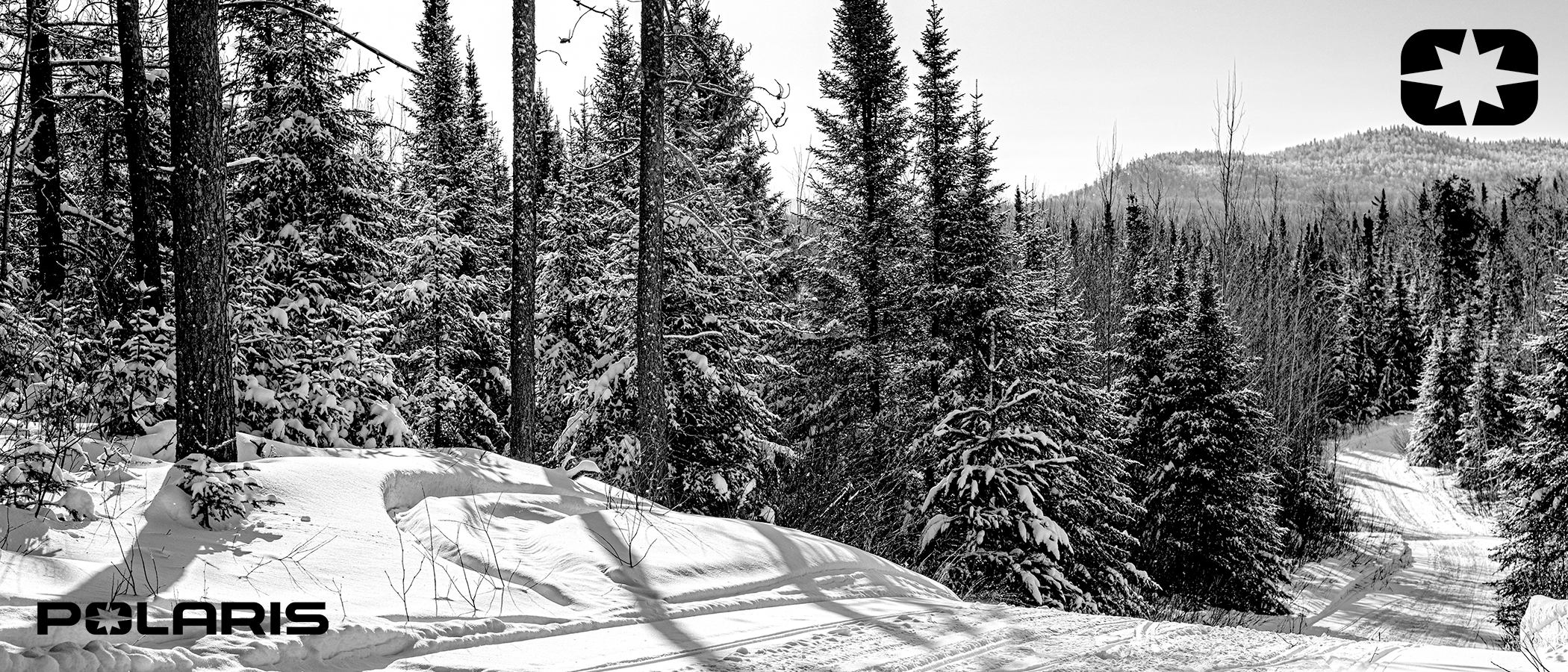
Thank you for purchasing a POLARIS vehicle, and welcome to our world-wide family of POLARIS enthusiasts. Be sure to visit us online at www.polaris.com for the latest news, new product introductions, upcoming events, career opportunities and more.
Here at POLARIS we proudly produce an exciting line of utility and recreational products. We believe POLARIS sets a standard of excellence for all utility and recreational vehicles manufactured in the world today. Many years of experience have gone into the engineering, design, and development of your POLARIS vehicle, making it the finest machine we’ve ever produced.
For safe and enjoyable operation of your vehicle, be sure to follow the instructions and recommendations in this owner’s manual. Your manual contains instructions for minor maintenance, but information about major repairs is outlined in the POLARIS Service Manual and can be performed by a factory certified Master Service Dealer (MSD) technician.
Your POLARIS dealer knows your vehicle best and is interested in your total satisfaction. Your POLARIS dealership can perform all of your service needs during and after the warranty period.
For the most up-to-date owner’s manual visit
https://www.polaris.com/en-us/owners-manuals.
This POLARIS vehicle is an off-road vehicle. Familiarize yourself with all laws and regulations concerning the operation of this vehicle in your area.
Failure to heed the warnings and safety precautions contained in this manual can result in severe injury or death. Your POLARIS vehicle is not a toy and can be hazardous to operate. This vehicle handles differently than cars, trucks or other off-road vehicles. A collision or rollover can occur quickly, even during routine maneuvers like turning, or driving on hills or over obstacles, if you fail to take proper precautions.
Read this owner’s manual and review the safety DVD that came with your vehicle. A free extra copy of the DVD can be obtained by contacting your local POLARIS dealer. Understand all safety warnings, precautions and operating procedures before operating the vehicle. Keep this manual with the vehicle.
Never operate this vehicle without proper instruction. Take an authorized training course. Visit www.rohva.org or call +1 866-267-2751.
This vehicle is an ADULT VEHICLE ONLY. You MUST be at least age 16 and have a valid driver’s license to operate this vehicle.
Always keep hands, feet and all other body parts inside the vehicle at all times.
Always wear a helmet, eye protection, gloves, long-sleeve shirt, long pants and over-the-ankle boots.
Never use this vehicle with drugs or alcohol, as these conditions impair judgment and reduce operator reaction time.
Complete the New Operator Driving Procedures outlined in this manual. Never allow a guest to operate this vehicle until the guest has completed the New Operator Driving Procedures.
Never permit a guest to operate this vehicle unless the guest has reviewed the owner’s manual and all safety labels and has completed a safety training
The following signal words and symbols appear throughout this manual and on your vehicle. Your safety is involved when these words and symbols are used. Become familiar with their meanings before reading the manual.
DANGER indicates a hazardous situation which, if not avoided, WILL result in death or serious injury.
WARNING indicates a hazardous situation which, if not avoided, COULD result in death or serious injury.
CAUTION indicates a hazardous situation which, if not avoided, COULD result in minor to moderate injury.
NOTICE provides key information by clarifying instructions.
IMPORTANT provides key reminders during disassembly, assembly, and inspection of components.
The Prohibition Safety Sign indicates an action NOT to take in order to avoid a hazard.

The Mandatory Action Sign indicates an action that NEEDS to be taken to avoid a hazard.

Some Polaris vehicles come equipped with a near-field communication (NFC) chip. The NFC chip is embedded in the Polaris emblem located at the front of the vehicle and seamlessly connects you to a digital platform of vehicle information and tools. See your dealer for more information.
On models equipped with NFC, place your smartphone directly over the Polaris emblem to do the following:
View vehicle-specific information
Access your Polaris Garage
Download and view the owner’s manual
View accessory instructions
Watch how-to videos
Access warranty information
Check for service notifications

Additional NFC features are available when using the Ride Command mobile app. To access these features, do the following:
Download the Ride Command mobile app from the Apple App Store® or Google Play® store.
Create or log in to an existing account.
From the Ride Command mobile app home screen, select Add Vehicle.
On the vehicle, tap the NFC-enabled badge with the phone to scan the vehicle.
Confirm information, name your vehicle, and tap add to garage.
Refer to device manufacturer’s instructions to verify NFC read capability, and/or NFC-capable add-ons.
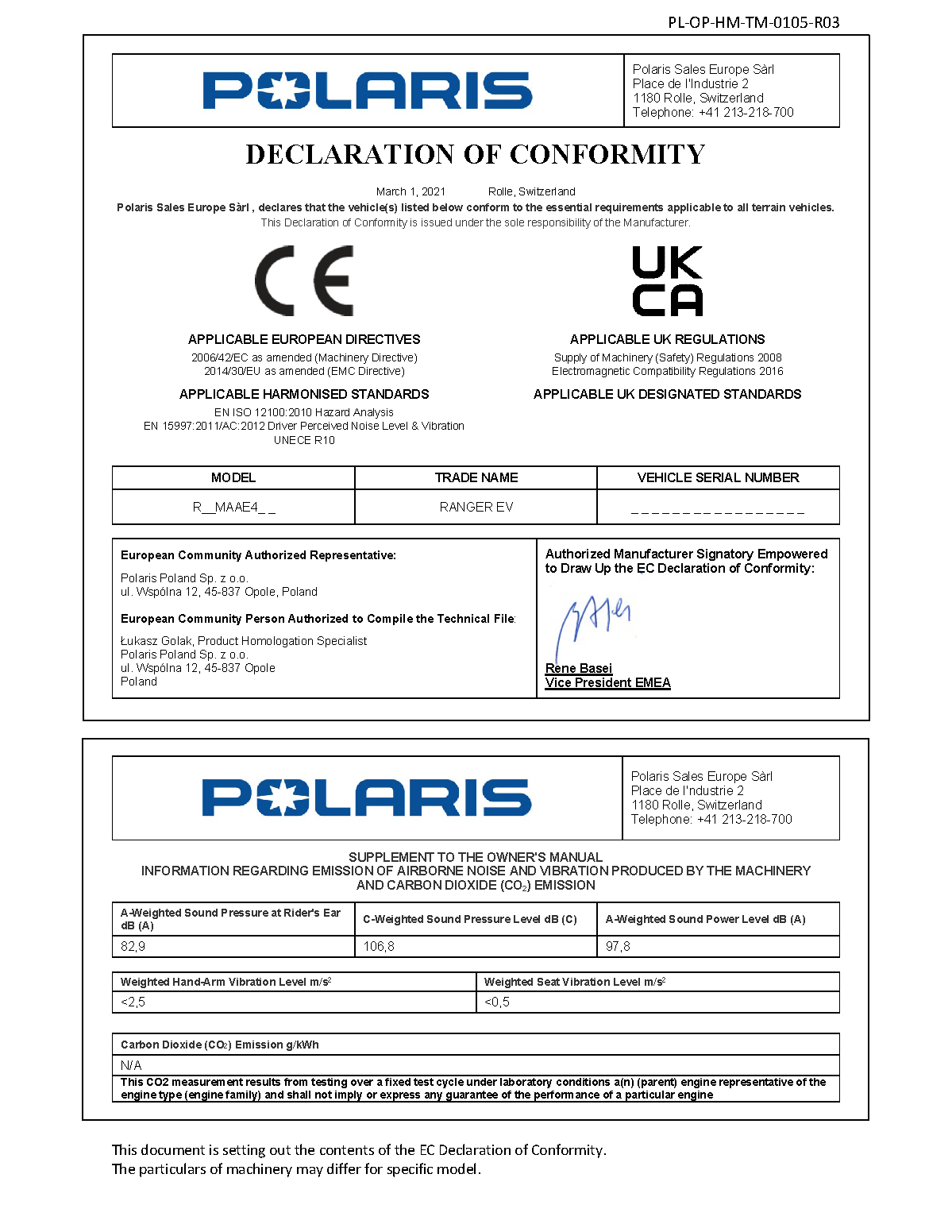
Record your vehicle's identification numbers and key number in the spaces provided. Remove the spare key and store it in a safe place. An ignition key can be duplicated only by ordering a POLARIS key blank (using your key number) and mating it with one of your existing keys. The ignition switch must be replaced if all keys are lost.
1 Vehicle Identification Number (VIN)
2 Key Number
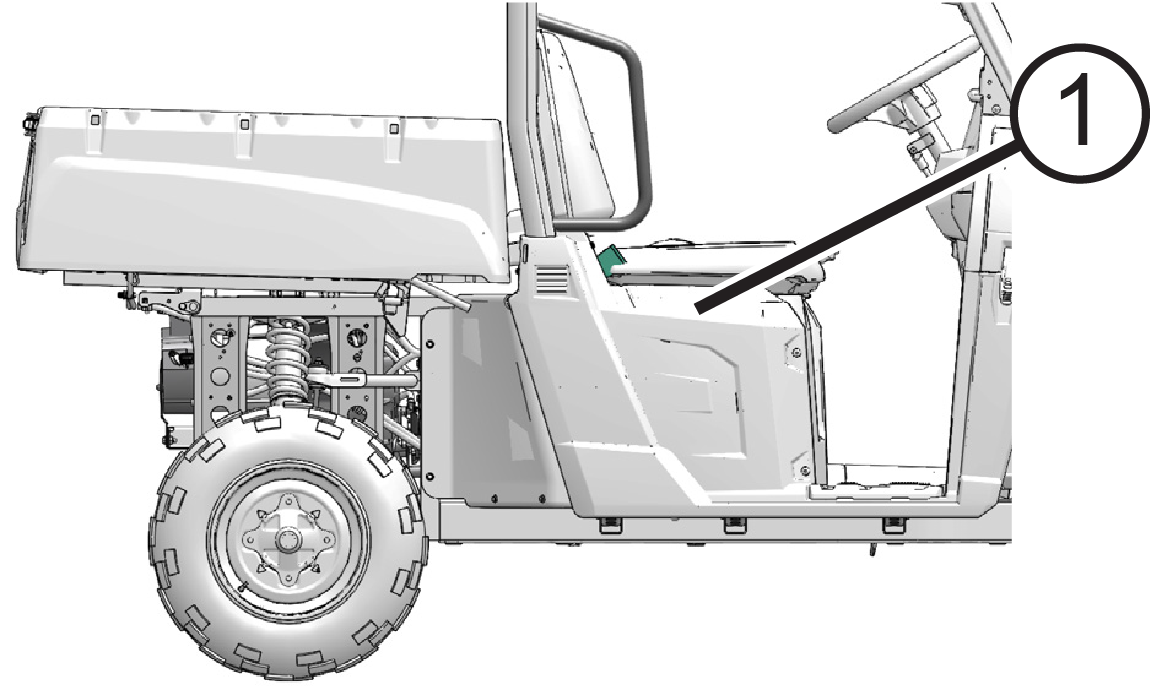
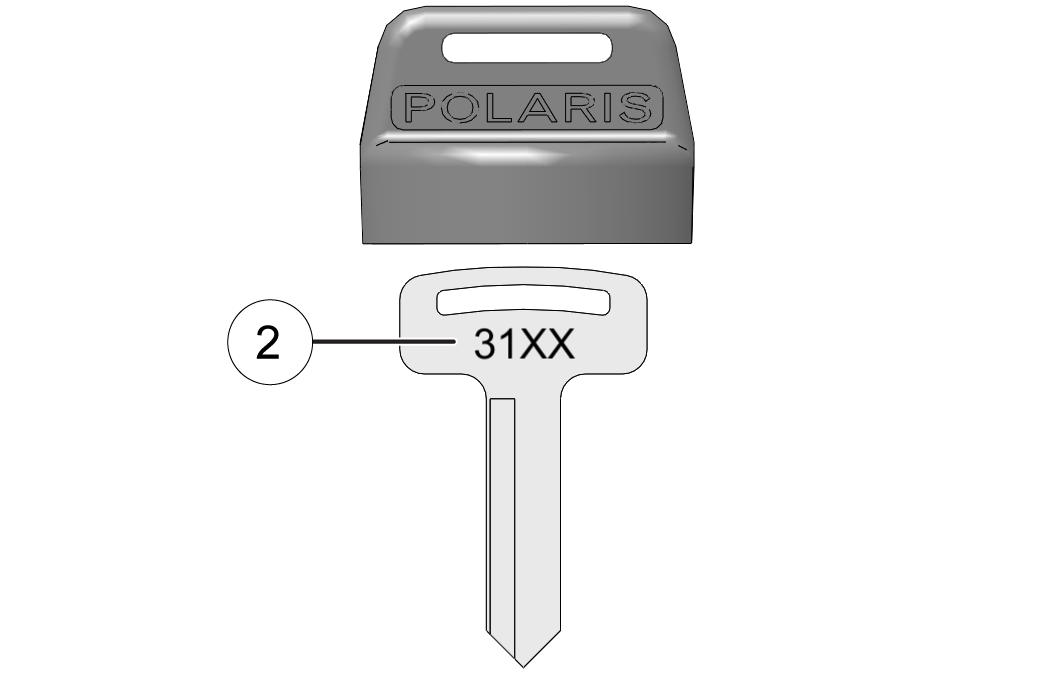
| Vehicle Model Number: | |
| Vehicle Identification Number (VIN): | |
| Motor Serial Number (on side of motor): | |
| Key Number |
The driver-perceived noise and hand/arm and whole body vibration levels of this machinery is measured per EN 15997.
The operating conditions of the machinery during testing:
The vehicles were in like-new condition. The environment was controlled as indicated by the test procedure(s).
The uncertainty of vibration exposure measurement is dependent on many factors, including:
Instrument and calibration uncertainty
Variations in the machine such as wear of components
Variation of machine operators such as experience or physique
Ability of the worker to reproduce typical work during measurements
Environmental factors such as ambient noise or temperature
Always wear a helmet, eye protection, gloves, long-sleeve shirt, long pants, over-the-ankle boots and seat belt (if equipped) at all times. Protective gear reduces the chance of injury.
Under certain operating conditions, heat generated by the vehicle can elevate temperatures in the rider cab area.
The condition occurs most frequently when a vehicle is being operated in high ambient temperatures at low speeds and/or high load conditions for an extended period of time. The use of certain windshield, roof and/or cab systems may contribute to this condition by restricting airflow. Any discomfort due to heat buildup in this area can be minimized by wearing proper riding apparel and by varying speeds to increase airflow.
1 Helmet
2 Eye Protection
3 Long Sleeves
4 Gloves
5 Long Pants
6 Over-the-Ankle Boots

Wearing a helmet can prevent a severe head injury. Whenever riding this POLARIS vehicle, always wear a helmet that meets or exceeds established safety standards. Clasp the buckle and pull each strap tight to ensure the helmet is properly secured to the head.
Parents and supervising adults should verify that young operators have a helmet that fits, and should obtain one of proper size if it does not fit before allowing operation.
Approved helmets in the USA and Canada bear a U.S. Department of Transportation (DOT) label.

Approved helmets in Europe, Asia and Oceania bear the ECE 22.05 label. The ECE mark consists of a circle surrounding the letter E, followed by the distinguishing number of the country which has granted approval. The approval number and serial number will also be displayed on the label.
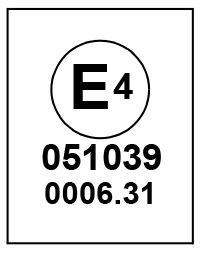
Do not depend on eyeglasses or sunglasses for eye protection. Whenever riding this POLARIS vehicle, always wear shatterproof goggles or use a shatterproof helmet face shield. POLARIS recommends wearing approved Personal Protective Equipment (PPE) bearing markings such as VESC 8, V-8, Z87.1, or CE. Make sure protective eye wear is kept clean.
Wear gloves for comfort and for protection from sun, cold weather and other elements.
Wear sturdy over-the-ankle boots for support and protection. Never ride a POLARIS vehicle with bare feet or sandals.
Wear long sleeves and long pants to protect arms and legs.
Warning labels have been placed on the vehicle for your protection. Read and follow the instructions of the labels on the vehicle carefully. If any of the labels depicted in this manual differ from the labels on your vehicle, always read and follow the instructions of the labels on the vehicle.
If any label becomes illegible or comes off, contact your POLARIS dealer to purchase a replacement. Replacement safety labels are provided by POLARIS at no charge. The part number is printed on the label.
Read the owner’s manual.
Never allow anyone under 16 years of age to operate this vehicle.
Never use alcohol or drugs before or while driving or riding.
Do not allow operation on public roads (unless designated for off-highway vehicle access).
Wear approved helmet, goggles, and protective clothing.
Always wear seat belts.
Never exceed seating capacity.
Always follow proper operating procedures.
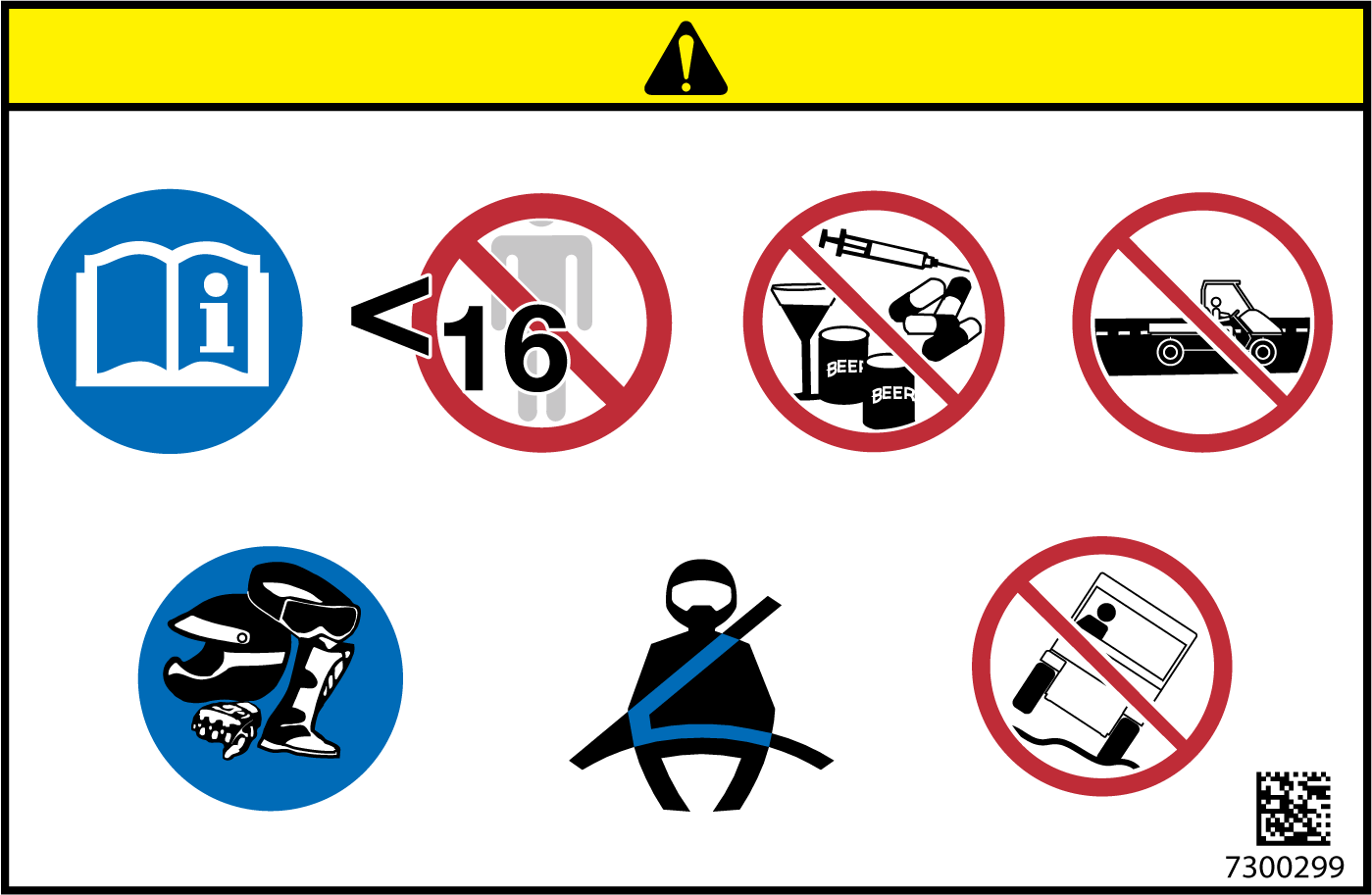
Read the owner’s manual.
MAXIMUM DRAWBAR PULL: 1700 N ON LEVEL GROUND
MAXIMUM VERTICAL LOAD: 1100 N
Label Location: on the hitch receiver.
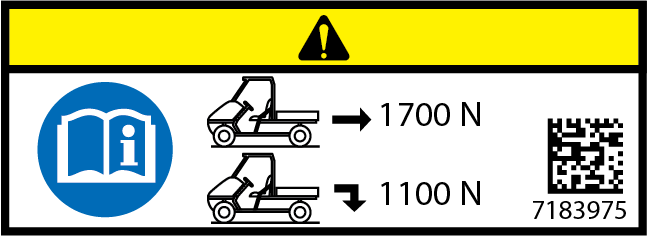
WARNING

Passengers can be thrown off. This can cause serious injury or death.
Never carry passengers in cargo box.
Read the Owner’s Manual.
Never carry fuel on this vehicle.
WARNING
IMPROPER TIRE PRESSURE OR OVERLOADING CAN CAUSE LOSS OF CONTROL RESULTING IN SERIOUS INJURY OR DEATH.
Reduce speed and allow greater distance for braking when carrying cargo.
Overloading or carrying tall, off-center, or unsecured loads will increase your risk of losing control. Loads should be centered and carried as low as possible in box.
For stability on rough or hilly terrain, reduce speed and cargo.
Be careful if load extends over the side of the box.
| EV | MID-SIZE | MID-SIZE CREW | |
|---|---|---|---|
|
MAXIMUM CARGO BOX LOAD |
226 kg (500 lbs.) |
||
|
TIRE PRESSURE IN KPa (PSI) |
F - 70 (10) R - 110 (16) |
F - 69 (10) R - 69 (10) |
F - 69 (10) R - 96 (14) |
|
MAXIMUM WEIGHT CAPACITY
|
454 kg (1000 lbs.) |
547 kg (1206 lbs.) |
|
|
WARNING
|
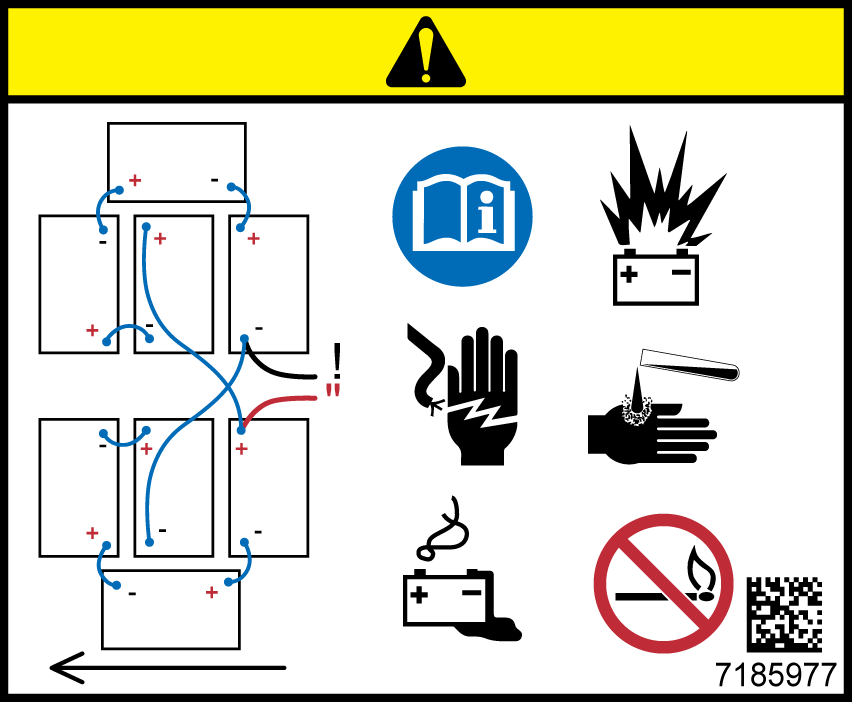
|
TO MAXIMIZE BATTERY LIFE
Always check and maintain water level monthly.
Use only distilled water.
Water level should be kept 6 mm (1/4”) below the fill well.
Do not overfill the battery.
Always keep batteries fully charged.
For maximum life, charge your vehicle at every opportunity.
Use only the charger supplied with the vehicle.
Inspect battery connections regularly.
Failure to properly maintain your batteries will void warranty coverage.
Read the owner’s manual.
Always set the park brake before removing the ignition key.
A rolling vehicle can cause serious injury.
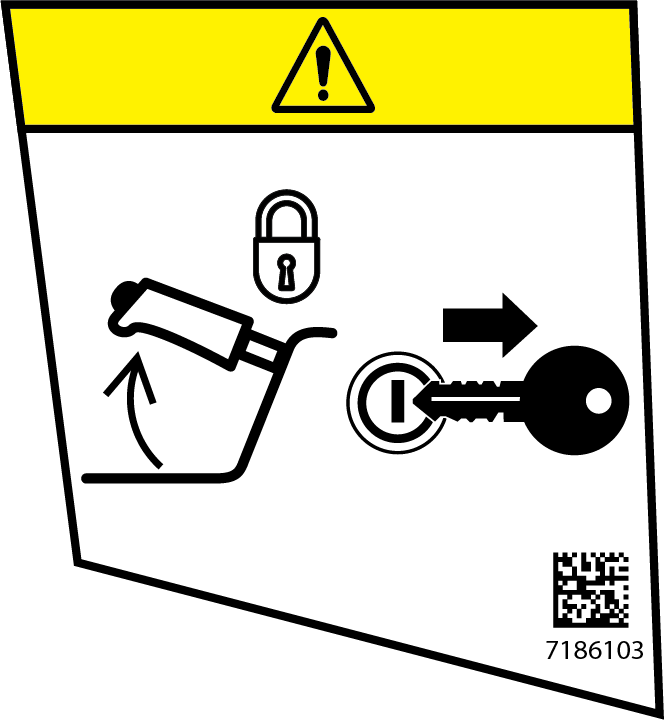
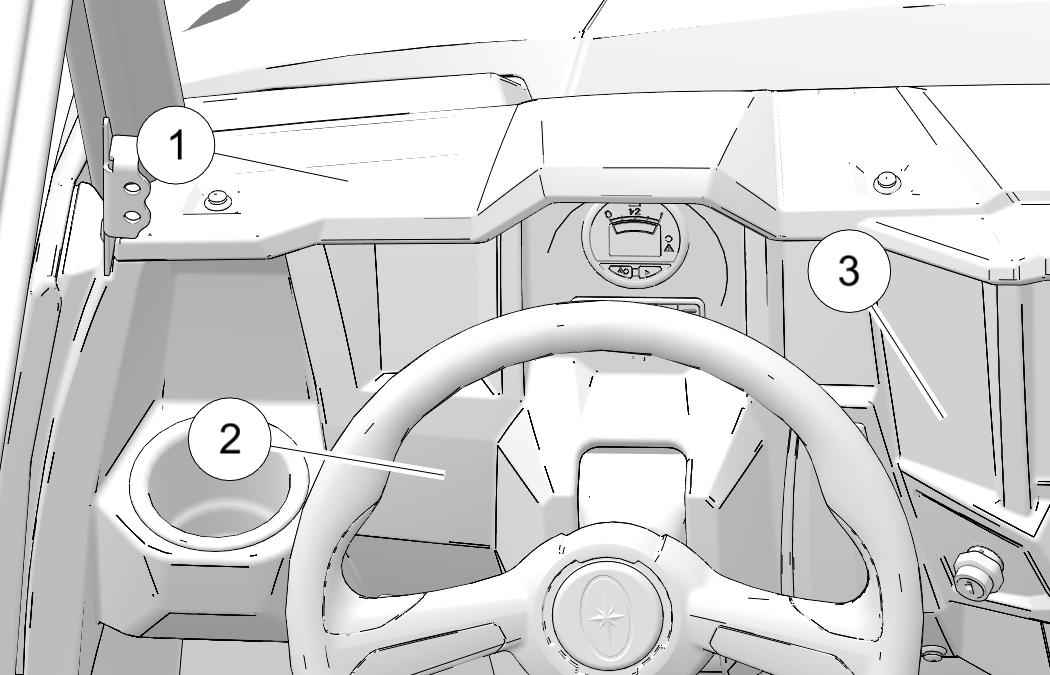
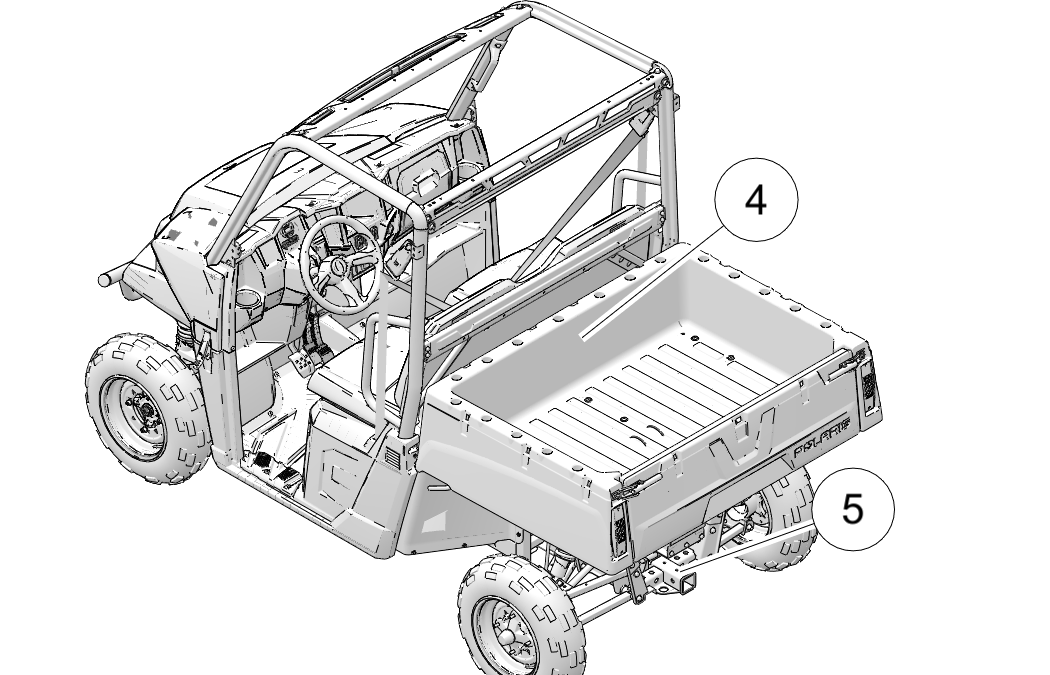
1 General Alert
2 Battery Charging Warning
3 Park Brake Warning
4 Pass. / Tire Pressure Warning
5 Hitch Capacity Alert
Read this entire manual and all labels carefully. Follow the operating procedures described.
Never allow anyone under the age of 16 to operate this vehicle and never allow anyone without a valid driver's license to operate this vehicle.
Do not carry a passenger until you have at least two hours of driving experience with this vehicle.
No person under the age of 12 may ride as a passenger in this vehicle. All riders must be able to sit with backs against the seat, both feet flat on the floor and both hands on the steering wheel (if driving) or on a passenger hand hold.
The driver and all passengers must wear helmet, eye protection, gloves, long-sleeve shirt, long pants, over-the-ankle boots and seat belt at all times.
Always keep hands and feet inside the vehicle at all times. Always keep both hands on the steering wheel and both feet on the floorboards of the vehicle during operation.
Never permit a guest to operate this vehicle unless the guest has read this manual and all product labels.
To reduce rollover risk, be especially careful when encountering obstacles and slopes and when braking on hills or during turns.
This vehicle is for off-road use only. Never operate on public roads (unless marked for off-road use). Always avoid paved surfaces.
Never consume alcohol or drugs before or while operating this vehicle.
Never operate at excessive speeds. Always travel at a speed proper for the terrain, visibility and operating conditions, and your experience.
Never attempt jumps or other stunts.
Always inspect the vehicle before each use to make sure it's in safe operating condition. Always follow the inspection procedures described in this manual.
Always travel slowly and use extra caution when operating on unfamiliar terrain. Be alert to changing terrain.
Never operate on excessively rough, slippery or loose terrain.
Always follow proper procedures for turning. Practice turning at slow speeds before attempting to turn at faster speeds. Never turn at excessive speeds.
Always have this vehicle checked by an authorized POLARIS dealer if it has been involved in an accident.
Never operate this vehicle on hills too steep for the vehicle or for your abilities. Practice on smaller hills before attempting larger hills.
Always follow proper procedures for climbing hills as described in this manual. See page 37. Check the terrain carefully before attempting to climb a hill. Never climb hills with excessively slippery or loose surfaces. Never go over the top of a hill at high speed.
Always follow the proper procedures outlined in this manual for traveling downhill and for braking on hills. See page 37. Check the terrain carefully before descending a hill. Never travel downhill at high speed. Avoid going downhill at an angle, which would cause the vehicle to lean sharply to one side. Travel straight down the hill where possible.
Always check for obstacles before operating in a new area. Never attempt to operate over large obstacles such as large rocks or fallen trees. Always follow the proper procedures outlined in this manual when operating over obstacles. See page 38.
Always be careful of skidding or sliding. On slippery surfaces such as ice, travel slowly and exercise caution to reduce the chance of skidding or sliding out of control.
Never operate your vehicle in fast-flowing water or in water deeper than that specified in this manual. See page 38. Wet brakes may have reduced stopping ability. Test your brakes after leaving water. If necessary, apply them lightly several times to let friction dry out the pads.
Always be sure there are no obstacles or people behind your vehicle when operating in reverse. When it's safe to proceed in reverse, move slowly. Avoid turning at sharp angles in reverse.
Always use the proper size and type of tires specified in this manual. Always maintain proper tire pressure as specified on safety labels.
Never modify this vehicle through improper installation or use of non-POLARIS-approved accessories.
Never exceed the stated load capacity for this vehicle. Cargo should be properly distributed and securely attached. Reduce speed and follow the instructions in this manual for hauling cargo or pulling a trailer. Allow a greater distance for braking.
Always set the park brake and remove the key when leaving the vehicle unattended.
Never install any accessory that grounds to the vehicle chassis. The chassis is a floating ground to protect against electrical short circuits and hazards.
Do not install any non-POLARIS-approved accessory or modify the vehicle for the purpose of increasing speed or power. Any modifications or installation of non-POLARIS-approved accessories could create a substantial safety hazard and increase the risk of bodily injury.
The warranty on your POLARIS vehicle will be terminated if any non-POLARIS-approved equipment and/or modifications have been added to the vehicle that increase speed or power.
The addition of certain accessories, including (but not limited to) mowers, blades, tires, sprayers, or large racks, may change the handling characteristics of the vehicle. Use only POLARIS-approved accessories, and familiarize yourself with their function and effect on the vehicle.
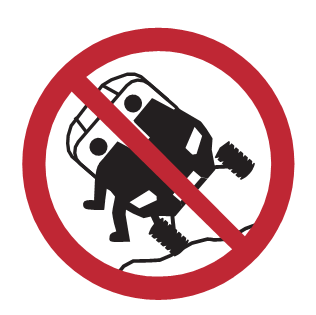
Operating this vehicle without proper instruction increases the risk of an accident. The operator must understand how to operate the vehicle properly in different situations and on different types of terrain. All operators must read and understand the Owner's Manual and all warning and instruction labels before operating the vehicle.

|
This vehicle is an ADULT VEHICLE ONLY. NEVER operate this vehicle if you are under age 16 and NEVER operate without a valid driver’s license. Never operate with a passenger under the age of 12. All riders must be able to sit with backs against the seat, both feet flat on the floor and both hands on the steering wheel (if driving) or on a passenger hand hold (if equipped). |
|
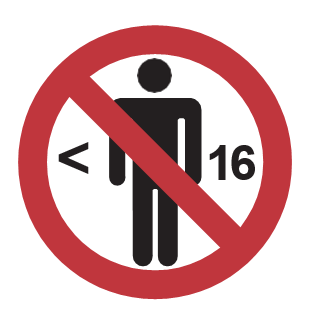
|
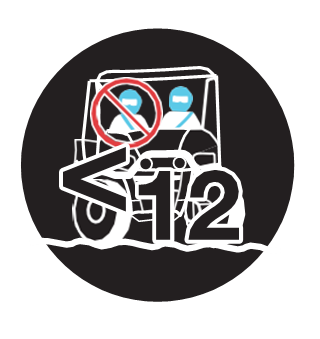
|
Never consume alcohol or drugs before or while operating this vehicle.
Operating this vehicle after consuming alcohol or drugs could adversely affect operator judgment, reaction time, balance and perception.

|
Riding in this vehicle without wearing the seat belt increases the risk of serious injury in the event of rollover, loss of control, other accident or sudden stop. Seat belts may reduce the severity of injury in these circumstances. All riders must wear seat belts at all times. |
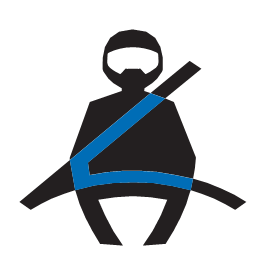
|
Riding in this vehicle without wearing an approved helmet and protective eyewear increases the risk of a serious injuries in the event of an accident. Operator and all passenger must always wear an approved helmet that fits properly and eye protection (goggles or face shield).
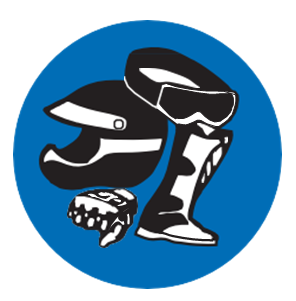
Exhibition driving increases the risk of an accident or rollover. DO NOT do power slides, “donuts”, jumps or other driving stunts. Avoid exhibition driving.
|
A passenger must always be seated in a passenger seat with seat belt secured. Carrying more than one passenger in a 2-seat vehicle can affect the operator’s ability to steer and operate the controls, which increases the risk of loss of control and accident or rollover. Never carry more than one passenger in a 2-seat vehicle. |
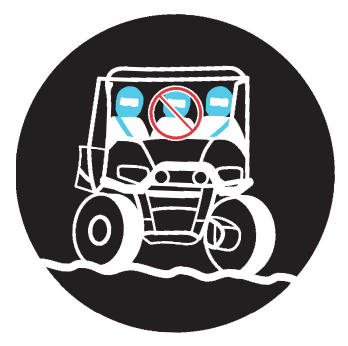
|
Failure to provide adequate ventilation while charging batteries can result in an explosion. Volatile hydrogen gas is emitted during charging and may accumulate in pockets at the ceiling.
Always ensure a minimum of 5 air changes per hour in the charging area.
Always remove any storage covers from the vehicle and open any cab doors (if equipped) before charging.
The weight of the cargo, operator, and passengers impacts vehicle operation and stability. For your safety and the safety of others, carefully consider how your vehicle is loaded and how to safely operate the vehicle. Follow the instructions in this manual for loading, tire pressure, gear selection and speed.
Do not exceed vehicle weight capacities. The vehicle’s maximum weight capacity is listed in the specifications section of this manual and on a label on the vehicle. When determining the weight you are adding to the vehicle, include the weight of the operator, passengers, accessories, loads in the rack or box and the load on the trailer tongue. The combined weight of these items must not exceed the maximum weight capacity.
The recommended tire pressures are listed in the specifications section of this manual and on a label on the vehicle.
Always follow these guidelines:
| Under ANY of these conditions: | Do ALL of these steps: |
|---|---|
| Operator and/or cargo exceeds half the maximum weight capacity |
|
| Operating in rough terrain | |
| Operating over obstacles | |
| Climbing an incline | |
| Towing |
Operating a damaged vehicle can result in an accident. After any rollover or other accident, have a qualified service dealer inspect the entire machine for possible damage, including (but not limited to) seat belts, rollover protection devices, brakes, throttle, and steering systems.
Operating this vehicle at excessive speeds increases the operator's risk of losing control. Always operate at a speed that's appropriate for the terrain, the visibility and operating conditions and your skills and experience.
This vehicle's tires are designed for off-road use only, not for use on pavement. Operating this vehicle on paved surfaces (including sidewalks, paths, parking lots and driveways) may adversely affect the handling of the vehicle and may increase the risk of loss of control and accident or rollover. Avoid operating the vehicle on pavement. If it's unavoidable, travel slowly, travel short distances and avoid sudden turns or stops.
Operating this vehicle on public streets, roads or highways could result in a collision with another vehicle. Never operate this vehicle on any public street, road or highway, including dirt and gravel roads (unless designated for off-highway use).
Turning improperly could cause loss of traction, loss of control, accident or rollover. Always follow proper procedures for turning as described in this owner’s manual.
Avoid sharp turns. Never turn while applying heavy throttle. Never make abrupt steering maneuvers. Practice turning at slow speeds before attempting to turn at faster speeds.
Failure to use extra caution when operating on unfamiliar terrain could result in an accident or rollover.
Unfamiliar terrain may contain hidden rocks, bumps, or holes that could cause loss of control or rollover.
Travel slowly and use extra caution when operating on unfamiliar terrain. Always be alert to changing terrain conditions.
Failure to use extra caution when operating on excessively rough, slippery or loose terrain could cause loss of traction, loss of control, accident or rollover. Do not operate on excessively slippery surfaces. Always slow down and use additional caution when operating on slippery surfaces.
Skidding or sliding due to loss of traction can cause loss of control or rollover (if tires regain traction unexpectedly). Always follow proper procedures for operating on slippery surfaces as described in this owner's manual.
Improper hill climbing could cause loss of control or rollover. Use extreme caution when operating on hills. Always follow proper procedures for hill climbing as described in this owner's manual.
Improperly descending a hill could cause loss of control or rollover. Always follow proper procedures for traveling down hills as described in this owner’s manual.
Stalling or rolling backwards while climbing a hill could cause a rollover. Maintain a steady speed when climbing a hill.
If you lose all forward speed:
Apply the brakes gradually until the vehicle is fully stopped. Switch to reverse and slowly allow the vehicle to roll straight downhill while applying light brake pressure to control speed.
If you begin rolling downhill:
Never press the accelerator. Apply the brakes gradually until the vehicle is fully stopped. Switch to reverse and slowly allow the vehicle to roll straight downhill while applying light brake pressure to control speed.
Operating this vehicle with improper tires or with improper or uneven tire pressure could cause loss of control or accident. Always use the size and type of tires specified for your vehicle. Always maintain proper tire pressure as described in the owner's manual and on safety labels.
Serious injury or death can result if the vehicle and/or the operator fall through the ice. Never operate the vehicle on a frozen body of water unless you have first verified that the ice is sufficiently thick to support the weight and moving force of the vehicle, you and your cargo, together with any other vehicles in your party.
Always check with local authorities and residents to confirm ice conditions and thickness over your entire route. Vehicle operators assume all risk associated with ice conditions on frozen bodies of water.
Leaving the keys in the ignition can lead to unauthorized use of the vehicle by someone under the age of 16, without a drivers license, or without proper training. This could result in an accident or rollover. Always remove the ignition key when the vehicle is not in use.
The motor and controller are very hot during and after use of the vehicle. Hot components can cause burns and fire. Do not touch hot drive system components. Always keep combustible materials away from the drive system.
Use caution when traveling through tall grass, especially dry grass, and when traveling in muddy conditions. Always inspect areas near the drive system after driving through tall grass, weeds, brush, other tall ground cover, and muddy conditions. Promptly remove any grass, debris, or foreign matter clinging to the vehicle. Pay particular attention to the drive system area.
Always follow all safety instructions in the maintenance portion of this owner’s manual, as well as the following:
Make sure the vehicle is properly immobilized before beginning any maintenance.
Always block the chassis securely before working under the vehicle.
Turn the key off and remove it from the vehicle.
Insulate any tools used within the battery area to prevent sparks or battery explosion caused by shorting the battery terminals or wiring. Remove the batteries, or cover the exposed terminals with an insulating material.
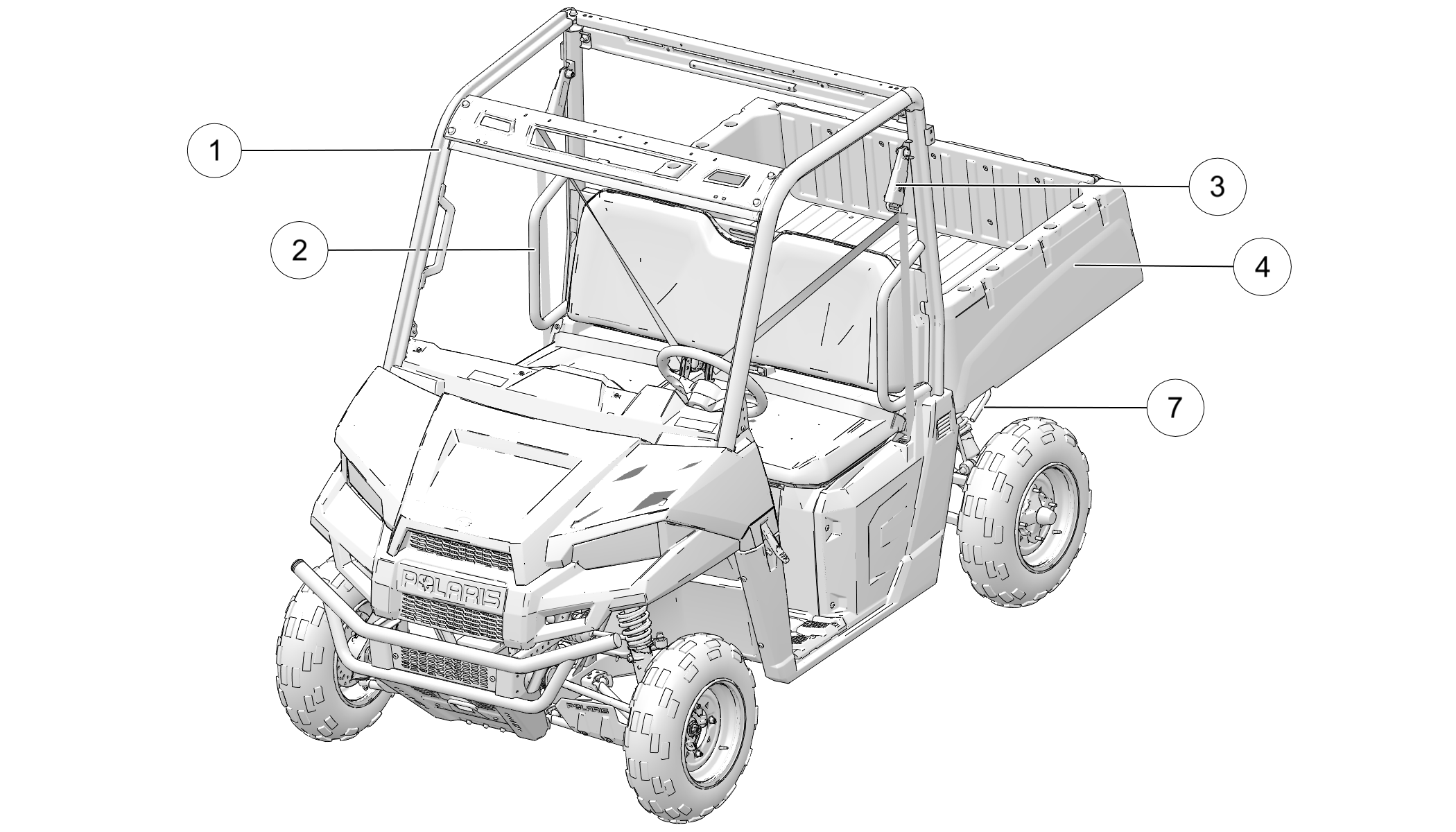
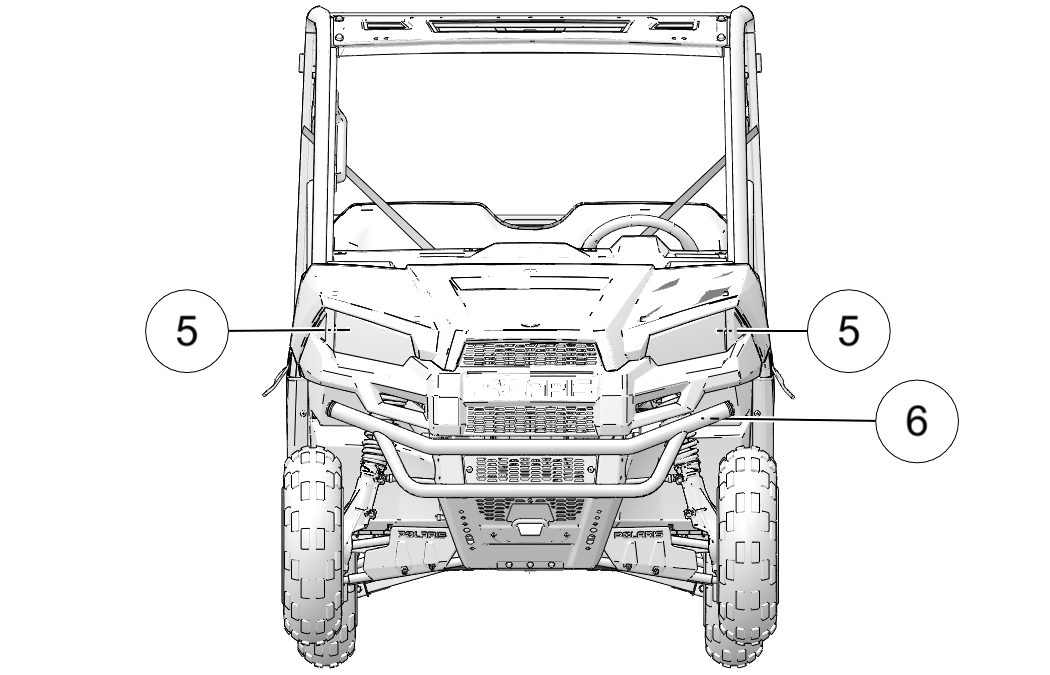
|
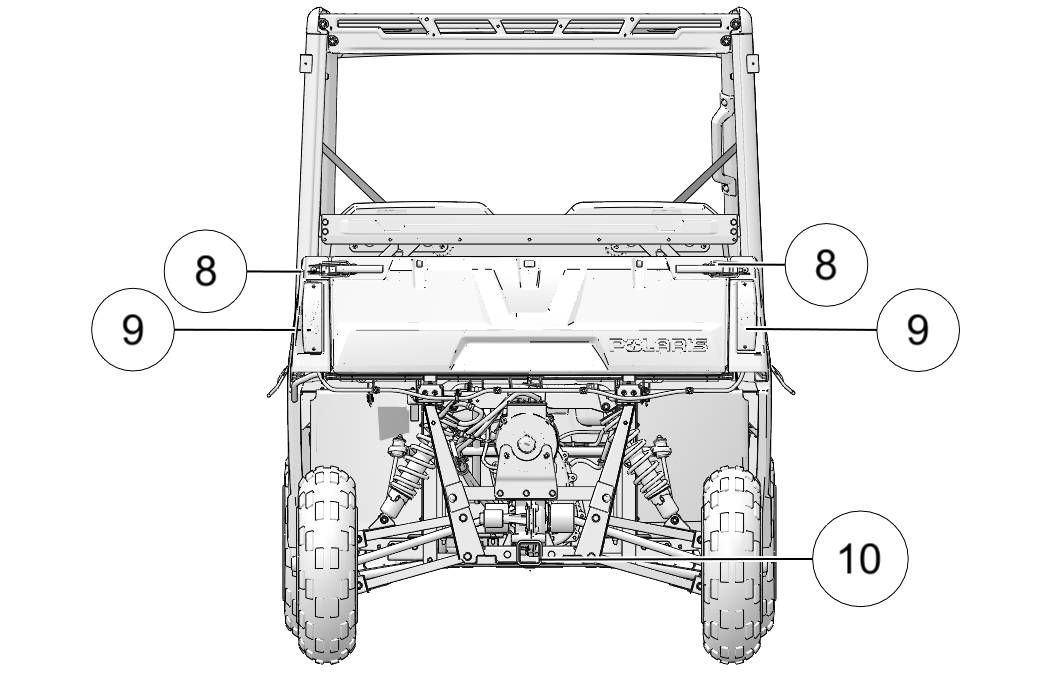
|
| 1 ROPS Frame | 6 Front Bumper/Brush Guard | |
| 2 Hip Bars | 7 Cargo Box Release Lever | |
| 3 Seat Belt | 8 Tailgate Latches | |
| 4 Cargo Box | 9 Taillights | |
| 5 Headlight | 10 Receiver Hitch |
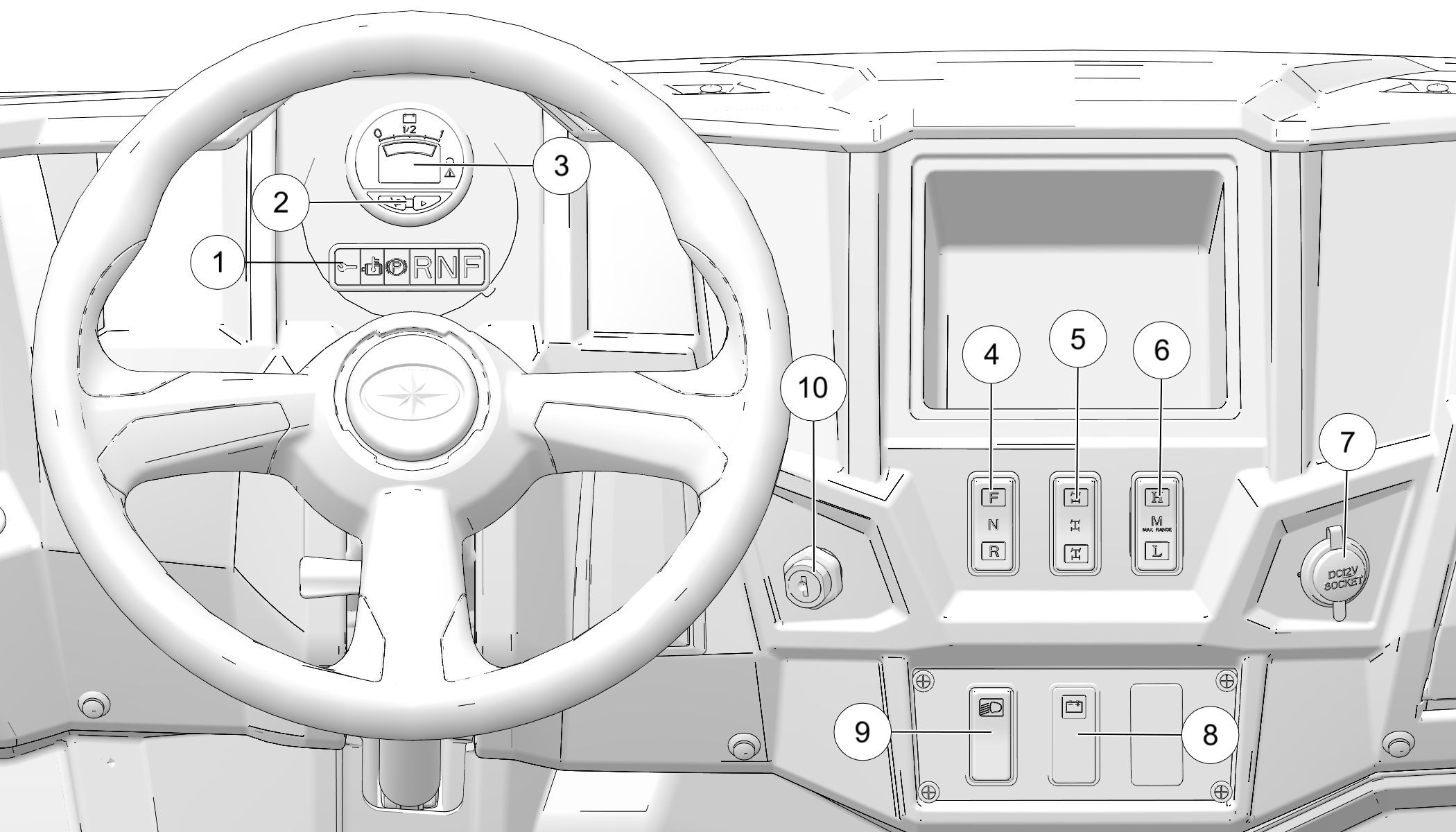
1 Indicator Lights
2 Hour Meter
3 Battery Discharge Indicator
4 Direction Selector
5 Driveline Mode Switch
6 Drive Mode Switch
7 12V Auxiliary Outlet
8 Charge Status Indicator
9 Headlight Switch
10 Key Switch
The indicator lights activate when the key is in the ON position.
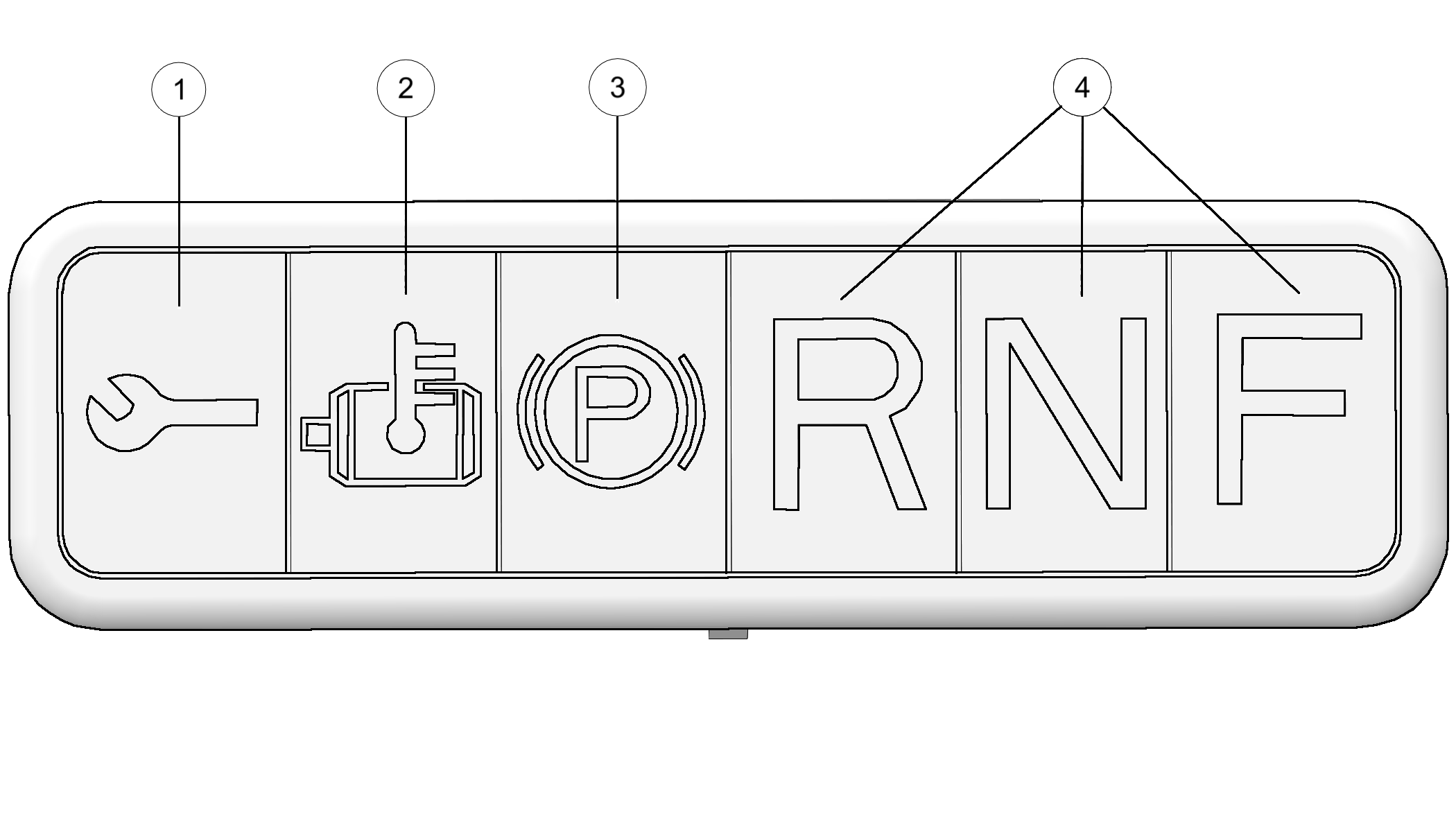
| Indicator | Status | Indicates | |
|---|---|---|---|
| 1 | Malfunction | Steady | Electrical malfunction (flash sequence on controller indicates type |
| 2 | Motor/Controller High Tempurature | Flashing | Reduced performance due to elevated temperature |
| Steady | Power delivery terminated to protect against overheating | ||
| If either occurs, stop the vehicle and turn the key off. Allow the motor and controller to cool adequately before operating. | |||
| 3 | Park Brake | Steady | Engaged park brake |
| 4 | Gear Postion | Steady | Selected gear |
The battery discharge indicator displays the amount of charge removed (used) from fully charged batteries. When the batteries are fully charged, the gauge will display 100%. The charge status indicator will be solid green.
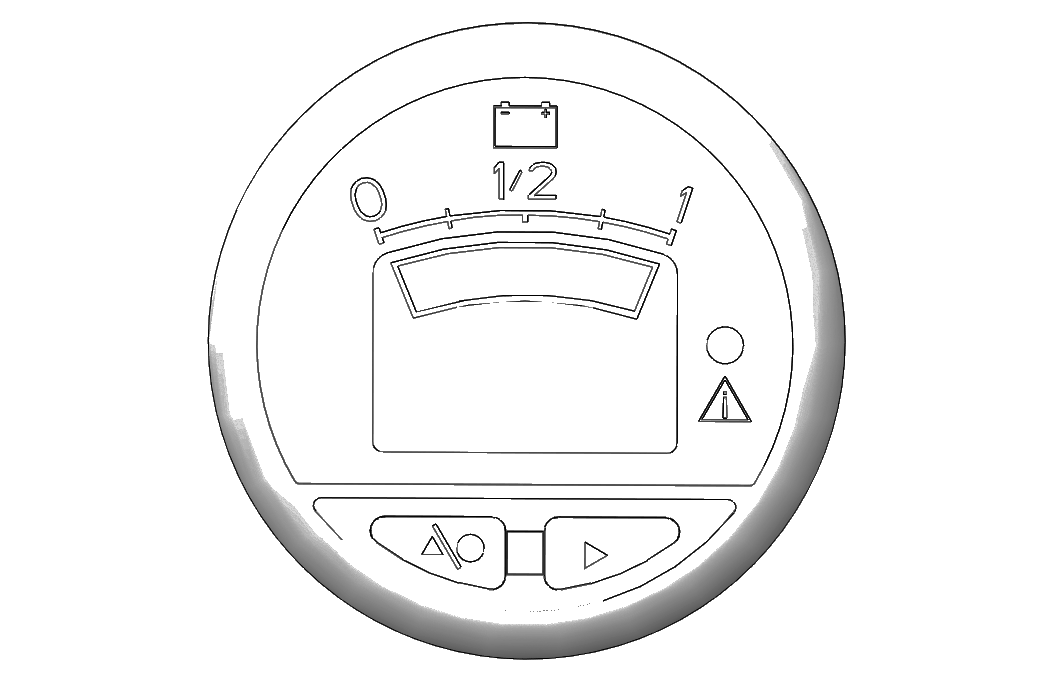
The hour meter records and displays the hours of actual vehicle movement since manufacture.
When charging the batteries, the charge status indicator light flashes and changes color to indicate the status of the charge. Refer to the table below.
| Color | Indication | Code Definition |
| Green | Solid | Charge is complete, charger is in maintenance mode. |
| Green | Fast Flash | Less than 80% of charge is completed. |
| Green | Slow Flash | More than 80% of charge is completed. |
| Amber | Flashing | Power mode is reduced, low AC voltage or high internal charger temperature exists; open hood to improve air flow. |
| Red | Flashing | Charger error exists; reset charger power and refer to Troubleshooting section of owner’s manual |
Turn the key to the ON1 position to activate the electrical circuits. Turn the key to the OFF2 position to disable all electrical circuits. The key can be removed from the switch when it is in the OFF position.
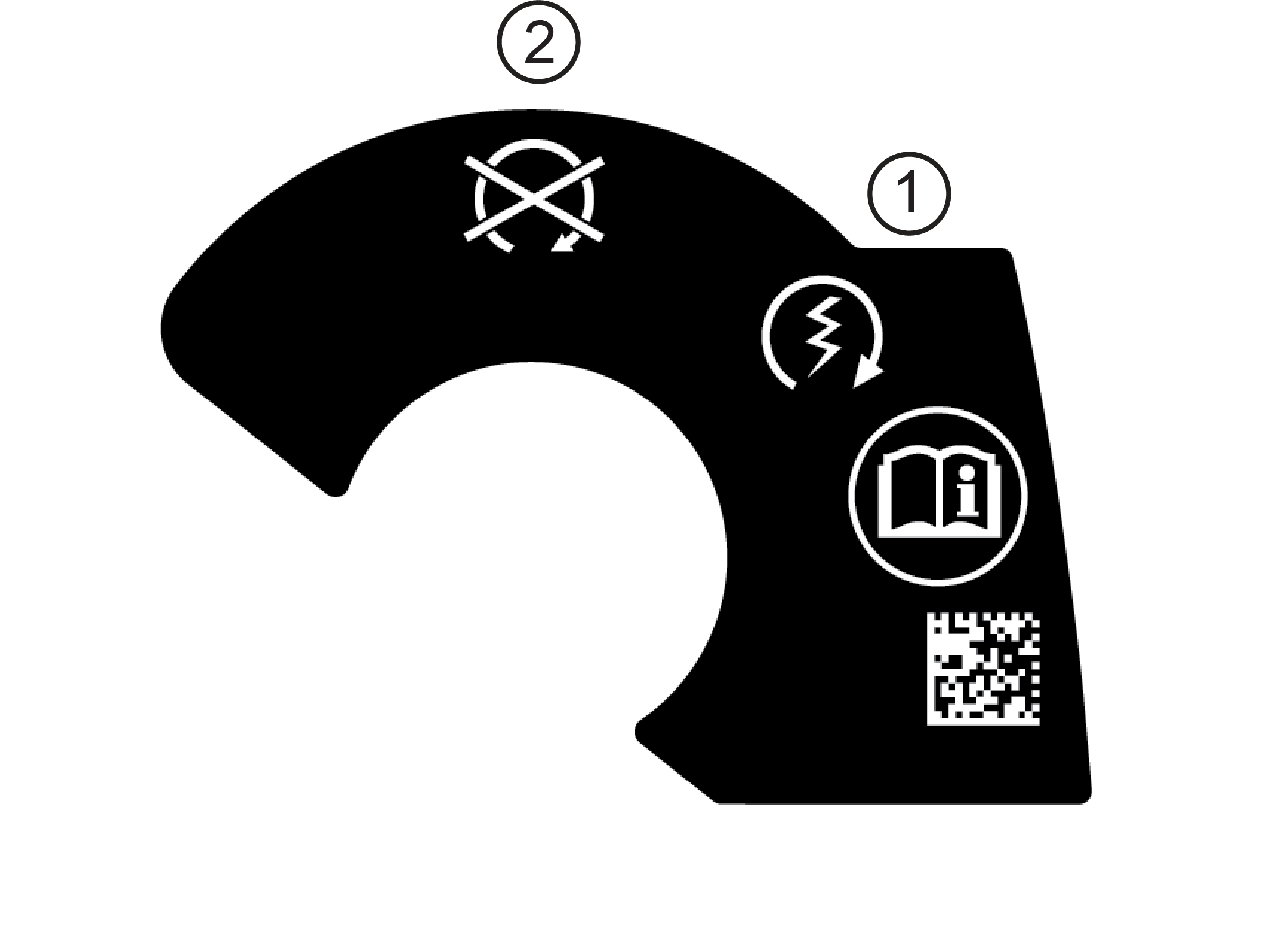
Press the top of the switch to turn the headlights on. Press the bottom of the switch to turn the headlights off.
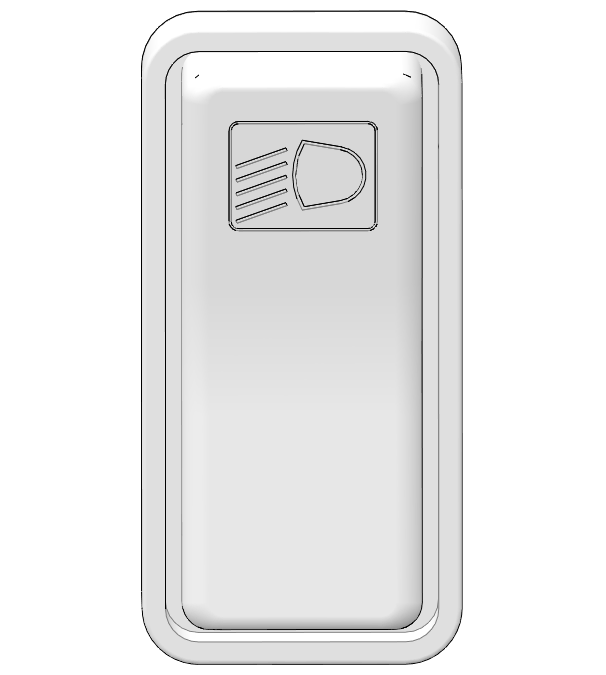
When the direction selector is in the center position, the vehicle is in neutral. The vehicle will not move if the accelerator pedal is depressed. Push the top of the switch to choose forward operation. Push the bottom of the switch to choose reverse operation. If the switch is changed while the accelerator pedal is depressed, the vehicle will not move in the new direction until the pedal is released, then depressed again.
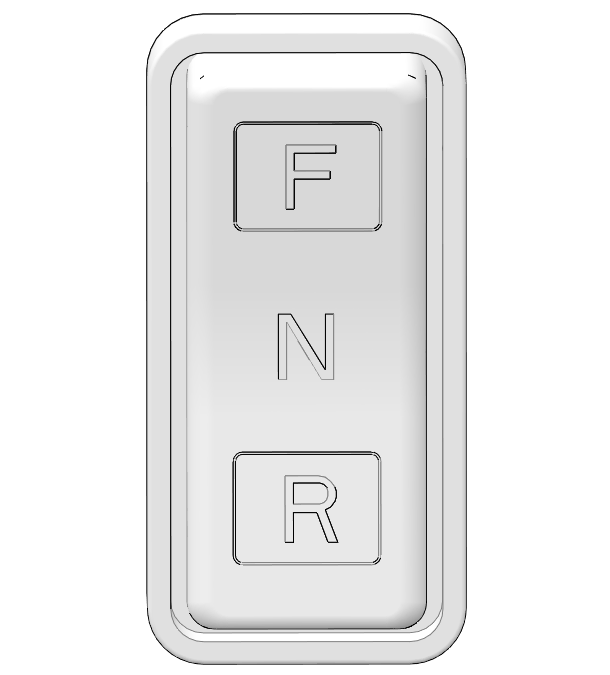
The Driveline Mode switch has three positions: All Wheel Drive (AWD), Differential Lock/Two Wheel Drive (2WD) and Off (1WD/Turf Mode).
Press the top of the switch to engage All Wheel Drive (AWD).
Move the switch to the center position to lock the differential and operate in two wheel drive (2WD).
Press the bottom of the switch to unlock the differential and allow the rear drive wheels to operate independently (1WD). This mode of operation is well suited to turf driving or when active traction is not needed.
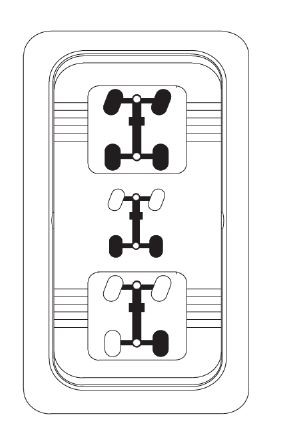
Press the top of the switch to select high mode. Use high mode for most trail-riding conditions. The vehicle will operate at speeds up to 25 MPH (40 km/h).
Press the bottom of the switch to select low mode. Low mode is recommended for short-term operation in extreme load conditions. Use low mode when towing, hauling loads or maneuvering over obstacles. Speed will be limited to a maximum of 10 MPH (16 km/h) and regenerative braking increases to improve control in aggressive terrain. Return the mode switch to high mode for normal operation.
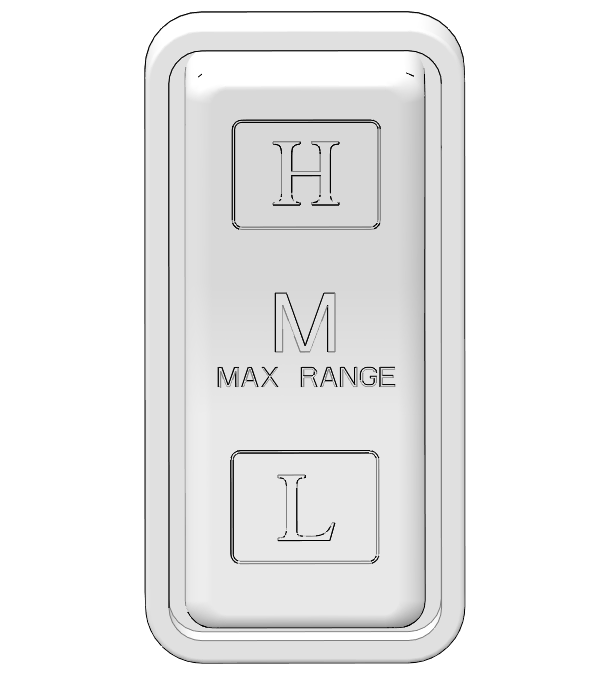
Move the switch to the center position to select the maximum range mode. Use this mode to operate the vehicle a greater distance or for a longer time period. This mode limits both speed and torque to obtain the maximum driving range.
| Mode | Maximum Speed | Torque (% of max torque) |
Deceleration | Application |
|---|---|---|---|---|
| High | 25 MPH (40 km/h) | 70% | Minimum | Trail riding |
| Max Range | 15 MPH (24 km/h) | 50% | Minimum | Whenever possible, to maximum driving range of battery pack |
| Low | 10 MPH (16 km/h) | 100% | Maximum | Towing, hauling loads, driving on steep hills or aggressive terrain |
This vehicle is equipped with eight 12-volt batteries that supply the power needed to operate the vehicle. The batteries are located under the seat.
Always observe all battery safety warnings and safe handling procedures as outlined on vehicle safety labels and in this manual.
Always make sure that all electrical accessories are grounded directly to the negative (-) post on the terminal board. Never use the chassis or body as a ground connection.
Always keep battery terminals and connections clean and free of corrosion at all times.
Always maintain a full charge on the batteries. For best battery life, avoid discharging the batteries more than 80%.
Make sure new batteries are fully charged before using.
New deep cycle batteries need to be cycled several times before reaching full capacity (50- 125 cycles, depending on type). Capacity will be limited during this time.
Make sure vent caps are installed properly and securely during vehicle operation and battery charging.
Recharge batteries fully at the end of each day the vehicle is operated, allowing adequate time for the charger to complete its charge cycle. The batteries in this vehicle do not have a “memory effect”. Frequent charging will extend their life.
Avoid charging at temperatures above 120° F. (49° C.) ambient air temperature. Closed, unvented storage buildings often exceed this temperature when exposed to direct sunlight.
Never connect an auxiliary battery to the factory-installed DC-to-DC converter. If more than 10 amps are needed for accessories, always install the POLARIS-approved auxiliary accessory battery kit.
Never connect a 12-volt accessory directly to the batteries. Always connect any powered accessory to a 12-volt auxiliary outlet or terminal board.
Never connect jumper cables to any of the batteries of this vehicle.
Use only insulated tools when working in the battery compartment.
New batteries cannot initially hold all of their capacity. The approximate capacity of the battery pack increases as the number of charge cycles increases.
| Number of Charge Cycles: | New | 15 | 30 | 45 |
| Percentage of Full Capacity | 80% | 90% | 95% | 100% |
Battery range decreases as ambient temperature decreases. This can affect the range by up to 30%.
Batteries discharge when left uncharged. They can discharge up to 13% per month (higher rates in warmer climates) with the key off and much faster if the key is left on.
Batteries can freeze if left uncharged at low ambient temperatures.
| Percent Charged | 100% | 50% | 0% |
| Approx. Freezing Point | -60° F (-51° C) | 0° F (-18° C) | 25° F (-4° C) |
Open the hood and any door enclosures or zippers. This will decrease charger temperature, which allows it to operate more efficiently, and shorten charge times. See Battery Charging for charging procedures.
Always use extension cords with the appropriate ratings for the country in which it is used. In North America this is a UL rating. The cords must also be rated for the conditions in which they are used, such as being rated for protection from oil in a garage or workshop environment.
Use the proper cord wire gauges for the cord length used.
| Length: | <25 ft (7.5 m) | <50 ft (15 m) | <100 ft (30 m) |
| Gauge: | 16AWG (1.5mm2) | 14AWG (2.5mm2) | 10AWG (6.0mm2) |
Range is significantly affected by tire pressure, alignment, terrain and driving style. Always maintain proper tire pressure as specified on safety labels.
When disconnected, the main power connector1 disconnects the battery pack from all electrical components, with the exception of the contactor. After servicing the vehicle, the main power connector should be the last connection to be made.
The main power connector is located under the seat on the driver’s side of the controller tray, adjacent to the main line contactor. To disconnect, unplug the connector.
To disconnect the battery pack from the vehicle completely, disconnect the main power connector, then remove the B+ wire from the battery terminal.
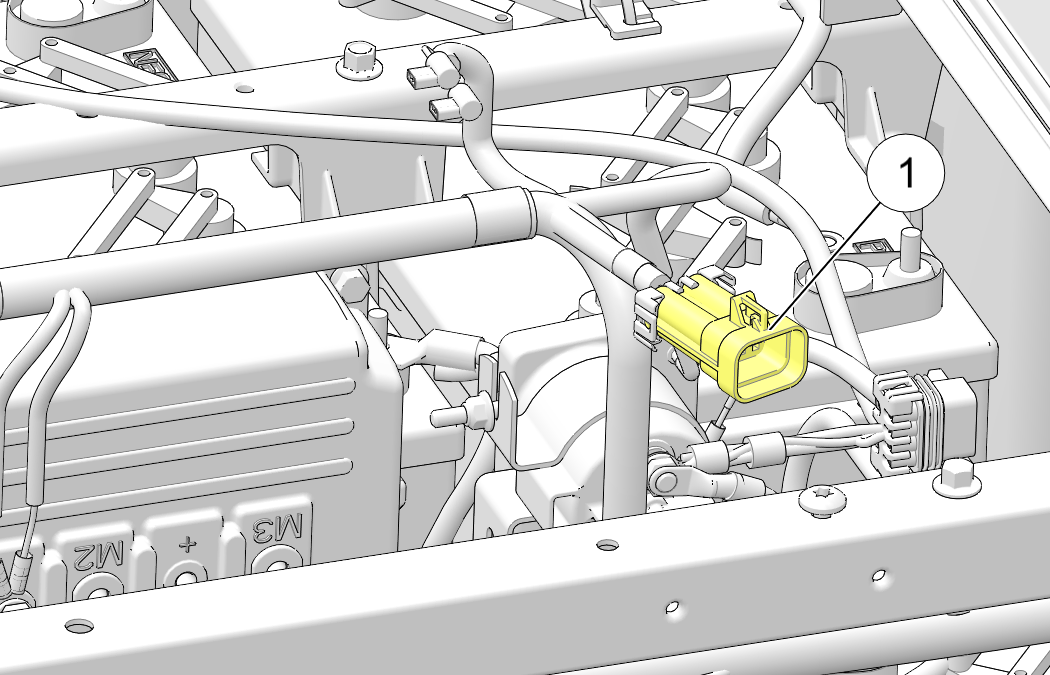
This vehicle is equipped with a receiver hitch bracket for a trailer hitch. Trailer towing equipment is not supplied with this vehicle.
To avoid injury and property damage, always heed the warnings and towing capacities.
Always apply the service brakes before engaging or releasing the park brake1. To help prevent the vehicle from rolling, set the park brake when parking the vehicle. When the park brake is set and the park brake indicator is illuminated, motor speed is limited. If the accelerator is applied, this limiting feature prevents operation, which protects the park brake pads from excessive wear.
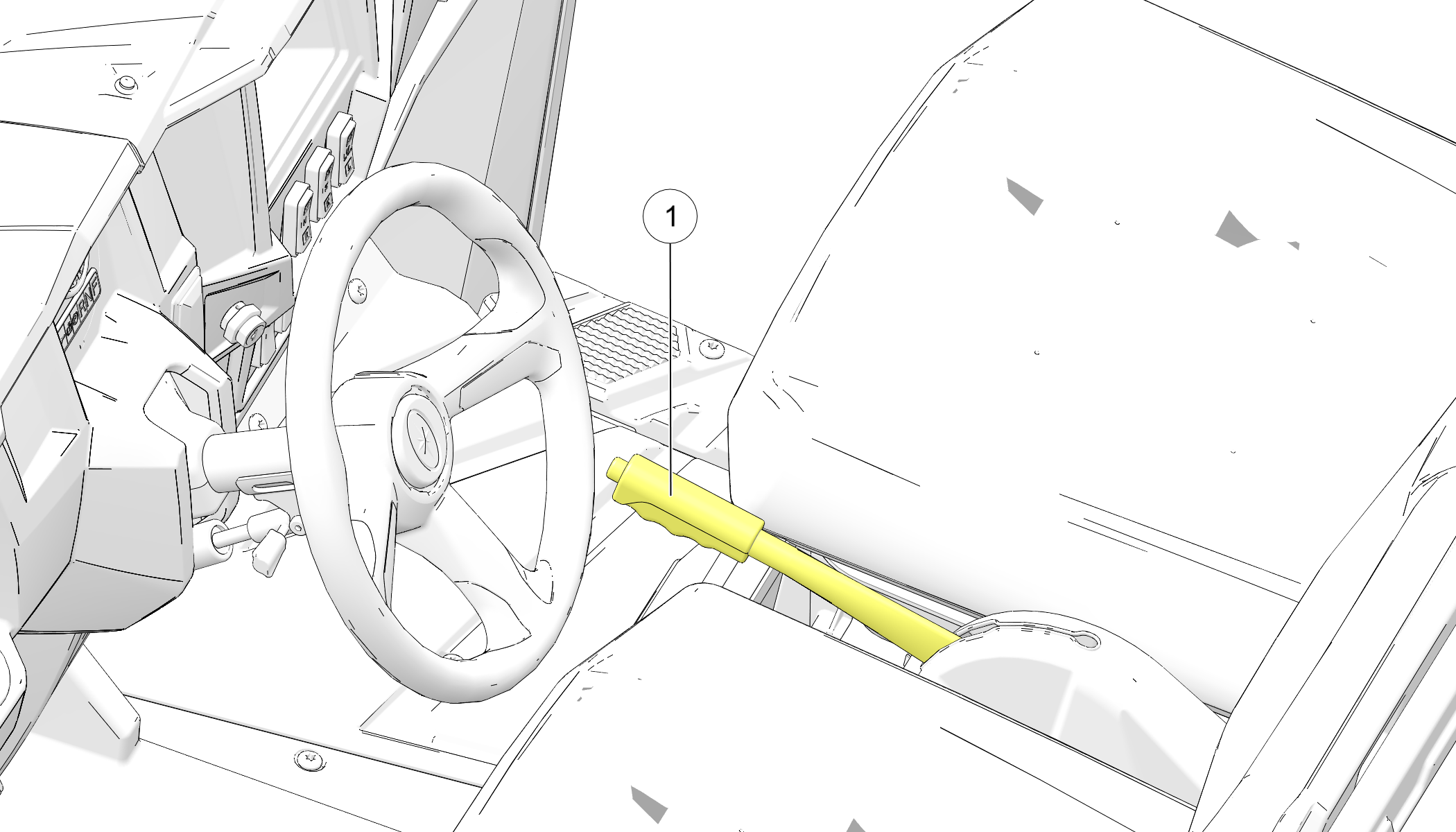
To set the park brake, apply the brakes.
Pull the park brake lever upward as far as possible.
To release the park brake, apply the brakes. Press the park brake release inward and move the lever downward as far as possible.
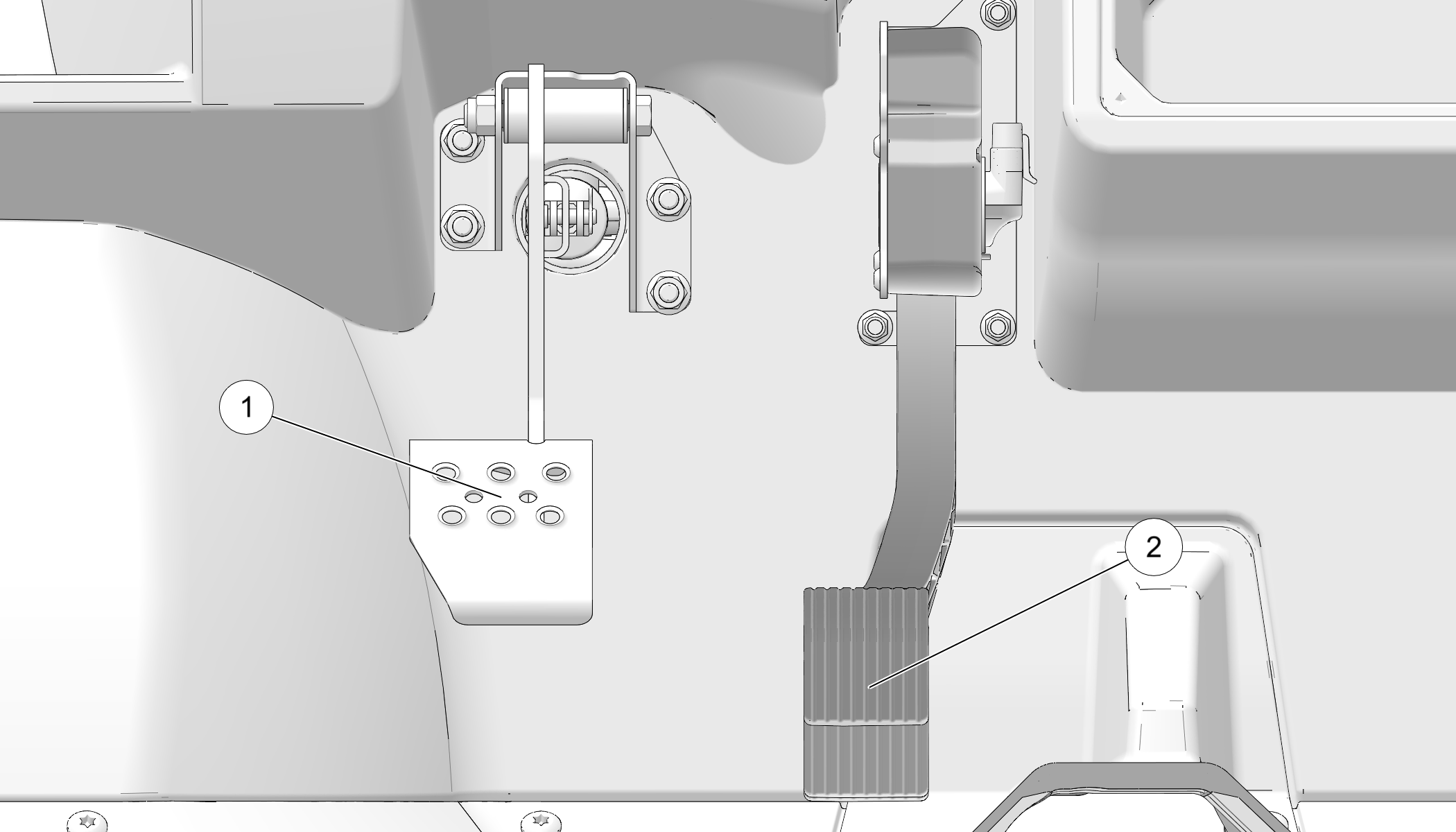
Push the brake1 toward the floor to slow or stop the vehicle. Apply the brakes before turning the key on.
The accelerator pedal 2 will function only when the key is ON and the direction selector switch is set to either forward or reverse. To begin moving or to increase vehicle speed, gradually push the accelerator pedal toward the floor. Holding the accelerator pedal down continuously will accelerate the vehicle to the maximum speed.
To slow the vehicle, release the accelerator pedal. Electric motor braking provides braking when the pedal is released. For additional speed control or to stop the vehicle, apply the service brakes.
Pull up on the front of the seat and slide it toward the front of the vehicle. Install the seat by sliding the tabs into the rear of the seat base. Push down firmly on the front of the seat until the pins are fully seated into the grommets.
Inspect all seat belts for proper operation before each use of the vehicle.
Push the latch plate into the buckle until it clicks. The latch plate must slide smoothly into the buckle. A click indicates that it's securely latched.
Push the red release latch in the middle of the buckle to make sure it releases freely.
Pull each seat belt completely out and inspect the full length for any damage, including cuts, wear, fraying or stiffness. If any damage is found, or if the seat belt does not operate properly, have the seat belt system checked and/or replaced by an authorized dealer.
To clean dirt or debris from the seat belts, sponge the straps with mild soap and water. Do not use bleach, dye or household detergents. Rinse the entire length of the belt webbing. Use a garden hose to flush out the retractor and latch housings regularly.
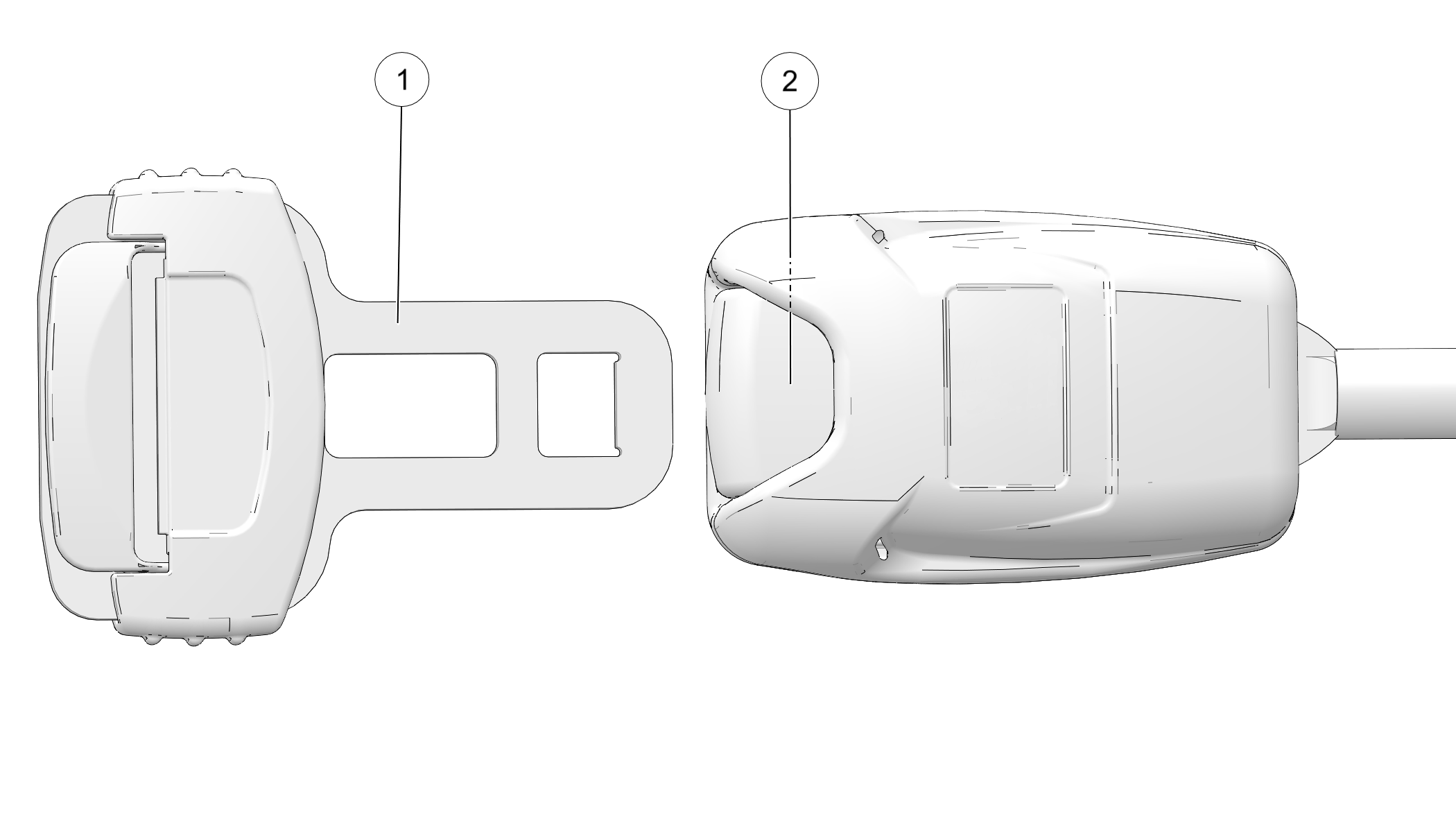
This vehicle is equipped with three-point lap and diagonal seat belts for the operator and passenger. Always make sure the seat belts are secured for all riders before operating. The driver’s seat belt is equipped with a seat belt interlock. Vehicle speed will be limited to 15 MPH (24 km/h) if the seat belt is not secured.
The center of the seat is NOT equipped with a seat belt. Never allow a passenger to ride between the operator and passenger seats.
To wear the seat belt properly, follow this procedure:
For 3-point belts, pull the seat belt latch 1 downward and across your chest toward the buckle at the inner edge of the seat. The belt should fit snugly across your hips and diagonally across your chest. Make sure the belt is not twisted.
Push the latch plate 1 into the buckle 2 until it clicks.
Release the strap, and pull to tighten.
To release the seat belt, press the square red button in the buckle’s center.
The malfunction codes will blink on the controller. The code definitions provided here are for informational purposes only.
|
# of Blinks |
Code Definition |
|---|---|
|
1 |
Data or configuration error |
|
2 |
Sequence fault |
|
3 |
Power fault |
|
4 |
Contactor issue |
|
6 |
Throttle input error |
|
7 |
Voltage protection |
|
8 |
Controller or motor out of temperature range |
|
13 |
Software fault |
The code definitions provided are for informational purposes only. Please see your dealer for diagnosis and repair.
| # of Blinks | Code Definition | Solution |
|---|---|---|
| 1 | Battery high voltage | Check battery size and condition; reset charger (interrupt AC power for 15 seconds) |
| 2 | Battery low voltage | |
| 3 | Charge time-out, battery pack not reaching required voltage, charger output reduced due to high temperatures | Check connections; operate charger at lower ambient temperature |
| 4 | Battery could not be trickle-charged to minimum voltage | Check battery for shorted or damaged cells |
| 5 | Charger shut down due to overheating | Ensure sufficient cooling air flow (open the hood) and reset the charger (interrupt AC power for 15 seconds) |
| 6 | Charger internal fault | Reset charger (interrupt AC power for 15 seconds); return to qualified service provider if fault persists |
The charging cord is located under the hood on the right side of the vehicle. See page 62 for charging instructions.
The vehicle is equipped with a 12-volt accessory outlet on the dash. Use the outlet to power an auxiliary light or other optional accessories or lights. For service, the dash outlet connection is under the dash.

The 12-volt terminal board is located under the hood. It contains constant 12-volt, switched 12-volt and ground terminals that can be used to power auxiliary lights and accessories. The terminals are limited to 10 amps.
The Rollover Protective Structure (ROPS) on this vehicle meets OSHA® 1928.53 rollover performance requirements. Always have your authorized dealer thoroughly inspect the ROPS if it ever becomes damaged in any way.
No device can assure occupant protection in the event of a rollover. Always follow all safe operating practices outlined in this manual to avoid vehicle rollover.
Failure to operate the vehicle properly can result in a collision, loss of control, accident or rollover, which may result in serious injury or death. Read and understand all safety warnings outlined in the safety section of this owner’s manual.
Failure to inspect and verify that the vehicle is in safe operating condition before operating increases the risk of an accident. Always inspect the vehicle before each use to make sure it's in safe operating condition.
| Item | Remarks | Ref. |
|---|---|---|
| Brake system/pedal travel | Ensure proper operation |
Brake Pedal
Brake Fluid |
| Brake fluid | Ensure proper level | Brake Fluid |
| Front suspension | Inspect | Lubrication Recommendations |
| Rear suspension | Inspect | Lubrication Recommendations |
| Steering | Ensure free operation | Steering Wheel Inspection |
| Tires | Inspect condition and pressure | Tires |
| Wheels/fasteners | Inspect, ensure fastener tightness | Tires |
| Frame nuts, bolts, fasteners | Inspect, ensure tightness | – |
| Throttle | Ensure proper operation | – |
| Indicator lights/switches | Ensure proper operation | Key Switch |
| Headlamps | Check operation, apply POLARIS dielectric grease when lamp is replaced | Headlight Lamp Replacement |
| Brake light/tail lamps | Check operation | – |
| Seat Latch | Push down on the seat back to ensure the latch is secure | Seat Belts |
| Seat Belt | Check length of belt for damage, check latches for proper operation | Seat Belts |
| Riding Gear | Wear approved helmet, goggles, and protective clothing | Safe Riding Gear |
| Grass and Leaves | Remove grass, leaves, foreign matter, and other flammable material or debris, especially near the drive system. | - |
Disconnect the charging cable (if connected).
Wear a helmet, eye protection, gloves, long-sleeve shirt, long pants and over-the-ankle boots.
Sit in the driver's seat and fasten the seat belt.
Apply the brakes.
Turn the key to the ON position. Wait about a second for the contactor to close before continuing.
Move the direction selector to forward or reverse.
Move the drive mode switch to the desired setting.
Release the park brake.
Check your surroundings and determine your path of travel.
Keeping both hands on the steering wheel, release the brake pedal and gradually push the accelerator toward the floor to begin driving.
Drive slowly. Practice maneuvering and using the accelerator and brakes on level surfaces.
Do not carry a passenger until you have at least two hours of driving experience with this vehicle. Never carry more than one passenger in this vehicle. Never allow a passenger to ride in the cargo box.
To stop the vehicle, release the accelerator pedal completely and brake to a complete stop.
Set the park brake.
Turn the key off.

When driving on slippery surfaces such as wet trails, loose gravel, or ice, be alert for the possibility of skidding and sliding. Follow these precautions when encountering slippery conditions:
Do not operate on excessively rough, slippery or loose terrain.
Slow down before entering slippery areas.
Maintain a high level of alertness, reading the trail and avoiding quick, sharp turns, which can cause skids.
Engage all-wheel drive before wheels begin to lose traction.
Correct a skid by turning the steering wheel in the direction of the skid. Never apply the brakes during a skid.
Whenever traveling uphill, follow these precautions:
Always travel straight uphill.
Avoid excessively steep hills.
Keep both feet on the floor.
Always check the terrain carefully before ascending any hill. Never climb hills with excessively slippery or loose surfaces.
Proceed at a steady rate of speed.
Never go over the crest of a hill at high speed. An obstacle, a sharp drop, or another vehicle or person could be on the other side of the hill.
If the vehicle stalls while climbing a hill, apply the brakes. Turn the key off and on, then change the drive mode to low mode. Place the direction selector switch in reverse and slowly allow the vehicle to roll straight downhill while applying light brake pressure to control speed.
Driving on a sidehill is not recommended. Improper procedure could cause loss of control or rollover. Avoid crossing the side of any hill unless absolutely necessary.
If crossing a sidehill is unavoidable, follow these precautions:
Slow down.
Exercise extreme caution.
Avoid crossing the side of a steep hill.
When driving downhill, follow these precautions:
Avoid excessively steep hills.
Always descend a hill with the direction selector switch on forward. Never descend a hill with the switch on neutral.
Drive straight downhill. Avoid descending a hill at an angle, which would cause the vehicle to lean sharply to one side. Travel straight downhill when possible.
Slow down.
Apply the brakes slightly to aid in slowing.
Your vehicle can operate through water up to a maximum recommended depth equal to the floorboards1.
Follow these procedures when operating through water:
Determine water depths and current before entering water.
Choose a crossing where both banks have gradual inclines.
Proceed slowly, avoiding rocks and obstacles.
Avoid operating through deep or fast-flowing water.
After leaving water, always dry the brakes by applying light pressure to the pedal repeatedly until braking action is normal.
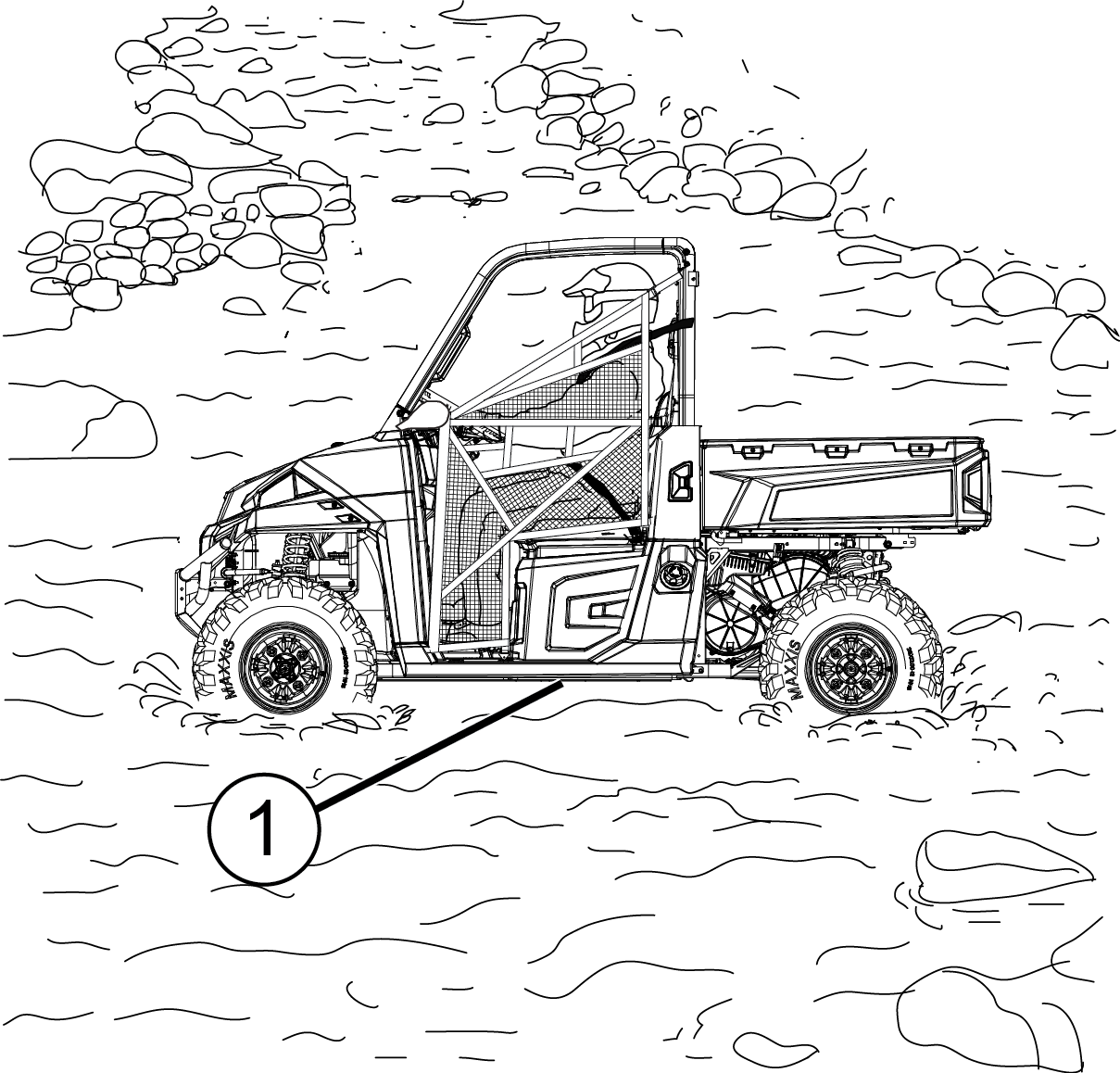
Follow these precautions when operating over obstacles:
Always check for obstacles before operating in a new area.
Look ahead and learn to read the terrain. Be constantly alert for hazards such as logs, rocks and low hanging branches.
Travel slowly and use extra caution when operating on unfamiliar terrain. Not all obstacles are immediately visible.
Move the gear selector to Low Gear, if needed.
Avoid operating over large obstacles such as large rocks and fallen trees. If unavoidable, use extreme caution and operate slowly.
Always have all passengers dismount and move away from the vehicle before operating over an obstacle that could cause a rollover.
Follow these precautions when operating in reverse:
Always check for obstacles or people behind the vehicle. Always inspect left and right fields of vision before backing.
Always avoid backing downhill.
Back slowly.
Apply the brakes lightly for stopping.
Avoid turning at sharp angles.
Never open the throttle suddenly.
Avoid parking on an incline if possible. If it's unavoidable, follow these precautions:
Apply the brakes.
Set the park brake.
Turn the key off.
Block the rear wheels on the downhill side.
Apply the brakes. Stop the vehicle on a level surface.
When parking inside a garage or other structure, be sure that the structure is well ventilated and that the vehicle is not close to any source of flame or sparks, including any appliance with pilot lights.
Set the park brake.
Turn the key off. Remove the key to prevent unauthorized use.
Hauling cargo improperly can alter vehicle handling and may cause loss of control or brake instability, which can result in serious injury or death. Always follow these precautions when hauling cargo:
Never exceed the maximum weight capacity of the vehicle. When determining the weight you are adding to the vehicle, include the weight of the operator, passenger, accessories, loads in the rack or box and the load on the trailer tongue. The combined weight of these items must not exceed the maximum weight capacity.
REDUCE SPEED AND ALLOW GREATER DISTANCES FOR BRAKING WHEN HAULING CARGO.
Always load the cargo box with the load as far forward and as low as possible.
When operating over rough or hilly terrain, reduce speed and cargo to maintain stable driving conditions.
Always operate the vehicle with extreme care when hauling or towing loads. Slow down and drive in the lowest gear available.
SECURE ALL LOADS BEFORE OPERATING. Unsecured loads can create unstable operating conditions, which could result in loss of control of the vehicle.
OPERATE ONLY WITH STABLE AND SAFELY ARRANGED LOADS. When handling off-centered loads that cannot be centered, securely fasten the load and operate with extra caution. Always attach the tow load to the hitch point designated for your vehicle.
HEAVY LOADS CAN CAUSE BRAKING AND CONTROL PROBLEMS. Use extreme caution when applying brakes with a loaded vehicle. Avoid terrain or situations that may require backing downhill.
USE EXTREME CAUTION when operating with loads that extend over the rack sides. Stability and maneuverability may be adversely affected, causing a rollover.
DO NOT TRAVEL FASTER THAN THE RECOMMENDED SPEEDS. Vehicle should never exceed 10 MPH (16 km/h) while towing a load on a level grass surface. Vehicle speed should never exceed 5 MPH (8 km/h) when towing loads in rough terrain, while cornering, or while ascending or descending a hill.
|
The RANGER has been designed to carry or tow specific capacities. Always read and understand the load distribution warnings listed on the warning labels. Move the drive mode switch to low mode if needed. The total load (operator, passenger, accessories, cargo and weight on hitch) must not exceed the maximum weight capacity of the vehicle. Never exceed the following capacities. |
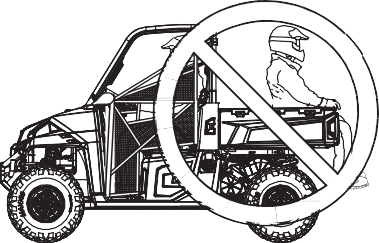
|
| Model | Maximum Capacities (Level Ground) | Cargo Box |
|---|---|---|
|
RANGER EV |
454 kg (1000 lbs.) |
226 kg 500 lbs. |
Towing improperly can alter vehicle handling and may cause loss of control or brake instability. Always follow these precautions when towing:
Never load more than 68.1 kg (150 lbs.) tongue weight on the towing bracket.
Do not operate the vehicle faster than 16 km/h (10 MPH) when towing. Towing a trailer increases braking distance.
Do not tow more than the recommended weight for the vehicle. See the towing capacity chart below and the Specifications section.
Attach a trailer to the trailer hitch bracket only. Do not attach a trailer to any other location or you may lose control of the vehicle.
Never tow a trailer on a grade steeper than 15°.
|
Model |
EV |
|
Total Towed Load Weight |
681 kg (1500 lbs.) |
|
Total Towed Load Weight |
386 kg (850 lbs.) |
|
Total Hitch Vertical Weight |
68.1 kg (150 lbs.) |
|
Maximum Towing Speed |
16 kph (10 MPH) |
|
Maximum Towing Speed (rough ground, cornering, ascending / descending) |
8 kph (5 MPH) |
Follow these procedures when towing the vehicle:
Turn the key off.
Always follow these precautions when towing this vehicle:
Do not operate faster than 10 MPH (16 km/h).
Do not tow on public streets.
Do not allow passengers in the towed vehicle.
Avoid abrupt starts and stops.
Avoid sharp turns and abrupt steering maneuvers.
Avoid towing on a hill.
If the weight distribution on the box is located toward the rear of the box when the release lever is pulled forward, the box may dump unexpectedly and cause serious injury to the operator or bystanders. Never operate the dump lever without ensuring that the load is positioned evenly or at the front of the box.
Select a level site to dump the cargo box. Do not attempt to dump or unload the vehicle while parked on an incline.
Apply the brakes.
Set the park brake.
Turn the key off.
Dismount the vehicle.
Ensure that the cargo is positioned evenly or toward the front of the cargo box.
Release the tailgate latches.
Stand clear and pull up on the cargo box release lever 1.
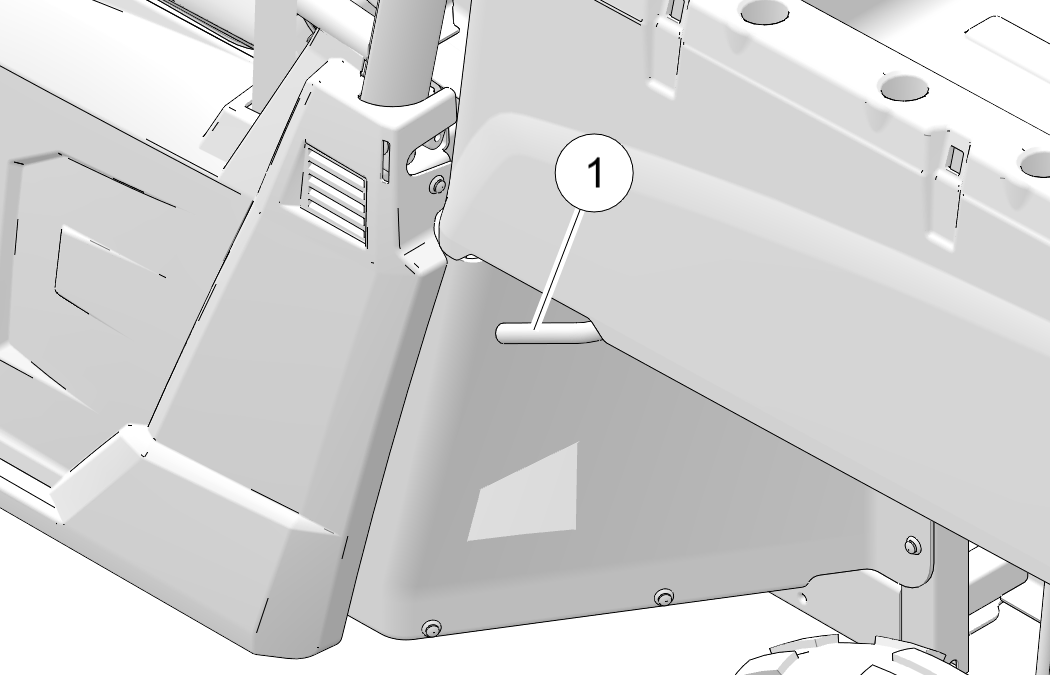
Lift the front of the cargo box to dump the cargo.
Lower the cargo box and push down securely to latch.
Close the tailgate and secure both tailgate latches.
When transporting the RANGER for a long distance or on public streets, always use a trailer with an approved load rating greater than the RANGER’s curb vehicle weight of 771 kg (1700 lbs.) plus any installed accessories or cargo.
Follow these guidelines when transporting the RANGER.
Set the park brake.
Remove the key to prevent loss.
Secure the seat, hood and tailgate latches. Ensure that the seats are attached correctly and are not loose.
Always tie the frame of the RANGER to the transporting unit securely with suitable straps.
If using an open trailer, remove the windshield (if equipped).
Never allow passengers on a trailer or in a trailered vehicle.
Reduce speed and drive with caution.
Cargo and other loose vehicle parts may fly off while transporting this vehicle. Secure or remove all cargo, and inspect the unit for loose parts prior to transport.
If transporting the vehicle in a non-enclosed trailer, then the vehicle must FACE FORWARD, or roof must be removed.
Failure to comply may allow airflow, vibration, or other factors to separate the roof from the vehicle and cause an accident, resulting in serious personal injury or death.
Press the top of the rocker switch to engage All Wheel Drive (AWD). Once enabled, the AWD remains enabled until the switch is turned off.
The AWD switch may be turned on or off while the vehicle is moving. When the AWD switch is on, the front gearcase will automatically engage any time the rear wheels lose traction. When the rear wheels regain traction, the front gearcase will automatically disengage.
Engage the AWD before getting into conditions where front wheel drive may be needed. If the rear wheels are spinning, release the accelerator before switching to AWD.
TOP: All-Wheel Drive (AWD)
MIDDLE: Differential Lock
BOTTOM: Differential Unlock

Locking the differential in slippery or low traction conditions helps improve traction. Move the rocker switch to the center position (2WD) to lock the differential and operate in rear wheel drive.
Press the bottom of the switch to unlock the differential and allow the rear drive wheels to operate independently. This mode of operation is well suited to turf driving or whenever aggressive traction is not required.
Move the AWD switch to the center or bottom position to disengage AWD. If the switch is turned off while the front hubs are driving, they will not release until the rear wheels regain traction.
In some situations, the front gearcase may remain locked after turning the AWD switch off. If this occurs, you may notice increased steering effort and some vehicle speed restriction. Perform the following procedure to unlock the front gearcase.
Stop the vehicle.
Move the direction selector to reverse. Operate in reverse for at least 10 feet (3 m).
Stop completely.
Move the direction selector to forward and drive forward.
If the front gearcase remains locked after following these instructions, return the vehicle to your dealer for service.
These safety warnings and instructions apply if your vehicle came equipped with a winch or if you choose to add an accessory winch to your vehicle.
Your winch may have a cable made of either wire rope or specially designed synthetic rope. The term “winch cable” will be used for either unless noted otherwise.
Read all sections of this manual.
Never use alcohol or drugs before or while operating the winch.
Never allow children under 16 years of age to operate the winch.
Always wear eye protection and heavy gloves when operating the winch.
Always keep body, hair, clothing and jewelry clear of the winch cable, fairlead and hook when operating winch.
Never attempt to “jerk” a load attached to the winch with a moving vehicle. See the Shock Loading section on Shock Loading.
Always keep the area around the vehicle, winch, winch cable, and load clear of people (especially children) and distractions while operating the winch.
Always turn the vehicle ignition power OFF when it and the winch are not being used.
Always be sure that at least five (5) full turns of winch cable are wrapped around the winch drum at all times. The friction provided by this wrapped cable allows the drum to pull on the winch cable and move the load.
Always apply your vehicle’s park brake and/or park mechanism to hold the vehicle in place during winching. Use wheel chocks if needed.
Always align the vehicle and winch with the load directly in front of the vehicle as much as possible. Avoid winching with the winch cable at an angle to the winching vehicle’s centerline whenever possible.
If winching at an angle is unavoidable, follow these precautions:
Look at the winch drum occasionally. Never let the winch cable “stack” or accumulate at one end of the winch drum. Too much winch cable at one end of the winch drum can damage the winch and the winch cable.
If stacking occurs, stop winching. Follow step 15 of Winch Operation to feed and rewind the cable evenly before continuing the winch operation.
Never winch up or down at sharp angles. This can destabilize the winching vehicle and possibly cause it to move without warning.
Never attempt to winch loads that weigh more than the winch’s rated capacity.
The winch motor may become hot during winch use. If you winch for more than 45 seconds, or if the winch stalls during operation, stop winching and permit the winch to cool down for 10 minutes before using it again.
Never touch, push, pull or straddle the winch cable while winching a load.
Never let the winch cable run through your hands, even if wearing heavy gloves.
Never release the clutch on the winch when the winch cable is under load.
Never use the winch for lifting or transporting people.
Never use the winch to hoist or suspend a vertical load.
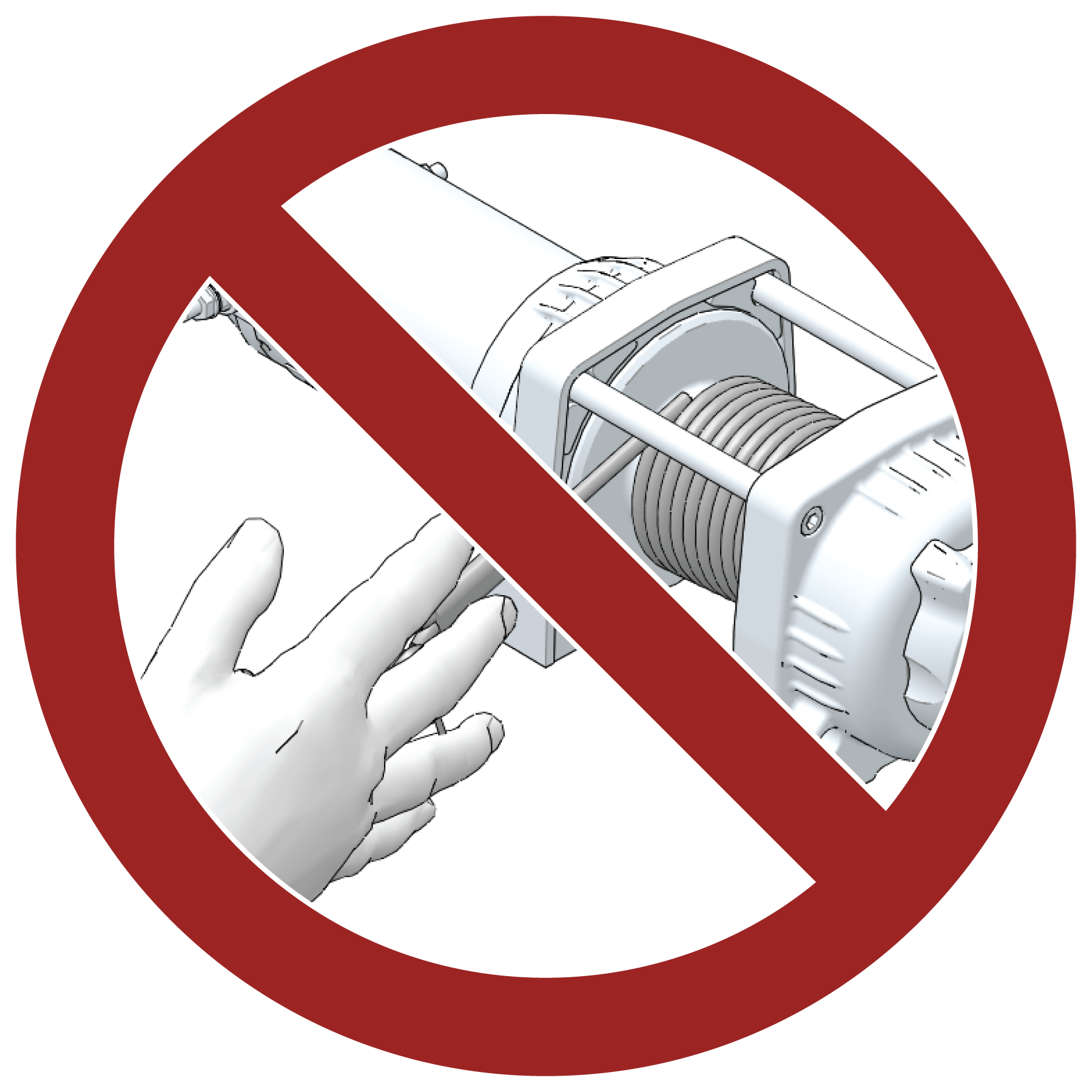
Always inspect your winch and winch cable before each use.
Never winch the hook fully into the winch. This can cause damage to winch components.
Unplug the remote control from the vehicle when the winch is not in use to prevent inadvertent activation and use by unauthorized persons.
Never grease or oil the winch cable. This will cause the winch cable to collect debris that will shorten the life of the cable.
Read the Winch Safety Precautions in the preceding pages before using your winch.
Consider practicing the operation and use of your winch before you actually need to use it in the field.
Improper winch use can result in SEVERE INJURY or DEATH. Always follow all winch instructions and warnings in this manual.
Each winching situation is unique.
Take your time to think through the winching you are about to do.
Proceed slowly and deliberately.
Never hurry or rush during winching.
Always pay attention to your surroundings.
You may need to change your winching strategy if it is not working.
Always remember that your winch is very powerful.
There are simply some situations that you and your winch will not be able to deal with. Do not be afraid to ask others to help when this happens.
Always inspect the vehicle, winch, winch cable and winch controls for any signs of damage or parts in need of repair or replacement before each use. Pay particular attention to the first 3 feet (1 meter) of winch cable if the winch is being used (or has been used) for lifting an accessory plow assembly. Promptly replace any worn or damaged cable.
Never operate a winch or a vehicle in need of repair or service.
Always apply your vehicle’s park brake and/ or park mechanism to hold the vehicle in place during winching. Use wheel chocks if needed.
Always use the hook strap when handling the hook.
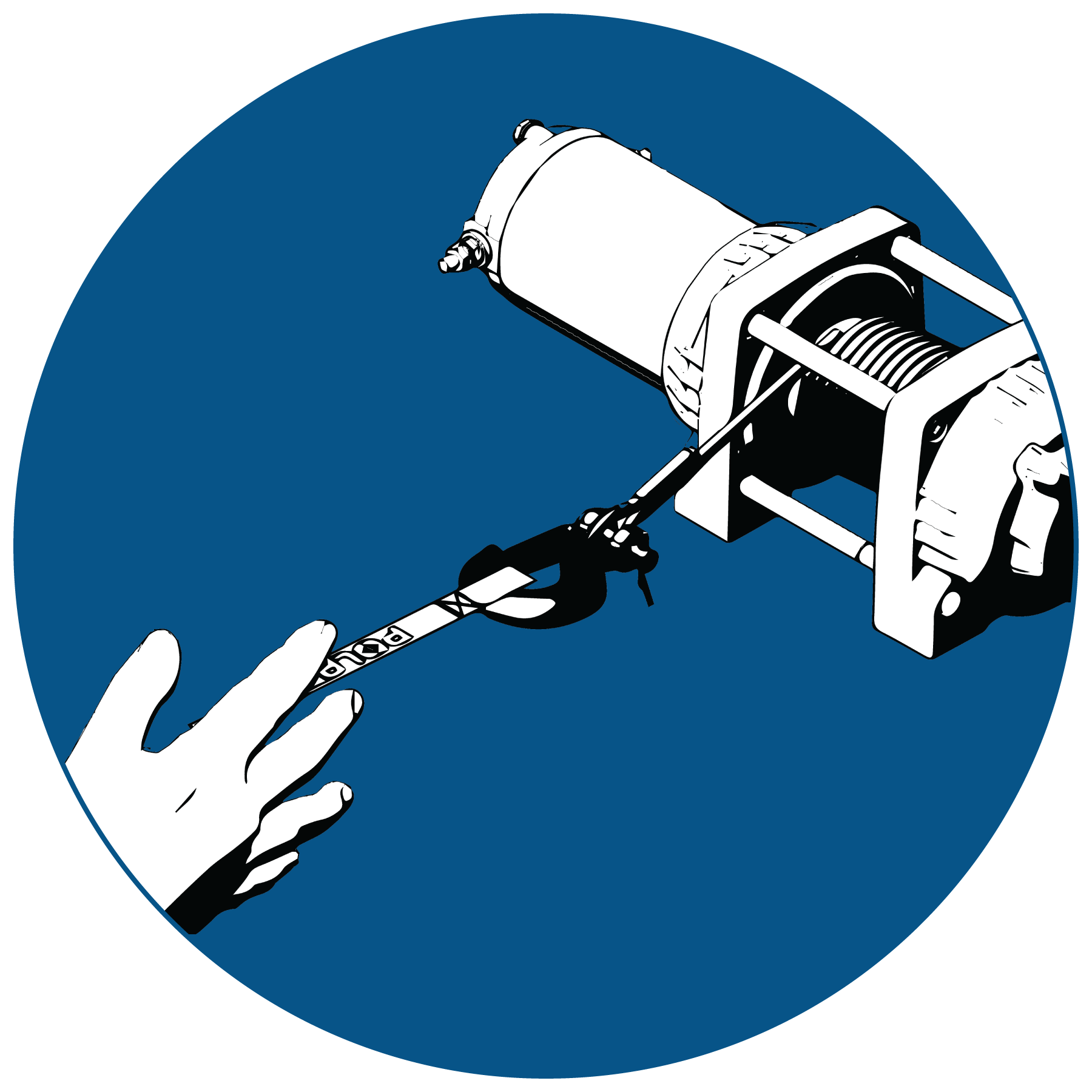
Never put your fingers into the hook. This could lead to SEVERE INJURY.
Attach the hook itself onto the load or use a tow strap or chain to secure the load to the winch cable.
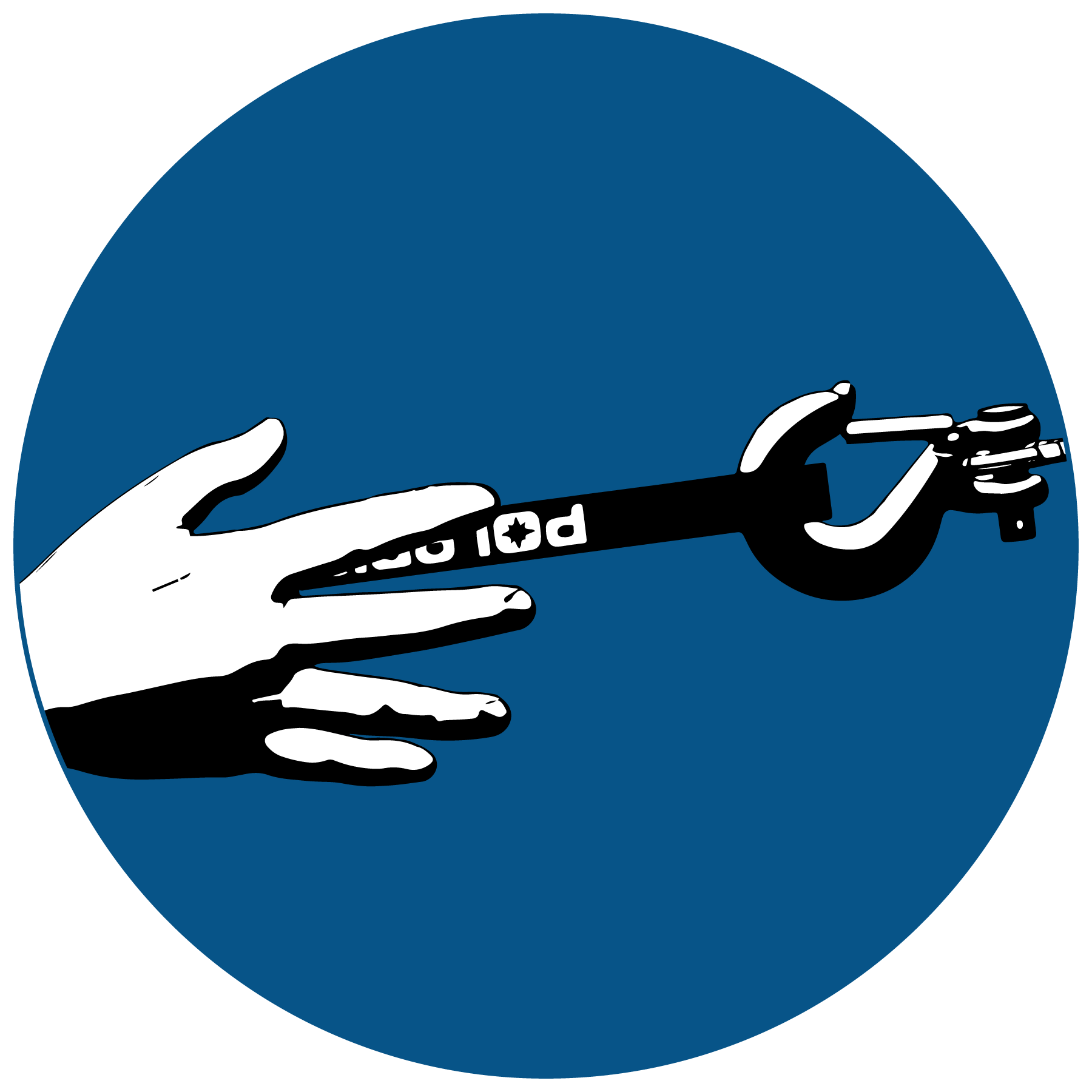
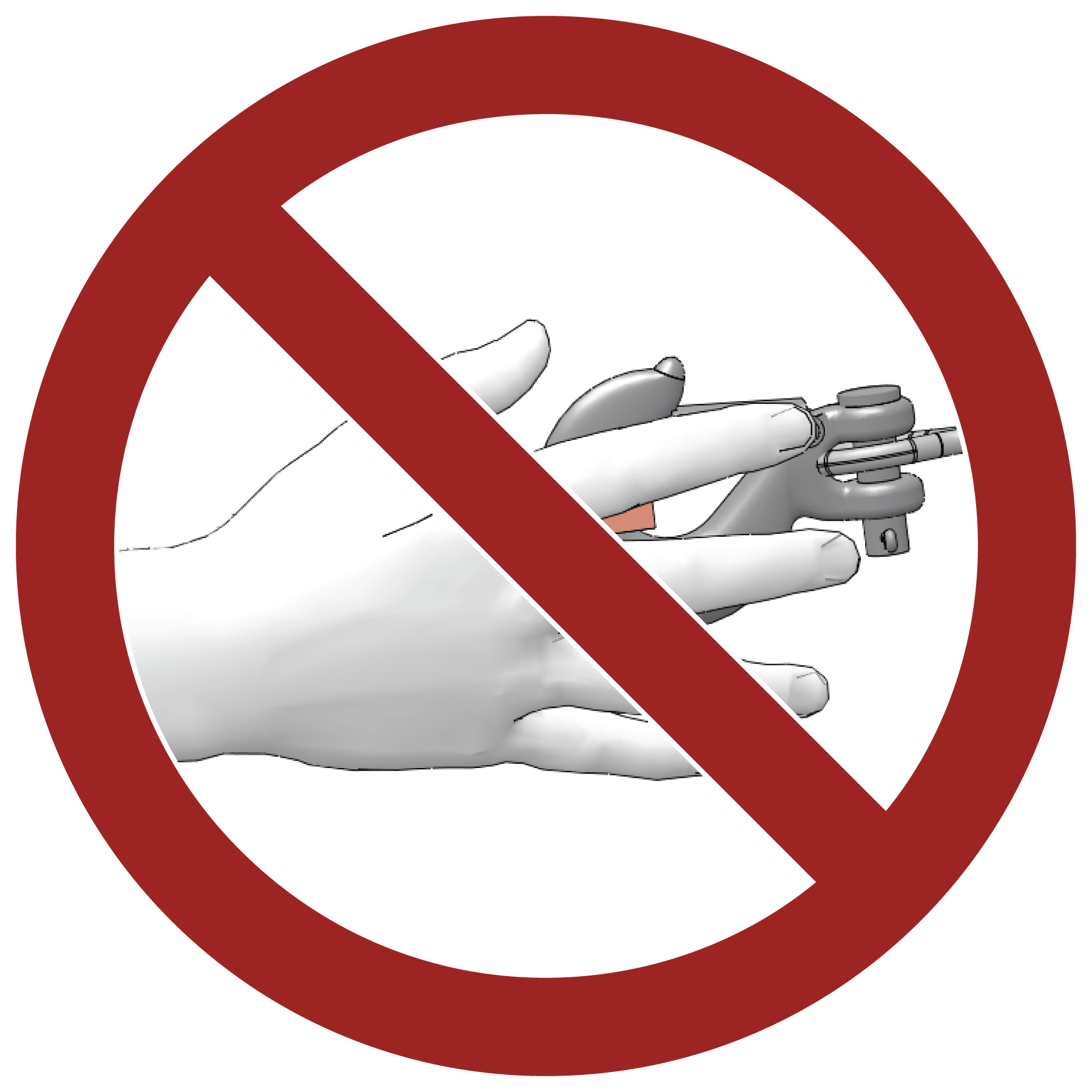
A “tow strap” is NOT intended to stretch. A “recovery strap” is designed to stretch.
Never hook the winch cable back onto itself. This will damage the winch cable and may result in winch cable failure.
If possible, keep the winch cable aligned with the centerline of the winching vehicle. This will help the spooling of the winch cable and reduce the load on the fairlead.
If freeing a stuck vehicle by attaching to a tree, use an item such as a tow strap to avoid damaging the tree during winch operation. Sharp cables and chains can damage and even kill trees. Please remember to Tread Lightly℠ (treadlightly.org).
Before operating the winch, be sure that the safety latch on the winch cable hook is fully seated when the load is attached.
Never operate your winch with a damaged hook or latch. Always replace damaged parts before using the winch.
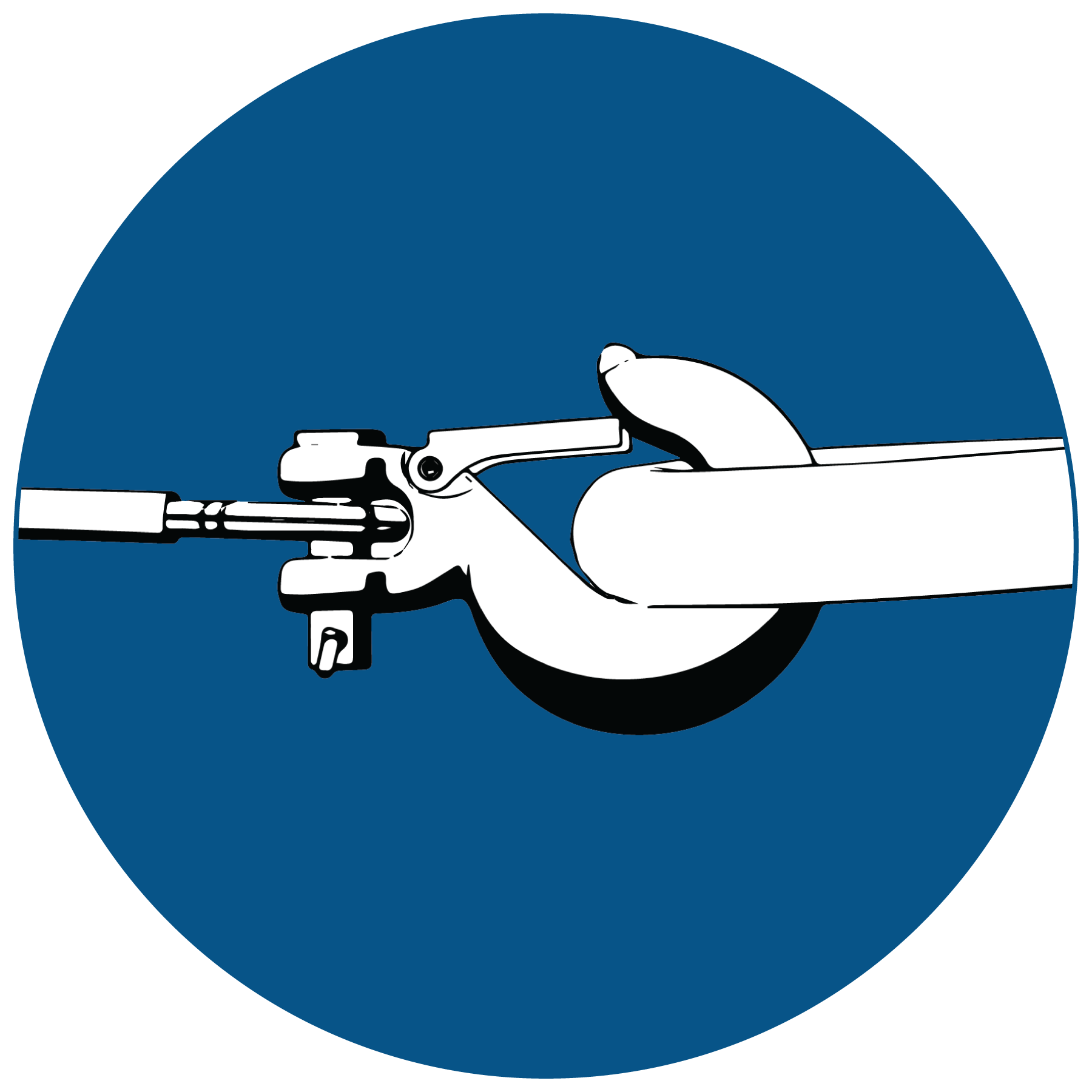
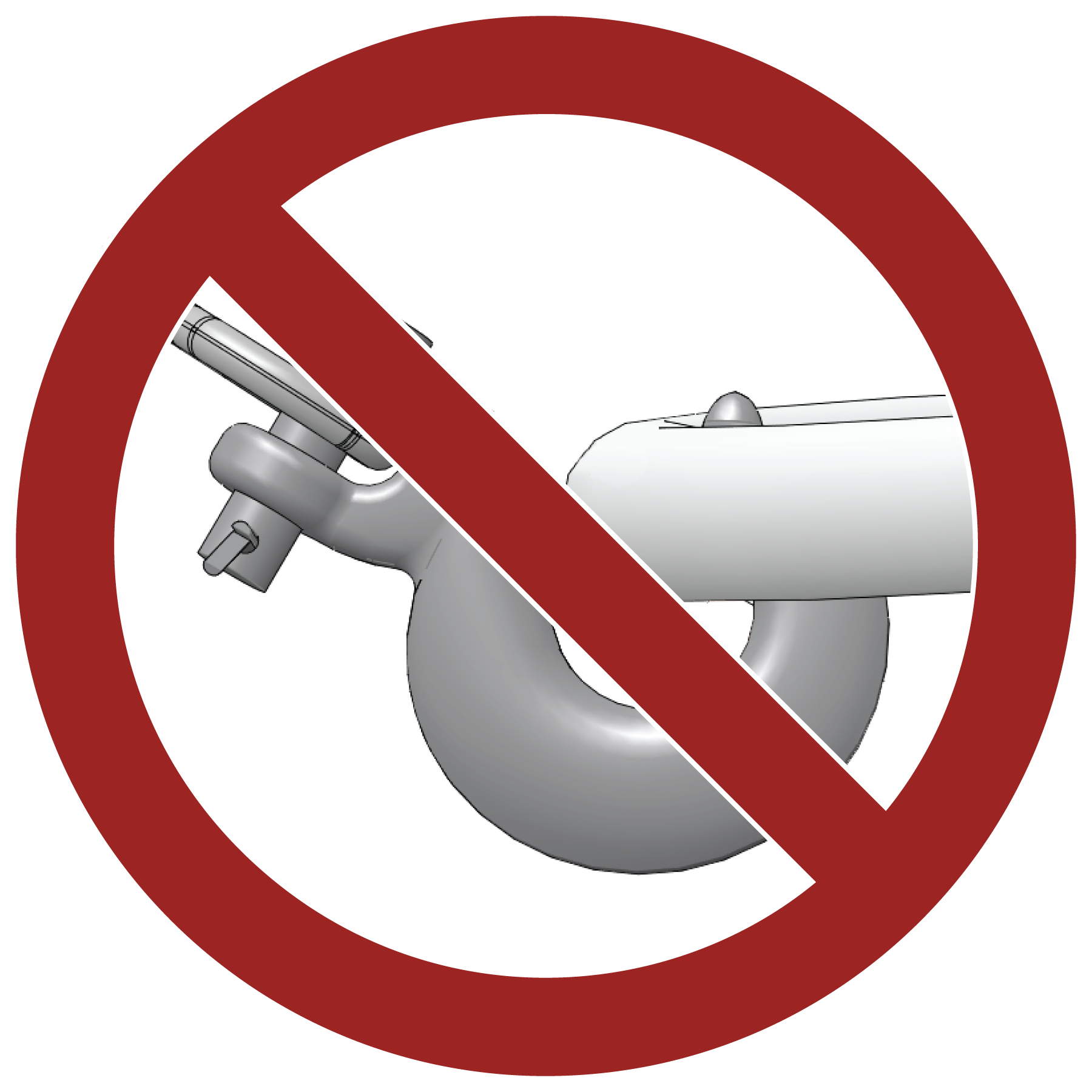
Never remove the hook strap from the hook.
Release the winch clutch and pull out the winch cable.
Pulling out as much cable as possible maximizes the winch’s pulling capacity. Always be sure that at least five (5) full turns of winch cable are wrapped around the winch drum at all times. The friction provided by this wrapped cable allows the drum to pull on the winch cable and move the load.
Read and adhere to the following information for winch damping to ensure safe winch use.
In order to absorb energy that could be released by a winch cable failure, always place a “damper” on the winch cable. A damper can be heavy jacket, tarp, or other soft, dense object. A damper can absorb much of the energy released if a winch cable breaks when winching. Even a tree limb can help as a damper if no other items are available to you.
Lay the damper on top of the mid-point of the winch cable length that is spooled out.
On a long pull, it may be necessary to stop winching so that the damper can be repositioned to the new mid-point of the winch cable. Always release the tension on the winch cable before repositioning the damper.
Avoid being directly in line with the winch cable whenever possible. Also, never permit others to stand near or in line with the winch cable during winch operation.
Never hook the winch cable back onto itself. This will damage the winch cable and may result in winch cable failure.
Never use straps, chains or other rigging items that are damaged or worn.
The ONLY time a winch-equipped vehicle should be moving when using the winch is when that vehicle itself is stuck. The winch equipped vehicle should NEVER be in motion to “shock” load the winch cable in an attempt to move a second stuck vehicle. See the Shock Loading section on Shock Loading. For your safety, always follow these guidelines when winching a vehicle free:
Release the winch clutch and spool out the necessary length of winch cable.
Align the winch cable as close as possible to the winching vehicle’s centerline.
Attach the winch cable hook to the anchor point or the stuck vehicle’s frame following instructions in this manual.
Re-engage the clutch on the winch.
Slowly winch in the slack in the winch cable.
Select the proper vehicle gear to propel the stuck vehicle in the direction of winching.
Shift to the lowest gear available on the stuck vehicle.
Slowly and carefully apply vehicle throttle and winch together to free the vehicle.
Stop winching as soon as the stuck vehicle is able to propel itself without the help of the winch.
Detach the winch cable hook.
Rewind the winch cable evenly back onto the winch drum following the instructions in this manual.
Never attempt to winch another stuck vehicle by attaching the winch cable to a suspension component, brush guard, bumper or cargo rack. Vehicle damage may result. Instead, attach the winch to a strong portion of the vehicle frame or hitch.
Extensive winching will run down the battery on the winching vehicle. Let the winching vehicle’s engine run while operating the winch to prevent the battery from running low if winching for long periods.
The winch motor may become hot during winch use. If you winch for more than 45 seconds, or if the winch stalls during operation, stop winching and permit the winch to cool down for 10 minutes before using it again.
After winching is complete, especially if winching at an angle, it may be necessary to re-distribute the winch cable across the winch drum. You will need an assistant to perform this task.
Release the clutch on the winch.
Feed out the winch cable that is unevenly bunched up in one area.
Re-engage the winch clutch.
Have an assistant pull the winch cable tightly with about 100 lbs. (45 kg) of tension using the hook strap.
Slowly winch the cable in while your assistant moves the end of the winch cable back and forth horizontally to evenly distribute the winch cable on the drum.
Doing this reduces the chances of the winch cable “wedging” itself between lower layers of winch cable.
Use of worn or damaged cable could lead to sudden failure and SEVERE INJURY.
For your safety, always replace POLARIS winch parts (including the cable) with genuine POLARIS replacement parts available at your authorized POLARIS dealer, or other qualified person.
Always inspect your winch before each use. Inspect for worn or loose parts including mounting hardware. Never use the winch if any part needs repair or replacement.
Always inspect your winch cable before each use. Inspect for worn or kinked winch cable.
A kinked winch cable made of wire rope is shown at right. Even after being “straightened out,” this cable has already been permanently and severely damaged. Promptly discontinue use of a winch cable in this condition.
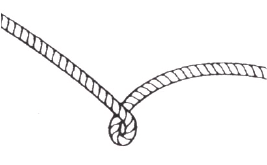
A kinked winch cable made of wire rope that has been “straightened out” is shown at right. Even though it may look usable, the cable has been permanently and severely damaged. It can no longer transmit the load that it could prior to kinking. Promptly discontinue use of a winch cable in this condition.
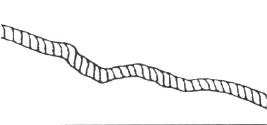
A winch cable made of synthetic rope should be inspected for signs of fraying. Replace the cable if fraying is observed (shown below). Promptly discontinue use of a winch cable in this condition. Also replace the winch cable if there are fused or melted fibers. Such an area of the synthetic rope will be stiff and appear smooth or glazed. Promptly discontinue use of a winch cable in this condition.
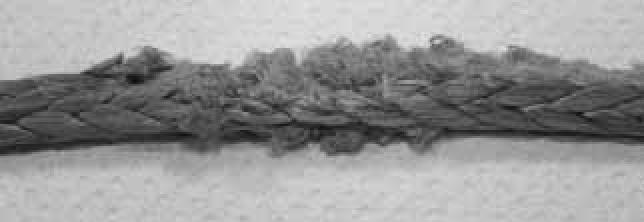
Your winch cable is very strong but it is NOT designed for dynamic, or “shock” loading. Shock loading may tension a winch cable beyond its strength and cause the cable to break. The end of a broken winch cable under such high loading can cause SEVERE INJURY or DEATH to you and other bystanders.
Winch cables are designed to NOT absorb energy. This is true of both wire-rope and synthetic-rope winch cables.
Never attempt to “jerk” a load with the winch. For example, never take up slack in the winch cable by moving the winching vehicle in an attempt to move an object. This is a dangerous practice. It generates high winch cable loads that may exceed the strength of the cable. Even a slowly moving vehicle can create large shock loads in a winch cable.
SEVERE INJURY or DEATH can result from a broken winch cable.
Never quickly turn the winch ON and OFF repeatedly (“jogging”). This puts extra load on the winch, winch cable, and generates excessive heat from the motor. This is a form of shock loading.
Never tow a vehicle or other object with your winch. Towing an object with a winch produces shock loading of the cable even when towing at slow speeds. Towing from a winch also positions the towing force high on the vehicle. This can cause instability of the vehicle and possibly lead to an accident.
Never use recovery straps with your winch. Recovery straps are designed to stretch and can store energy. This stored energy in the recovery strap is released if a winch cable fails making the event even more hazardous. Similarly, never use elastic “bungie” cords for winching.
Never use the winch to tie down a vehicle to a trailer or other transportation vehicle. This type of use also causes shock loading that can cause damage to the winch, winch cable, or vehicles used.
Your winch cable is designed and tested to withstand the loads produced by the winch motor when operated from a stationary vehicle. Always remember that the winch and winch cable are NOT designed for shock loading.
Always inspect your winch before each use. Inspect for worn or kinked winch cable. Also inspect for worn or loose parts including mounting hardware.
Permit your winch motor to cool down prior to servicing your winch.
Never work on your winch without first disconnecting the battery connections to prevent accidental activation of the winch.
For your safety, always replace POLARIS winch parts (including the cable) with genuine POLARIS replacement parts available at your authorized POLARIS dealer, or other qualified person.
Some winch models use wire rope as the winch cable. Other winches use a specially designed synthetic rope as the winch cable.
Never replace a synthetic-rope winch cable with a consumer-grade polymer rope such as can be purchased in a hardware store. Although they may look similar, they are NOT alike. A polymer rope not designed for winch use will stretch and store excessive energy when winching.
Careful periodic maintenance will help keep your vehicle in the safest, most reliable condition. Inspection, adjustment and lubrication of important components are explained in the periodic maintenance chart.
Inspect, clean, lubricate, adjust and replace parts as necessary. When inspection reveals the need for replacement parts, use genuine POLARIS parts available from your dealer.
Record maintenance and service in the Maintenance Log.
Vehicles subjected to heavy or severe use patterns must be inspected and serviced more frequently.
Frequent immersion in mud, water or sand
Racing or race-style high RPM use
Prolonged low speed, heavy load operation
| Symbol | Description |
|---|---|
| XU |
Perform these procedures more often for vehicles subjected to severe use. |
| D |
Have an authorized Polaris dealer or other qualified person perform these services. |
Perform all services at whichever maintenance interval is reached first. Record maintenance and service in the Maintenance Log.
| Item | Maintenance Interval (whichever comes first) |
Remarks |
||
|---|---|---|---|---|
| Hours | Calendar | |||
| D | Steering | - | Pre-Ride | Inspect operation; Make adjustments as needed. |
| XU | Front Suspension | - | Pre-Ride | |
| XU | Rear Suspension | - | Pre-Ride | |
| Tires | - | Pre-Ride | ||
| XU | Brake Fluid Level | - | Pre-Ride | |
| XU | Brake Pedal Travel | - | Pre-Ride | |
| Brake Systems | - | Pre-Ride | ||
| Wheels / Fasteners | - | Pre-Ride | ||
| Frame Fasteners | - | Pre-Ride | ||
| Batteries | - | Pre-Ride | ||
| Head Lamp / Tail Lamp | - | Daily | Check operation; apply dielectric grease to connector if replacing | |
|
XU
D |
Brake Pad Wear | 10 H | Monthly | Inspect periodically |
|
XU
D |
Parking Brake Cable Adjustment | 25 H | - | Inspect; adjust (if necessary) every 25 hours |
| Battery Terminals (Clean) | 25 H | Monthly | Clean terminals and cable ends | |
| Battery Terminals (Torque) | 25 H | Monthly | Re-torque terminal nuts | |
| Battery Fluid Level | 25 H | Monthly | Inspect and add distilled water as needed | |
| XU | Front Gearcase Lubricant | 25 H | Monthly | Inspect level; change yearly |
| XU | Transaxle (Rear Gearcase) Lubricant | 25 H | Monthly | Inspect level; change yearly |
| XU | General Lubrication | 50 H | 3 Months | Lubricate fittings, pivots, cable ends |
| D | Steering | 50 H | 6 Months | Inspect; Lubricate |
| XU | Front Suspension | 50 H | 6 Months | Check fastener torque; Check that cotter pins are in place on castle nuts. Check and lubricate tie rod ends. |
| XU | Rear Suspension | 50 H | 6 Months | Check fastener torque; Check that cotter pins are in place on castle nuts. Lubricate stabilizer bar pivots and A-arm joints. |
| XU | Shock absorbers | 50 H | - | Inspect for leaks, loose joints, and wear |
| XU | Wiring | 100 H | 12 Months | Inspect for wear, routing, security; apply dielectric grease to non-sealed connectors subjected to water, mud, etc. |
| D | Front Wheel Bearings | 100 H | 12 Months | Inspect; replace as needed |
| D | Brake Fluid | 200 H | 24 Months | Change every two years (DOT 4) |
| Suspension Bushings | 250 H | 24 Months | Inspect; replace as needed | |
|
XU
D |
Shock absorbers | 250 H | - | Replace or rebuild (if applicable) |
| D | Toe Adjustment | - | Inspect periodically; adjust when parts are replaced | |
| Headlight Aim | - | Adjust as needed | ||
XU Perform these procedures more often for vehicles subjected to severe use.
D Have an authorized Polaris dealer or other qualified person perform these services.
Check and lubricate all components at the intervals outlined in the Periodic Maintenance Chart, or more often under severe use, such as wet or dusty conditions. Items not listed in the chart should be lubricated at the general lubrication interval.
| Item | Lube | Method |
|---|---|---|
| Brake Fluid | DOT 4 Brake Fluid | Maintain level between fill lines. See Brake Fluid. |
| Main Gearcase Oil (Transaxle) |
ATV Angle Drive Fluid | See Gearcase Specification Chart. |
| Front Gearcase Oil | Demand Drive Fluid | See Gearcase Specification Chart. |
| Gearcase | Lubricant | Capacity | Fill Plug Torque | Drain Plug Torque |
|---|---|---|---|---|
| Main Gearcase (Transaxle) | ATV Angle Drive Fluid | 20.3 oz. (600 ml) |
14 ft lbs. (19.4 Nm) |
14 ft lbs (19.4 Nm) |
| Front Gearcase | Demand Drive Fluid | 5.1 oz. (150 ml) |
8–10 ft lbs. (11–13.6 Nm) |
11 ft lbs. (15 Nm) |
Always check and change the main gearcase oil at the intervals outlined in the Periodic Maintenance Chart. Maintain the oil level even with the bottom thread of the fill plug hole 1.
Refer to the Gearcase Specifications Chart for recommended lubricants, capacities and torque specifications.
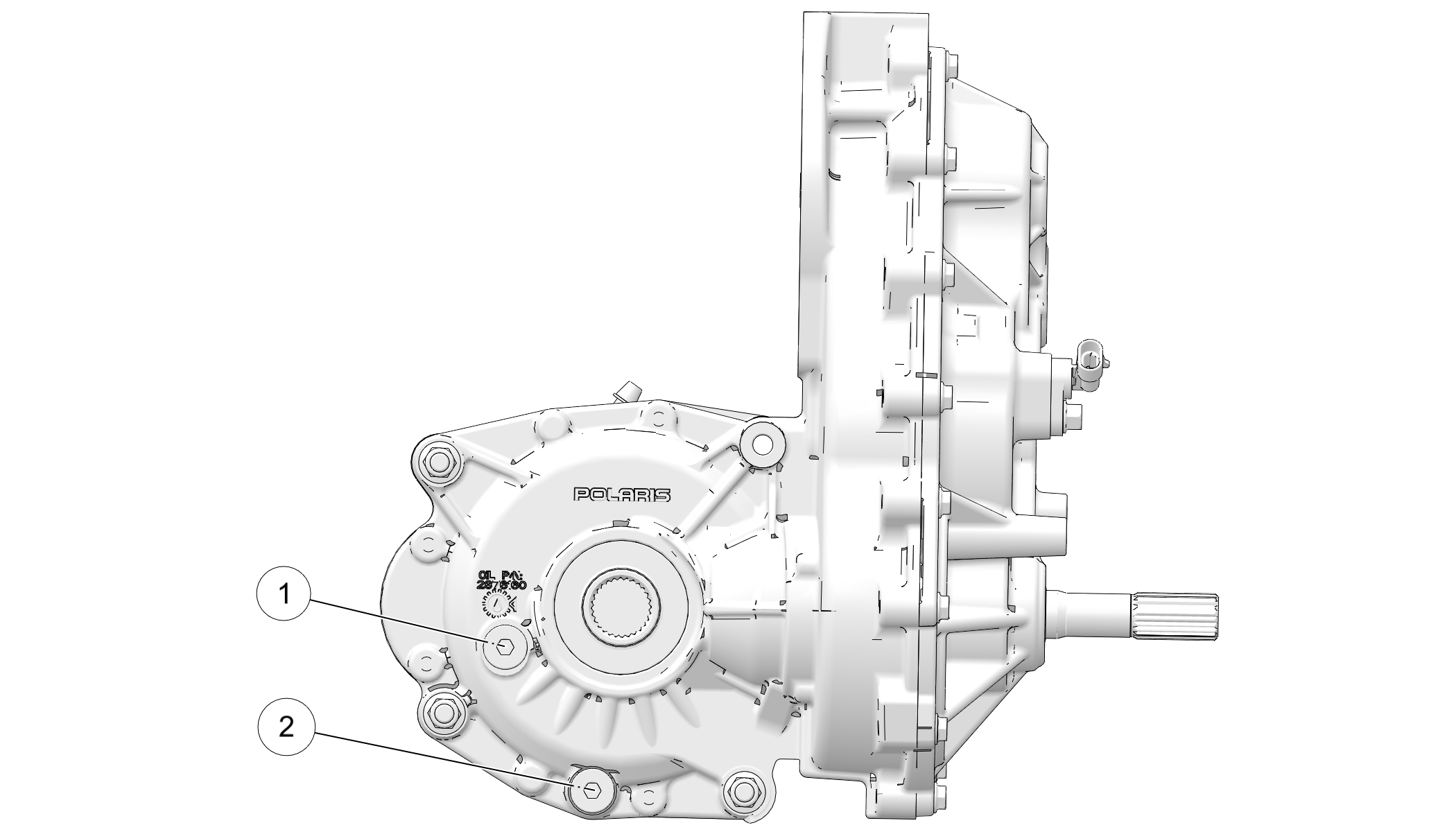
The fill plug is located at the right rear of the vehicle.
To check the oil, do the following:
Position the vehicle on a level surface.
Remove the fill plug 1.
Check the oil level.
Add the recommended oil as needed.
Reinstall the fill plug. Torque to specification.
The drain plug 2 is located on the lower right side of the main gearcase, near the fill plug 1. Refer to the Gearcase Specifications Chart for recommended lubricants, capacities and torque specifications.
To change the oil, do the following:
Remove the fill plug.
Place a drain pan under the drain plug. Remove the drain plug. Allow the oil to drain completely.
Wipe the magnetic end of the drain plug clean to remove accumulated metallic filings.
Reinstall the drain plug. Torque to specification.
Add the recommended oil as needed. Do not overfill.
Reinstall the fill plug. Torque to specification.
Check for leaks. Dispose of used oil properly.
Always check and change the front gearcase oil at the intervals outlined in the Periodic Maintenance Chart. Maintain the oil level even with the bottom thread of the fill plug hole 1.
Refer to the Gearcase Specifications Chart for recommended lubricants, capacities and torque specifications.
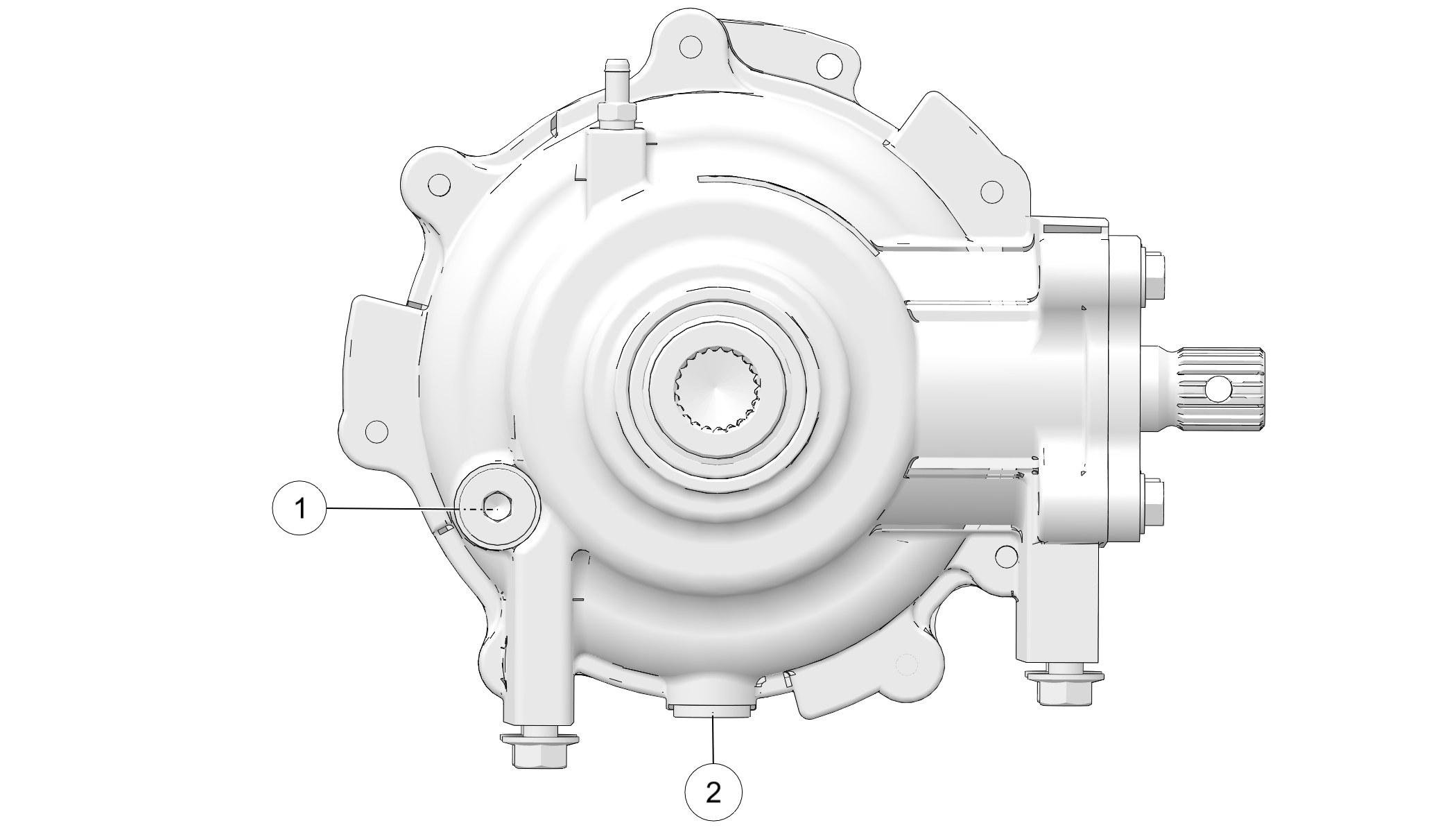
The front gearcase fill plug is located on the left side of the front gearcase.
To check the oil, do the following:
Position the vehicle on a level surface.
Remove the fill plug 1.
Check the oil level.
Add the recommended oil as needed.
Reinstall the fill plug. Torque to specification.
The drain plug 2 is located on the lower right side of the main gearcase, near the fill plug 1. Refer to the Gearcase Specifications Chart for recommended lubricants, capacities and torque specifications.
To change the oil, do the following:
Support the vehicle securely with a jackstand.
Remove the front tire on the driver's side.
Place a drain pan under the drain plug. Remove the drain plug. Allow the oil to drain completely.
Wipe the magnetic end of the drain plug clean to remove accumulated metallic filings.
Reinstall the drain plug. Torque to specification.
Add the recommended oil as needed. Do not overfill.
Reinstall the fill plug. Torque to specification.
Check for leaks. Dispose of used oil properly.
The front and rear brakes are hydraulic disc type brakes activated by the brake pedal.
Always check brake pedal travel and the brake fluid reservoir level before each use of the vehicle. When applied, the brake pedal should feel firm. Any sponginess would indicate a possible fluid leak or low brake fluid level, which must be corrected before riding. Proceed to the next page for brake fluid information.
If you discover any irregularities in brake system operation, including excessive pedal travel, contact your dealer for proper diagnosis and repairs.
Operating the vehicle with a spongy brake pedal can result in loss of braking, which could cause an accident resulting in severe injury or death. Never operate the vehicle with a spongy-feeling brake pedal.
Inspect the brake system routinely. Inspect the level of the brake fluid before each operation.
Change the brake fluid every two years and any time the fluid becomes contaminated, the fluid level is below the minimum, or if the type and brand of the fluid in the reservoir are unknown.
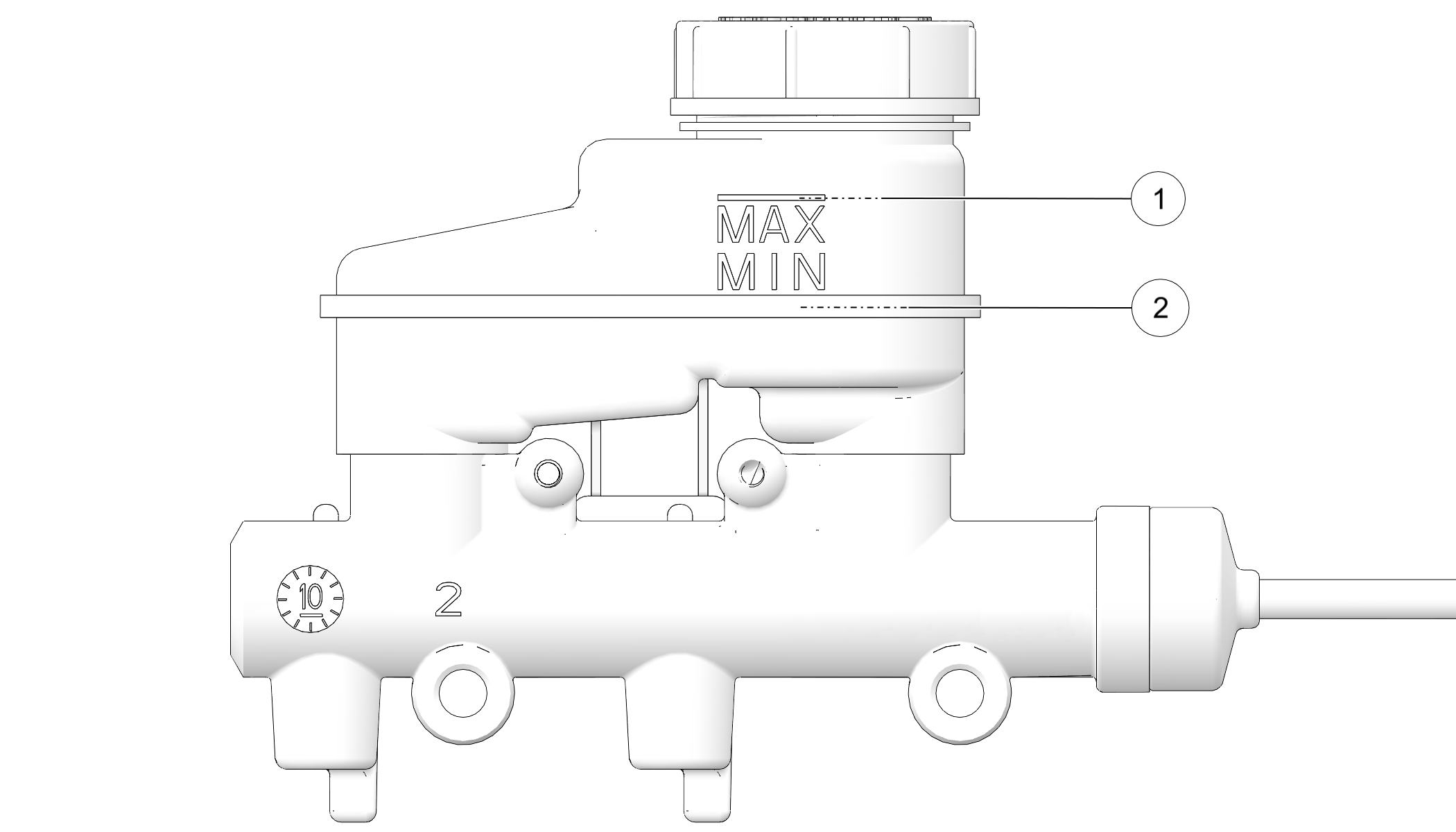
To check the brake fluid level, do the following:
Position the vehicle on a level surface.
View the brake fluid level at the reservoir in the driver’s side wheel well. The level should be between the upper (MAX) 1 and lower (MIN) 2 level lines.
If the fluid level is lower than the upper level line, add brake fluid to the upper (MAX) line 1.
Apply the brake forcefully for a few seconds and check for fluid leakage around the fittings.
To inspect the brakes, do the following:
Check the brake system for fluid leaks.
Check the brake pedal for excessive travel or a spongy feel.
Check the friction pads for wear, damage and looseness.
Check brake discs for signs of cracks, excessive corrosion, warping or other damage. Clean any grease using an approved brake cleaner or alcohol.
Inspect the brake disc spline and pad wear surface for excessive wear. Change pads 1 when worn to .030” (0.762 mm).
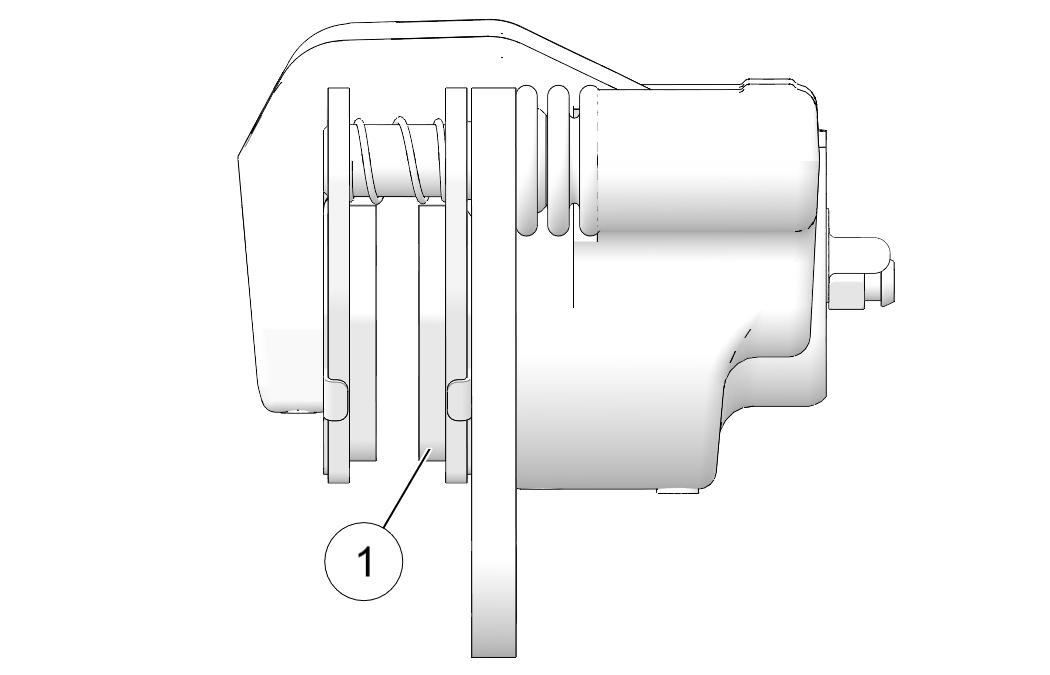
Check the steering wheel for specified freeplay and smooth operation at the intervals outlined in the Periodic Maintenance Chart section.
Position the vehicle on level ground.
Lightly turn the steering wheel left and right.
There should be 0.8-1.0 in (20-25 mm) of freeplay.
If there is excessive freeplay or strange noises, or the steering feels rough or “catchy,” have the steering system inspected by an authorized dealer.
Adjust the front and rear shock absorber springs by rotating the adjustment cam either clockwise or counter-clockwise to increase or decrease spring tension.
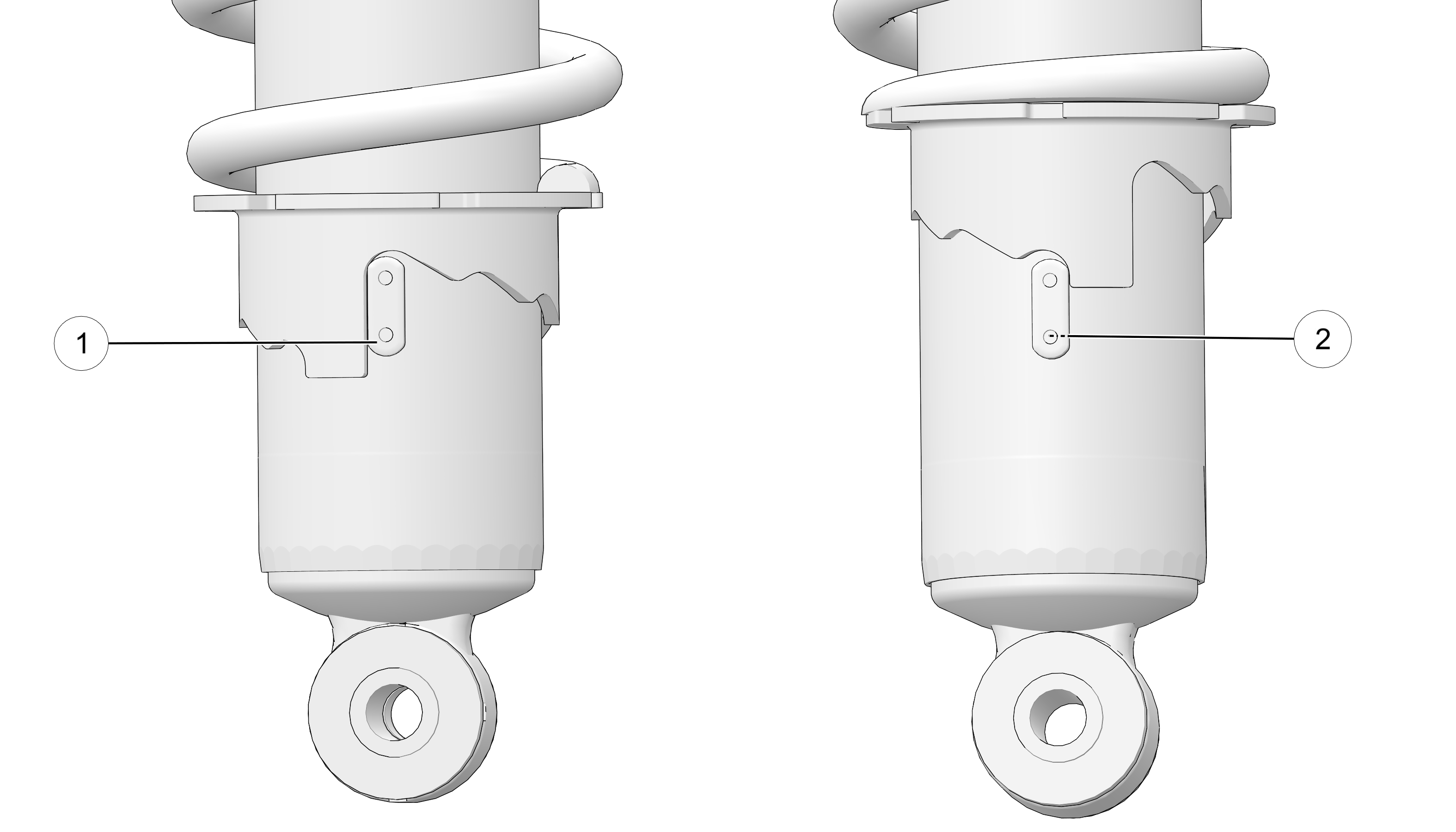
Always heed the following rules if you make adjustments to this suspension.
Always return the suspension to the lowest (softest 1) setting after the load is removed from the vehicle. The increased suspension height will negatively impact vehicle stability when operating without a load.
Always apply the same adjustment setting to both rear wheels.
Never operate the vehicle on the highest (stiffest 2) or second highest preload settings without a total combined payload in the vehicle of 450 lbs. (204 kg) or more. Payload includes the driver, approved accessories and cargo. Never exceed the stated load capacity for this vehicle.
Operating your vehicle with worn tires will increase the possibility of skidding, loss of control and an accident, which could result in serious injury or death. Always replace tires when the tread depth measures 1/8 in (3 mm) or less.
Improper tire inflation or the use of non-standard size or type of tires may adversely affect vehicle handling, which could result in vehicle damage or personal injury. Always maintain proper tire pressure. Always use POLARIS approved size and type of tires for this vehicle when replacing tires.
Inspect the following items occasionally for tightness, and if they've been loosened for maintenance service. Do not lubricate the stud or the lug nut.
| Lug Nut (Aluminum Wheels) |
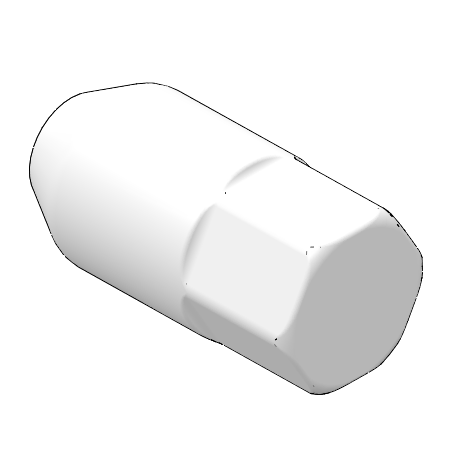
|
Front and Rear | 30 ft. lbs. (41 Nm) PLUS 1/4 TURN or 90 degrees |
| 2-Piece Flange Nut (Steel Wheels) |
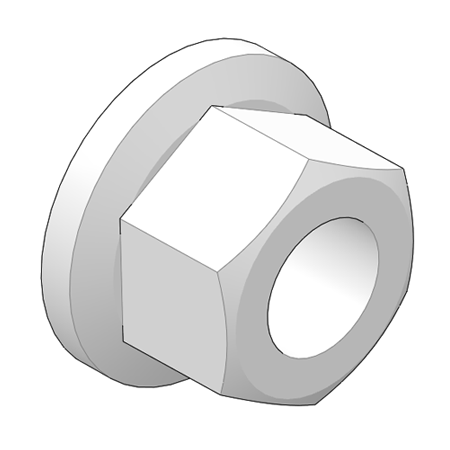
|
Front and Rear | 35 ft. lbs. (47 Nm) |
| Spindle Nut | Front | 70 ft. lbs. (95 Nm) | |
| Hub Retaining Nut | Front | 90 ft. lbs. (120 Nm) | |
| Hub Retaining Nut | Rear | 110 ft. lbs. (150 Nm) | |
Always replace tires when tread depth is worn to 3 mm (1/8”) or less.
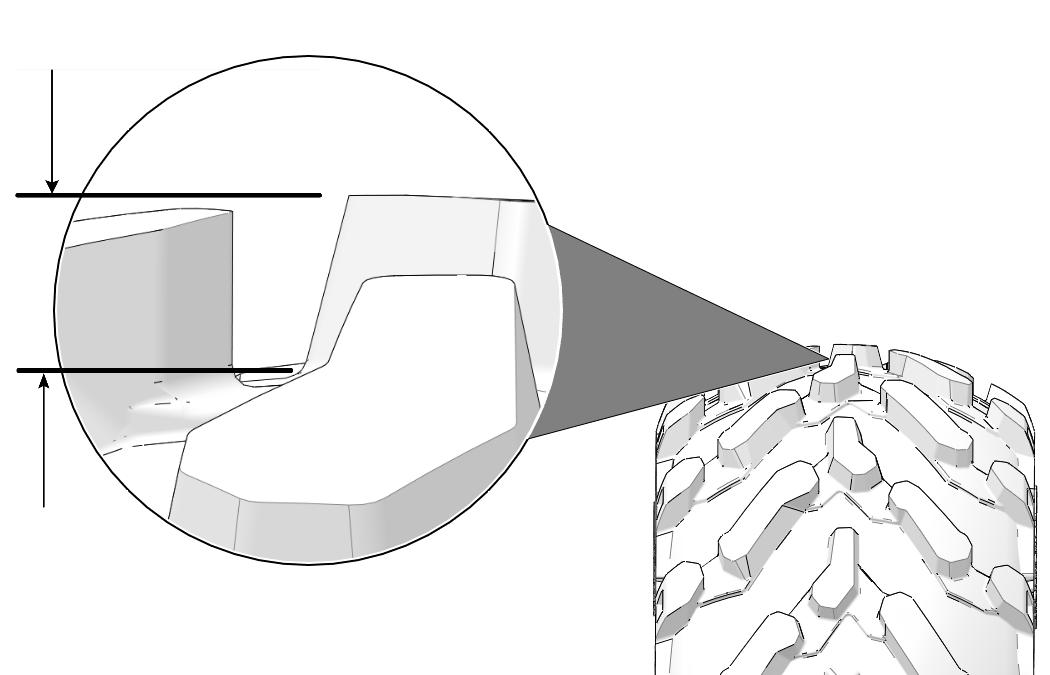
Position the vehicle on a level surface.
Apply the brakes. Set the park brake. Turn the key off.
Loosen the wheel nuts slightly.
Elevate the side of the vehicle by placing a suitable stand under the frame.
Remove the wheel nuts and washers. Remove the wheel.
Set the park brake.
Place the wheel on the hub with the valve stem toward the outside and rotation arrows on the tire pointing toward forward rotation.
Improperly installed wheels can adversely affect tire wear and vehicle handling, which can result in serious injury or death. Always ensure that all nuts are torqued to specification. Do not service axle nuts that have a cotter pin installed. Your dealer can assist.
Attach the wheel nuts and washers and finger-tighten.
Carefully lower the vehicle to the ground.
Torque the wheel nuts to specification.
Poor lighting can result in reduced visibility when driving. Headlight and taillight lenses become dirty during normal operation. Clean lights frequently and replace burned out lamps promptly. Do not operate this vehicle at night or in low light conditions until the headlight is replaced. Always make sure lights are adjusted properly for best visibility.
When servicing a halogen lamp, don't touch the lamp with bare fingers. Oil from your skin leaves a residue, causing a hot spot that will shorten the life of the lamp.
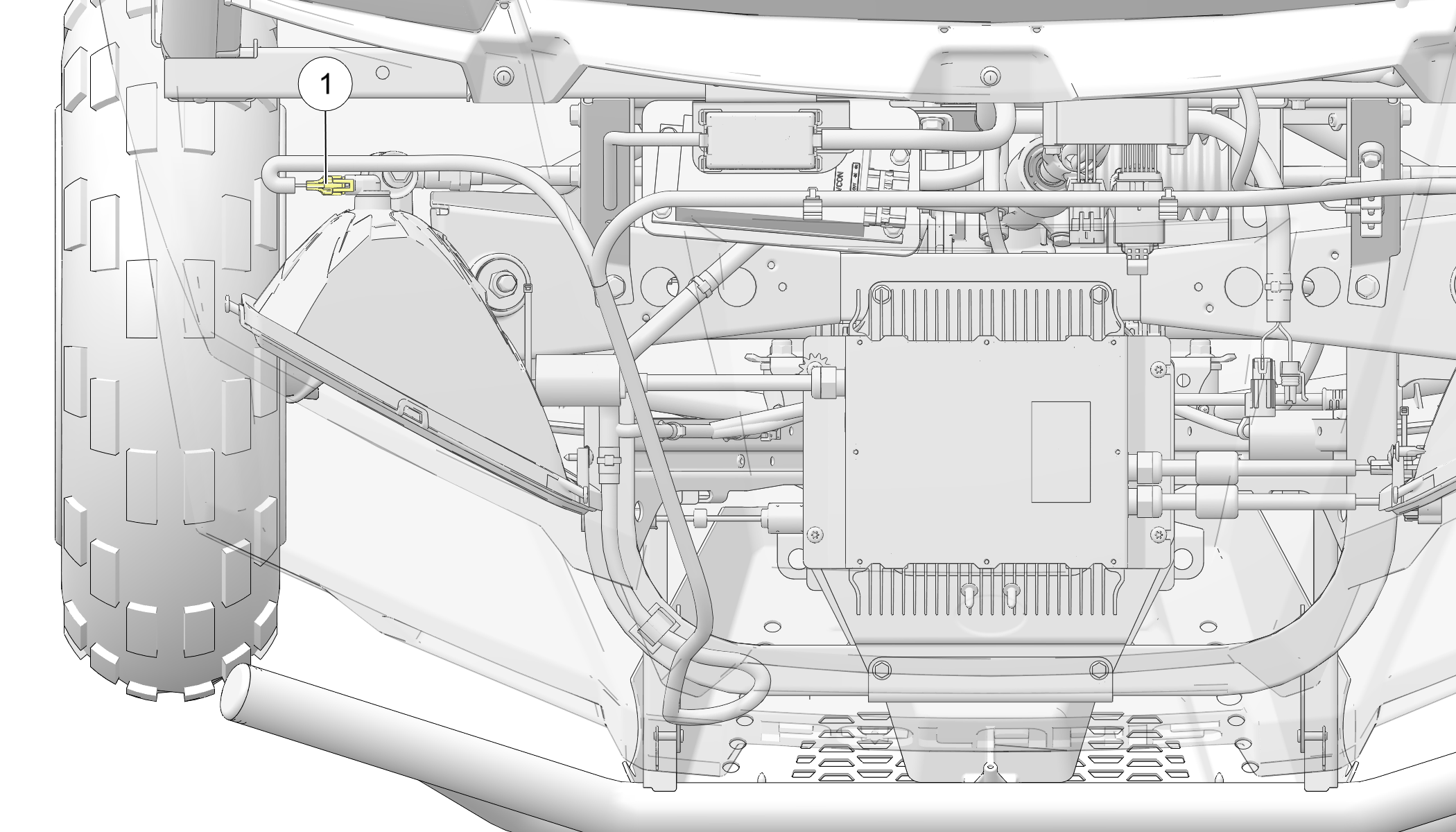
To replace the headlights, do the following:
Open the hood.
Unplug the headlamp from the wiring harness1. Be sure to pull on the connector, not on the wiring.
Turn the lamp counter-clockwise to remove it.
Install the new lamp.
Reinstall the harness assembly into the headlight assembly.
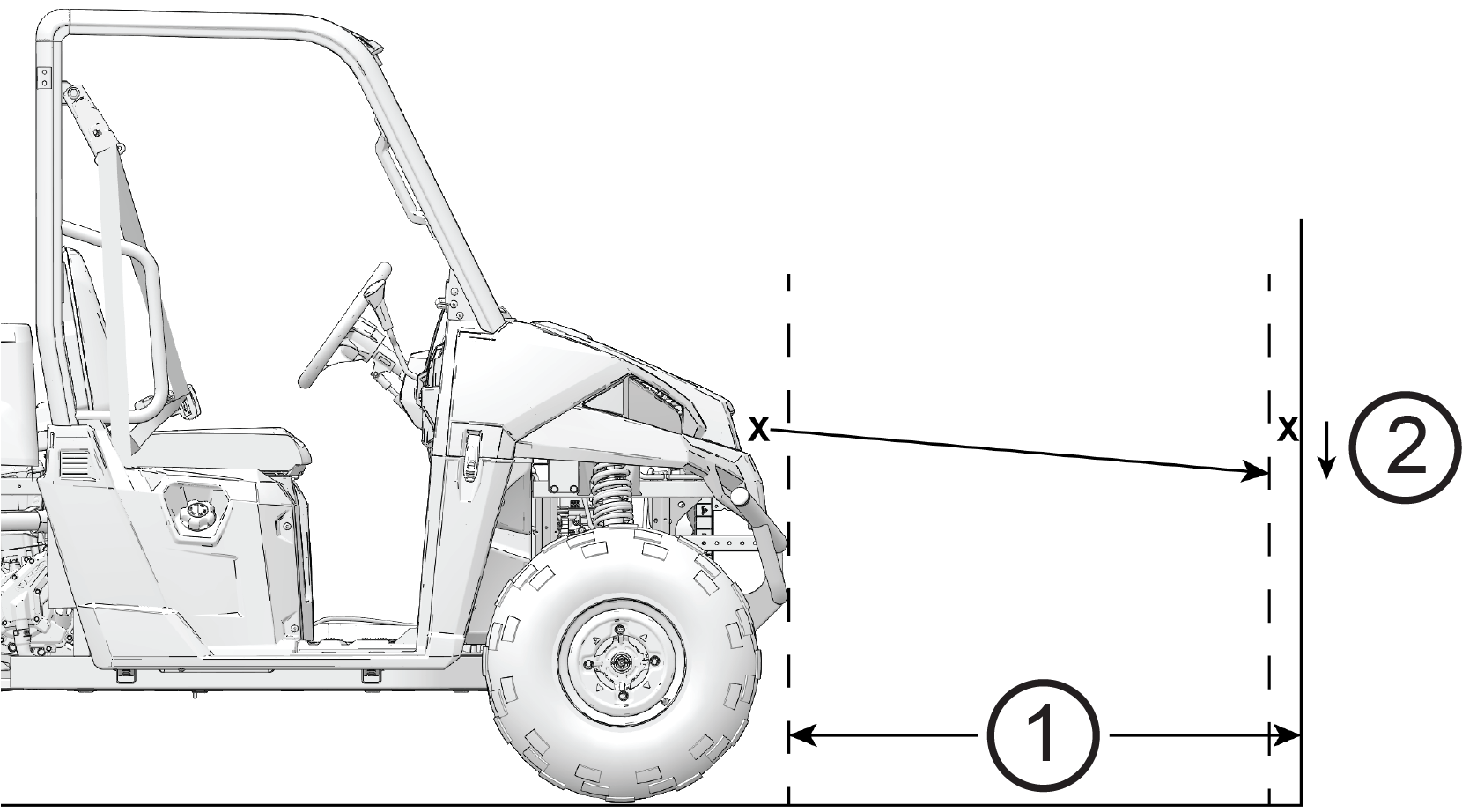
| 1 Distance from wall | 7.6 m (25 ft.) |
| 2 Measurement between wall mark and most intense portion of the headlight beam | 20 cm (8 in.) |
To adjust the headlight beam, do the following:
Place the vehicle on a level surface with the headlight approximately 7.6 m (25 ft.) from a wall.
Measure the distance from the floor to the center of the headlight and make a mark on the wall at the same height.
Apply the brakes. Turn the key on. Turn on the headlights.
Observe the headlight aim. The most intense part of the headlight beam should be aimed 20 cm (8 in.) below the mark placed on the wall. Include the weight of a rider on the seat while performing this step.
If a headlight needs adjustment, locate the adjustment screw at the back of the headlight.
Loosen the screw, adjust the headlight, and tighten the screw.
Repeat steps 4-6 until the lamp is properly adjusted.
When the brake pedal is depressed, the brake light comes on. Check the brake light before each ride.
To check the brake lights, do the following:
Turn the key to the ON position.
Depress the brake pedal. The brake light should come on after about 10mm (0.4 in.) of pedal travel. If the light doesn't come on, contact your dealer.
To replace the indicator lamp, do the following:
Lift the hood.
Reach in behind the console panel and lift the release to unplug the light from the harness.
Using a flathead screwdriver, press on the tab on the top of the light to remove the indicator light assembly from the console panel.
Locate the expired lamp. Using a screwdriver, rotate the lamp 1/4 turn counter-clockwise.
Grip the lamp with a needle-nose pliers and remove it from the assembly.
Install the new lamp. Using a screwdriver, rotate the lamp 1/4 turn clockwise to seat it.
Snap the assembly back into the console panel. Reconnect the harness.
Close the hood.
Battery electrolyte is poisonous. It contains sulfuric acid. Serious burns can result from contact with skin, eyes or clothing.
Antidote:
External: Flush with water.
Internal: Drink large quantities of water or milk. Follow with milk of magnesia, beaten egg, or vegetable oil. Call physician immediately.
Eyes: Flush with water for 15 minutes and get prompt medical attention.
Batteries produce explosive gases. Keep sparks, flame, cigarettes, etc. away. Ventilate when charging or using in an enclosed space. Always shield eyes when working near batteries. KEEP OUT OF REACH OF CHILDREN.
Your vehicle may have either a sealed battery, which requires little maintenance, or a conventional battery. A sealed battery can be identified by its flat covers on the top of the battery. A conventional battery has six filler caps on the top of the battery.
Always keep battery terminals and connections free of corrosion. If cleaning is necessary, remove the corrosion with a stiff wire brush. Wash with a solution of one tablespoon baking soda and one cup water. Rinse well with tap water and dry off with clean shop towels. Coat the terminals with dielectric grease or petroleum jelly. Be careful not to allow cleaning solution or tap water into a conventional battery.
Improperly connecting or disconnecting battery cables can result in an explosion and cause serious injury or death. When removing the battery, always disconnect the negative (black) cable first. When reinstalling the battery, always connect the negative (black) cable last.
When not in use, park the vehicle and connect the battery charger. The vehicle’s charging cord is located inside the right front bumper.
Always follow these precautions when charging the batteries:
Position the vehicle on a level surface.
Make sure the charging area is well ventilated.
Make sure the key is off.
Open the hood and any door enclosures or zippers.
Always use a extension cord with a minimum rating of 20 amps.
Inspect the charging cord and extension cord for cracks, loose connections and frayed wiring. Replace any damaged components promptly.
Always connect the vehicle charger to the extension cord first, then plug the cord into a wall receptacle.
Make sure the charger uses a dedicated circuit to prevent overloading. If charging multiple vehicles, each vehicle should use a dedicated circuit.
When disconnecting the charger, always disconnect the extension cord from the wall receptacle first, then disconnect the cord from the vehicle’s charging cord.
To access the batteries, do the following:
Remove the seat.
Remove the storage tray (if equipped)
Inspect battery terminal connections monthly. Clean batteries as recommended. Using an insulated wrench, torque bolts to 8 ft. lbs. (11 Nm).
Always keep battery terminals and connections free of corrosion. To clean, remove corrosion with a stiff wire brush. Wash with a solution of one tablespoon baking soda and one cup water. Rinse well with tap water and dry off with clean shop towels. Coat battery terminals with dielectric grease or petroleum jelly.
With proper care and maintenance as outlined in this owner’s manual, battery life could be extended up to four years or longer, depending on the amount of use. When battery replacement is necessary, please see your authorized POLARIS dealer.
A poorly maintained battery will deteriorate rapidly. Check the battery fluid level often. Add only distilled water. Tap water contains minerals that are harmful to a battery. Unless the plates are exposed before charging, distilled water should be added to a battery after charging. If the plates 3 are exposed, add water to about 1/8 inch (3 mm) above the plates, then charge. Check the fluid level again after charging. Maintain the fluid level 1/4 inch (6 mm) 1 below the bottom of the fill well2 in the cell cover. Do not overfill.
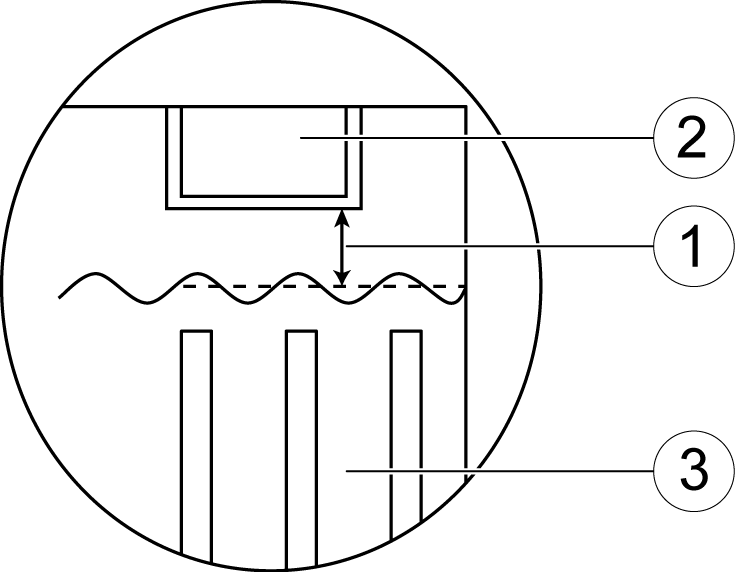
Keeping your POLARIS vehicle clean will not only improve its appearance but it can also extend the life of various components.
The best and safest way to clean your POLARIS vehicle is with a garden hose and a pail of mild soap and water.
Use a professional-type washing cloth, cleaning the upper body first and the lower parts last.
Rinse with clean water frequently.
Dry surfaces with a chamois to prevent water spots.
Avoid the use of harsh cleaners, which can scratch the finish.
Do not use a power washer to clean the vehicle.
Do not use medium to heavy duty compounds on the finish.
Always use clean cloths and pads for cleaning and polishing. Old or reused cloths and pads may contain dirt particles that will scratch the finish.
Avoid directing water toward electrical components, including batteries, wiring and switches.
If a high pressure water system is used for cleaning (not recommended), exercise extreme caution. The water may damage components and could remove paint and labels. Avoid directing the water stream at the following items:
Wheel bearings
Main gearcase seals
Brakes
Cab and body panels
Labels and decals
Switches and controls
Electrical components and wiring
If an informational or graphic label becomes illegible or comes off, contact your POLARIS dealer, or other qualified person, to purchase a replacement. Replacement safety labels are provided by POLARIS at no charge.
Grease all zerk fittings immediately after washing.
POLARIS recommends the use of common household aerosol furniture polish for polishing the finish on your POLARIS vehicle. Follow the instructions on the container.
Avoid the use of automotive products, some of which can scratch the finish of your vehicle.
Always use clean cloths and pads for cleaning and polishing. Old or reused cloths and pads may contain dirt particles that will scratch the finish.
Proper maintenance will protect chrome wheels from corrosion, preserve wheel life and ensure a “like new” appearance for many years. Chrome wheels exposed to road salt (or salt in the air in coastal areas) are more susceptible to corrosion if not properly cleaned. Clean chrome wheels more often if they're exposed to salt or other corrosive elements.
Wash chrome wheels frequently. Use a mild detergent. Never use abrasive cleaners on plated or painted surfaces.
Rinse well with clear water. Soap, detergents, salt, dirt, mud and other elements can cause corrosion.
Polish the clean chrome wheels periodically. Use an automotive grade chrome polish.
Routinely and liberally apply a weather resistant wax to each polished chrome wheel. Choose a product suitable for chrome finishes. Read and follow the product labels and instructions.
If light rust is found on the chrome finish, use steel wool (#0000-OTT grade) to remove it. Gently rub the affected areas with the steel wool until the corrosion has been removed. Clean and polish the wheel as outlined above.
Any time the vehicle will be parked for more than a few hours, follow the recommended storage procedures:
Make any necessary repairs and clean the vehicle.
Clean the batteries.
Store the vehicle out of the sun in a cool, dry place.
Be sure the storage area is well ventilated.
Turn the key off.
DO NOT set the park brake.
Verify that tire pressure is at specification.
Block the wheels to prevent rolling.
Fully charge the batteries. Leave the charger connected to maintain a full charge during the storage period, or check battery voltage each month during storage and recharge as needed to maintain a full charge. If the charger remains connected, check it monthly to verify proper operation.
Make any necessary repairs and clean the vehicle as recommended.
Inspect the fluid levels. Add or change fluids as recommended in the Periodic Maintenance Chart.
Demand drive fluid (front gearcase)
Rear gearcase fluid (if equipped)
Brake fluid (change every two years and any time the fluid looks dark or contaminated)
Be sure the storage area is well ventilated. Cover the vehicle with a genuine POLARIS cover. Do not use plastic or coated materials. They do not allow enough ventilation to prevent condensation, and may promote corrosion and oxidation.
Inspect all battery connections.
Verify that batteries are fully charged.
Verify that tire pressure is at specification.
Perform the pre-ride inspection.
Inspect and verify the tightness of the bolts, nuts and other fasteners.
Lubricate at the intervals outlined in the Periodic Maintenance Chart.
| Dimensions | |
|---|---|
| Dry Weight | 1750 lbs. (793.8 kg) |
| Test GVW - Rollover Protection System (ROPS) | 2750 lbs. (1247 kg) per OSHA® 29 CFR 1928.53 |
| Ground Clearance | 10 in. (25.4 cm) |
| Length | 108 in. (274.3 cm) |
| Width | 56.5 in. (143.5 cm) |
| Height | 73 in. (185.4 cm) |
| Wheelbase | 72 in. (183 cm) |
| Turning Radius | 150 in. (381 cm) |
| Load Capacity | |
|---|---|
| Box Dimensions (Inside) | 32 x 42 x 11.5 in. (81 x 107 x 29 cm) |
| Box Capacity | 500 lbs. (227 kg) |
| Payload Capacity | 1000 lbs. (455 kg) |
| Hitch Towing Capacity | 1250 lbs. (567 kg) |
| Cargo System | Lock & Ride® |
| Seating | 2 |
| Skid Plate | Plastic |
| Performance | |
|---|---|
| Motor configuration | Single, 48-volt, high efficiency, AC induction motor |
| Motor peak | 30 HP |
| Controller | 650 - Amp Sevcon Gen IV controller with multi-mode driving and regenerative braking |
| Battery pack | 11.7 kw battery pack at 48V DC with 8 12-volt, US12VXC batteries in series-parallel configuration |
| Maximum speed | 25 MPH (40.2 km/h) |
| Range (in Max Range mode on flat ground) | 50 miles (80.5 km) (may vary with driving conditions) |
| Throttle | Redundant, non-contact, inductive-sensing pedal |
| On-board charger | Delta Q 120-volt AC input; 48-volt DC output |
| Charge time | 8 hours (dependent on depth of discharge) |
| Drivetrain | |
|---|---|
| Main gearcase (transaxle) | Direct drive motor-to-transaxle with low-noise gears |
| Drive | On demand AWD, 2WD, turf mode |
| Brake System | |
|---|---|
| Brakes | 4-Wheel hydraulic disc w/dual bore front calipers |
| Park Brake | Lever-activated mechanical park brake (between seats) |
| Suspension | |
|---|---|
| Front suspension | MACPHERSON® Strut w/9 in. (22.7 cm) of travel |
| Rear suspension | Dual A-Arm w/9 in. (22.9 cm) travel |
| Tires | 220/75-12 Carlisle® All Trail II |
| Tire pressure | 20 psi (137.9 kPa) |
| Tire Speed / Load Index | 84F |
| Features | |
|---|---|
| Cup holders | Dual cup holders |
| Indicator panel | Indicates directional selection, park brake, and motor or controller malfunction |
| Charge indicator | Digital, indicates battery discharge |
| Hour meter | Digital, indicates cumulative hours of vehicle movement |
| Auxiliary power | 12-volt accessory outlet |
| Rider restraints | Automotive-style 3-point seat belts |
| Multi-mode switch | L/M/H (Low/Max Range/High) |
| Headlights | Halogen bulb - H4 60/55W |
| Taillights and Brake Lights | LED |
| Storage | Glove box |
| Noise at Operator’s Ear | |
|---|---|
| A-Weighted Sound Pressure at Rider’s Ear | 69 dB(A) |
| C-Weighted Sound Pressure Level | 76 dB(C) |
| A-Weighted Sound Power Level | N/A |
| Vehicle Vibration | |
|---|---|
| Weighted Hand-Arm Vibration Level (m/s²) | < 2.5 |
| Weighted Seat Vibration Level (m/s²) | < 0.5 |
| Product | Size (quantity) | Part Number |
|---|---|---|
| AGL | 1 qt (12) | 2878068 |
| 1 gal (4) | 2878069 | |
| Pump for Gallon Jug | 3.8 l | 2870465 |
| Demand Drive | 1 qt (12) | 2877922 |
| 2.5 gal (2) | 2877923 | |
| Antifreeze / Coolant | 1 qt (12) | 2880514 |
| 1 gal (6) | 2880513 | |
| Grease Gun Kit, Premium All Season | — | 2871312 |
| All Season Grease | Four 3 oz packs (6) | 2871322 |
| 14 oz cartridge | 2871423 | |
| U-Joint Grease | 3 oz tube (24) | 2871515 |
| 14 oz cartridge | 2871551 | |
| Dielectric Grease (Nyogel®) | — | 2871329 |
| DOT 4 Brake Fluid | — | 2872189 |
| Polaris Battery Tender Charger | — | 2859044 |
| Loctite® 565 Thread Sealant | — | 2871956 |
| Possible Cause | Solution |
|---|---|
| Low battery voltage | Recharge the battery overnight |
| Loose battery connections | Check all connections and tighten |
| Loose contactor connections | Check all connections and tighten |
| Loose electronic control box connections | Inspect, clean, reinstall connectors |
| Required torque exceeds motor capability | Apply the brakes and select low range |
The malfunction codes will blink on the controller. The code definitions provided here are for informational purposes only.
| # of Blinks | Code Definition |
|---|---|
| 1 | Data or configuration error |
| 2 | Sequence fault |
| 3 | Power fault |
| 4 | Contactor issue |
| 6 | Throttle input error |
| 7 | Voltage protection |
| 8 | Controller or motor out of temperature range |
| 13 | Software fault |
The code definitions provided are for informational purposes only. Please see your dealer for diagnosis and repair.
| # of Blinks | Code Definition | Solution |
|---|---|---|
| 1 | Battery high voltage | Check battery size and condition; reset charger (interrupt AC power for 15 seconds) |
| 2 | Battery low voltage | |
| 3 | Charge time-out, battery pack not reaching required voltage, charger output reduced due to high temperatures | Check connections; operate charger at lower ambient temperature |
| 4 | Battery could not be trickle-charged to minimum voltage | Check battery for shorted or damaged cells |
| 5 | Charger shut down due to overheating | Ensure sufficient cooling air flow (open the hood) and reset the charger (interrupt AC power for 15 seconds) |
| 6 | Charger internal fault | Reset charger (interrupt AC power for 15 seconds); return to qualified service provider if fault persists |
POLARIS Industries Inc., 2100 Highway 55, Medina, MN 55340 (POLARIS) gives a ONE YEAR LIMITED WARRANTY on all components of your vehicle (except the battery pack) against defects in material or workmanship. Laws and regulations in your jurisdiction may give extra protection. The battery pack is covered under the Three Year Limited Warranty set forth below. This ONE YEAR LIMITED WARRANTY covers parts and labor charges for repair or replacement of defective parts and begins on the date of purchase by the original retail purchaser. This warranty is transferable to another owner during the warranty period through an authorized dealer, but any such transfer will not extend the original term of the warranty. The duration of this warranty may vary by international region based upon local laws and regulations.
At the time of sale, the Warranty Registration Form must be completed by your dealer and submitted to POLARIS within ten days of purchase. Upon receipt of this registration, POLARIS will record the registration for warranty. No verification of registration will be sent to the purchaser as the copy of the Warranty Registration Form will be your proof of warranty coverage. If you have not signed the original registration and received the customer copy, please contact your dealer immediately. NO WARRANTY COVERAGE WILL BE ALLOWED UNLESS YOUR VEHICLE IS REGISTERED WITH POLARIS. Initial dealer preparation and set-up of your vehicle is very important in ensuring trouble-free operation. Purchasing a machine in the crate or without proper dealer set-up will void your warranty coverage.
This POLARIS limited warranty excludes any failures that are not caused by a defect in material or workmanship. THIS WARRANTY DOES NOT COVER CLAIMS OF DEFECTIVE DESIGN. This warranty also does not cover acts of God, accidental damage, normal wear and tear, abuse or improper handling. This warranty also does not cover any vehicle, component, or part that has been altered structurally, modified, neglected, improperly maintained or used for racing, competition or purposes other than for which it was designed.
This warranty excludes damages or failures resulting from improper lubrication; improper engine timing; improper fuel; surface imperfections caused by external stress, heat, cold or contamination; operator error or abuse; improper component alignment, tension, adjustment or altitude compensation; snow, water, dirt or other foreign substance ingestion/contamination; improper maintenance; modified components; use of aftermarket or unapproved components, accessories, or attachments; use of unapproved software or calibration; unauthorized repairs; or repairs made after the warranty period expires or by an unauthorized repair center.
This warranty excludes damages or failures caused by abuse, accident, fire, or any other cause other than a defect in materials or workmanship and provides no coverage for consumable components, general wear items, or any parts exposed to friction surfaces, stresses, environmental conditions and/or contamination for which they were not designed or not intended, including but not limited to the following items:
Wheels and tires
Suspension components
Brake components
Seat components
Clutches and components
Steering components
Batteries
Light bulbs/Sealed beam lamps
Filters
Lubricants
Bushings
Finished and unfinished surfaces
Carburetor/Throttle body components
Engine components
Drive belts
Hydraulic components and fluids
Circuit breakers/Fuses
Electronic components
Spark plugs
Sealants
Coolants
Bearings
Mixing oil brands or using non-recommended oil may cause engine damage. We recommend the use of POLARIS engine oil.
Damage or failure resulting from the use of non-recommended lubricants or fluids is not covered by this warranty.
This warranty provides no coverage for personal loss or expense, including mileage, transportation costs, hotels, meals, shipping or handling fees, product pick-up or delivery, replacement rentals, loss of product use, loss of profits, or loss of vacation or personal time.
THE EXCLUSIVE REMEDY FOR BREACH OF THIS WARRANTY SHALL BE, AT POLARIS' OPTION, REPAIR OR REPLACEMENT OF ANY DEFECTIVE MATERIALS, COMPONENTS, OR PRODUCTS. THE REMEDIES SET FORTH IN THIS WARRANTY ARE THE ONLY REMEDIES AVAILABLE TO ANY PERSON FOR BREACH OF THIS WARRANTY. POLARIS SHALL HAVE NO LIABILITY TO ANY PERSON FOR INCIDENTAL, CONSEQUENTIAL OR SPECIAL DAMAGES OF ANY DESCRIPTION, WHETHER ARISING OUT OF EXPRESS OR IMPLIED WARRANTY OR ANY OTHER CONTRACT, NEGLIGENCE, OR OTHER TORT OR OTHERWISE. THIS EXCLUSION OF CONSEQUENTIAL, INCIDENTAL, AND SPECIAL DAMAGES IS INDEPENDENT FROM AND SHALL SURVIVE ANY FINDING THAT THE EXCLUSIVE REMEDY FAILED OF ITS ESSENTIAL PURPOSE.
THE IMPLIED WARRANTY OF FITNESS FOR A PARTICULAR PURPOSE IS EXCLUDED FROM THIS LIMITED WARRANTY. ALL OTHER IMPLIED WARRANTIES (INCLUDING BUT NOT LIMITED TO THE IMPLIED WARRANTY OF MERCHANTABILITY) ARE LIMITED IN DURATION TO THE ABOVE ONE YEAR WARRANTY PERIOD. POLARIS DISCLAIMS ALL EXPRESS WARRANTIES NOT STATED IN THIS WARRANTY. SOME STATES DO NOT PERMIT THE EXCLUSION OR LIMITATION OF INCIDENTAL OR CONSEQUENTIAL DAMAGES OR ALLOW LIMITATIONS ON THE DURATION OF IMPLIED WARRANTIES, SO THE ABOVE LIMITATIONS MAY NOT APPLY TO YOU IF INCONSISTENT WITH CONTROLLING STATE LAW.
If your vehicle requires warranty service, you must take it to a POLARIS Servicing Dealer. When requesting warranty service you must present your copy of the Warranty Registration Form to the dealer. (THE COST OF TRANSPORTATION TO AND FROM THE DEALER IS YOUR RESPONSIBILITY.) POLARIS suggests that you use your original selling dealer; however, you may use any POLARIS Servicing Dealer to perform warranty service.
Warranty or Service Bulletin repairs must be done by an authorized POLARIS dealer, or other qualified person. If you move or are traveling within the country where your product was purchased, Warranty and Service Bulletin repairs may be requested from any authorized POLARIS dealer, or other qualified person, that sells the same line as your product.
If you are traveling temporarily outside the country where your product was purchased, you should take your product to an authorized POLARIS dealer, or other qualified person. You must show the dealer photo identification from the country of the selling dealer's authorized location as proof of residence. Upon residence verification, the servicing dealer will be authorized to perform the warranty repair.
If you move to another country, be sure to contact POLARIS Customer Assistance and the customs department of the destination country before you move. Product importation rules vary considerably from country to country. You may be required to present documentation of your move to POLARIS in order to continue your warranty coverage. You may also be required to obtain documentation from POLARIS in order to register your product in your new country. You should warranty register your product at a local POLARIS dealer in your new country immediately after you move to continue your warranty coverage and to ensure that you receive information and notices regarding your product.
If you purchase a POLARIS product from a private party, to be kept and used outside of the country in which the product was originally purchased, all warranty coverage will be denied. You must nonetheless register your product under your name and address with a local POLARIS dealer in your country to ensure that you receive safety information and notices regarding your product.
EXCEPT WHERE SPECIFICALLY REQUIRED BY LAW, THERE IS NO WARRANTY OR SERVICE BULLETIN COVERAGE ON THIS PRODUCT IF IT IS SOLD OUTSIDE THE COUNTRY OF THE SELLING DEALER'S AUTHORIZED LOCATION. This policy does not apply to products that have received authorization for export from POLARIS. Dealers may not give authorization for export. You should consult an authorized dealer to determine this product's warranty or service coverage if you have any questions. This policy does not apply to products registered to government officials or military personnel on assignment outside the country of the selling dealer's authorized location. This policy does not apply to Safety Bulletins.
If your product is registered outside of the country where it was purchased and you have not followed the procedure set above, your product will no longer be eligible for warranty or service bulletin coverage of any kind, other than safety bulletins. Products registered to government officials or military personnel on assignment outside of the country where the product was purchased will continue to be covered by the Limited Warranty.
Please work with your dealer to resolve any warranty issues. Dealership contacts can be found via this website, if needed:
www.polaris.com/en-us/contact
Should your dealer require any additional assistance, they will contact the appropriate person at POLARIS.
This warranty gives you specific legal rights, and you may also have other rights which vary from state to state or in different countries. If any of the above terms are void because of federal, state, local law, all other warranty terms will remain in effect.
For questions call POLARIS Customer Assistance:
United States & Canada: 1-800-POLARIS (1-800-765-2747)
French: 1-800-268-6334
Use the following chart to record periodic maintenance.
| DATE | MILES (KM) or HOURS |
TECHNICIAN | SERVICE PERFORMED / COMMENTS |
|---|---|---|---|
Was this helpful?